Palaeolithic / Paleolithic European, Russian and Australian Archaeology / Archeology Sites
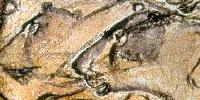
Index of caves and rock shelters with wall paintings and engravings
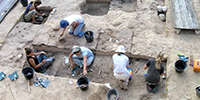 The Acheulian is named after the eponymous site of Saint Acheul. There are a series of sites in the lower Somme valley of Pleistocene deposits containing the distinctive large hand axes of the period. These artefacts were in terraces which resulted from alternating cycles of stream deposition and down-cutting allied to changes in climate and sea level that accompanied the alternating glacial and interglacial stages of Pleistocene times. These deposits attracted early researchers, who found not just the hand axes, but also the bones of what were identified as elephants and rhinoceroses.
The Acheulian is named after the eponymous site of Saint Acheul. There are a series of sites in the lower Somme valley of Pleistocene deposits containing the distinctive large hand axes of the period. These artefacts were in terraces which resulted from alternating cycles of stream deposition and down-cutting allied to changes in climate and sea level that accompanied the alternating glacial and interglacial stages of Pleistocene times. These deposits attracted early researchers, who found not just the hand axes, but also the bones of what were identified as elephants and rhinoceroses.
 Afontova Gora - Афонтова Гора is an important site which has cultural ties with Mal'ta and Buret', hundreds of kilometres to the south east. It is on a north flowing river, the Yenisei, Енисея.
The settlement is dated to 20 000 - 18 000 BP, a very cold part of the last ice age, and the northern ice sheet can not have been far away.
Afontova Gora - Афонтова Гора is an important site which has cultural ties with Mal'ta and Buret', hundreds of kilometres to the south east. It is on a north flowing river, the Yenisei, Енисея.
The settlement is dated to 20 000 - 18 000 BP, a very cold part of the last ice age, and the northern ice sheet can not have been far away.
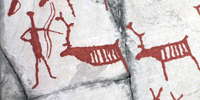
The Rock Drawings of Alta constitute the most important piece of evidence in favour of the existence of human activity in the confines of the Great North during the prehistoric period. Close to the Arctic Circle, they are a valuable illustration of human activity between 6 200 and 2 500 BP in the Northern Hemisphere. They are primordial evidence of the fauna, representing reindeer, elks, bears, dogs and/or wolves, foxes, hares, geese, ducks, swans, cormorants, halibut, salmon and whales, and of the environment. They also depict boating, hunting, trapping and fishing scenes, as well as people taking part in dances and ritual acts.
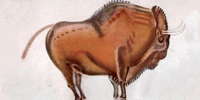 Altamira Cave is 270 metres long and consists of a series of twisting passages and chambers, and is decorated with ice age paintings. The artists used charcoal and ochre or haematite to create the images. They also exploited the natural contours in the cave walls to give their subjects a three-dimensional effect. The Polychrome Ceiling is the most impressive feature of the cave, depicting a herd of extinct Steppe Bison in different poses, two horses, a large doe, and possibly a wild boar. Around 13 000 years ago a rockfall sealed the cave's entrance, preserving its contents until its eventual discovery.
Altamira Cave is 270 metres long and consists of a series of twisting passages and chambers, and is decorated with ice age paintings. The artists used charcoal and ochre or haematite to create the images. They also exploited the natural contours in the cave walls to give their subjects a three-dimensional effect. The Polychrome Ceiling is the most impressive feature of the cave, depicting a herd of extinct Steppe Bison in different poses, two horses, a large doe, and possibly a wild boar. Around 13 000 years ago a rockfall sealed the cave's entrance, preserving its contents until its eventual discovery.
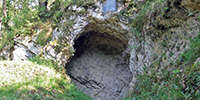 La Grotte d'Aurignac and the Aurignacian - La Grotte d'Aurignac is a cave located in the commune of Aurignac, in Haute-Garonne (Midi-Pyrenees, France). Occupied during the Upper Palaeolithic, it gave its name to the Aurignacian, a prehistoric culture of the beginning of that period.
La Grotte d'Aurignac and the Aurignacian - La Grotte d'Aurignac is a cave located in the commune of Aurignac, in Haute-Garonne (Midi-Pyrenees, France). Occupied during the Upper Palaeolithic, it gave its name to the Aurignacian, a prehistoric culture of the beginning of that period.

Australian Archeology / Archeology sites
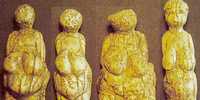
Avdeevo - a Paleolithic site with strong links to Kostenki
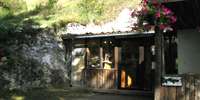 La Grotte de Bara Bahau is an Historic Monument containing Ice Age Cave Art. It is 100 metres long, 12 metres wide, and up to six metres high. There are many scratches on the walls from the Cave Bears which once inhabited this limestone cave. Magdalenian hunters left engravings of horses, bison, deer, aurochs, human hands, a phallus, and bears, as well as signs whose meaning we can only guess at. The cave itself was well known for many years, but the engravings were discovered in April 1951 when the famous caver Norbert Casteret in company with his son Raoul and his daughter explored the cave thoroughly and discovered the Magdalenian engravings. These were authenticated by Henri Breuil in August of that year. Later, in 1955 Father Glory made a thorough examination of the cave, and in 1997 Brigitte and Gilles Delluc published a monograph on the cave.
La Grotte de Bara Bahau is an Historic Monument containing Ice Age Cave Art. It is 100 metres long, 12 metres wide, and up to six metres high. There are many scratches on the walls from the Cave Bears which once inhabited this limestone cave. Magdalenian hunters left engravings of horses, bison, deer, aurochs, human hands, a phallus, and bears, as well as signs whose meaning we can only guess at. The cave itself was well known for many years, but the engravings were discovered in April 1951 when the famous caver Norbert Casteret in company with his son Raoul and his daughter explored the cave thoroughly and discovered the Magdalenian engravings. These were authenticated by Henri Breuil in August of that year. Later, in 1955 Father Glory made a thorough examination of the cave, and in 1997 Brigitte and Gilles Delluc published a monograph on the cave.
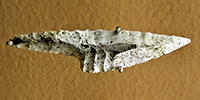 The Badegoulian culture spans the Solutrean and the early Magdalenian, and has been dated to between 19 000 and 17 000 BP. The lithic industry includes laurel leaf points and shouldered points, as well as the small scrapers known as raclettes. Shells for jewellery were obtained from fossil sites, as well as from both Atlantic and Mediterranean beaches. The site of Badegoule is at the base and the extremity of a limestone cliff facing south, on the left bank of a tributary of Le Cern brook. The site may have been a huge living place, covering a large surface on the slope of the present relief, at least 50 m long and 20 m deep.
The Badegoulian culture spans the Solutrean and the early Magdalenian, and has been dated to between 19 000 and 17 000 BP. The lithic industry includes laurel leaf points and shouldered points, as well as the small scrapers known as raclettes. Shells for jewellery were obtained from fossil sites, as well as from both Atlantic and Mediterranean beaches. The site of Badegoule is at the base and the extremity of a limestone cliff facing south, on the left bank of a tributary of Le Cern brook. The site may have been a huge living place, covering a large surface on the slope of the present relief, at least 50 m long and 20 m deep.
 Batavia was a ship of the Dutch East India Company (VOC). It was built in Amsterdam in 1628, and armed with 24 cast-iron cannons and a number of bronze guns. Batavia was shipwrecked on her maiden voyage, and was made famous by the subsequent mutiny and massacre that took place among the survivors. A twentieth-century replica of the ship, also called the Batavia can be visited in Lelystad, Netherlands.
Batavia was a ship of the Dutch East India Company (VOC). It was built in Amsterdam in 1628, and armed with 24 cast-iron cannons and a number of bronze guns. Batavia was shipwrecked on her maiden voyage, and was made famous by the subsequent mutiny and massacre that took place among the survivors. A twentieth-century replica of the ship, also called the Batavia can be visited in Lelystad, Netherlands.
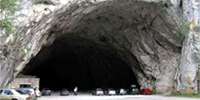 Grotte de Bédeilhac has a huge entrance and was a good shelter for Magdalenian hunters. There are two horizons with human remains.
Important finds include clay sculptures, bone polishers, baguettes demi-ronde, perforated horse teeth and many paintings and engravings on the walls.
Grotte de Bédeilhac has a huge entrance and was a good shelter for Magdalenian hunters. There are two horizons with human remains.
Important finds include clay sculptures, bone polishers, baguettes demi-ronde, perforated horse teeth and many paintings and engravings on the walls.
 Grotte de Bernifal is a cave decorated with over 100 engravings and paintings. It includes engravings of horses, bison, mammoths and ibex as well as the enigmatic tectiform (roof shaped) drawings seen in many other caves of the same period. It has changed very little in more than twelve thousand years, and has not been vandalised, since the original entrance was blocked with rubble when the last artists left.
Grotte de Bernifal is a cave decorated with over 100 engravings and paintings. It includes engravings of horses, bison, mammoths and ibex as well as the enigmatic tectiform (roof shaped) drawings seen in many other caves of the same period. It has changed very little in more than twelve thousand years, and has not been vandalised, since the original entrance was blocked with rubble when the last artists left.
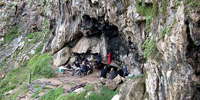 Blombos Cave is on the south coast of South Africa. About 20 square metres of the Middle Stone Age has been excavated to a depth of about 2 metres below the original surface. Dating by the optically stimulated luminescence (OSL) and thermoluminescence (TL) methods has provided occupation dates for each phase: these are about 73 000 BP for the M1 phase, about 80 000 BP for the M2 phase, and between 100 000 and 140 000 BP for the M3 phase. The evidence indicates periods of relatively brief occupation separated by long periods of non-occupation, including a separation between occupation during the Late Stone Age (LSA) and the Middle Stone Age. Bone tools, marine shell beads, and engraved ochre were found in the M1 phase, bone tools in the Upper M2 phase, and considerable quantities of ochre and associated ochre working tools in the M3 phase.
Blombos Cave is on the south coast of South Africa. About 20 square metres of the Middle Stone Age has been excavated to a depth of about 2 metres below the original surface. Dating by the optically stimulated luminescence (OSL) and thermoluminescence (TL) methods has provided occupation dates for each phase: these are about 73 000 BP for the M1 phase, about 80 000 BP for the M2 phase, and between 100 000 and 140 000 BP for the M3 phase. The evidence indicates periods of relatively brief occupation separated by long periods of non-occupation, including a separation between occupation during the Late Stone Age (LSA) and the Middle Stone Age. Bone tools, marine shell beads, and engraved ochre were found in the M1 phase, bone tools in the Upper M2 phase, and considerable quantities of ochre and associated ochre working tools in the M3 phase.
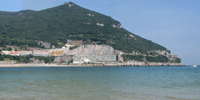
Monte Buciero has around 20 caves and small abris or rock shelters. Human occupation is known in at least seven of these caves. Engravings have been found in two of them - Peña del Perro and Cueva de San Carlos, also known as Cueva del Fortín.
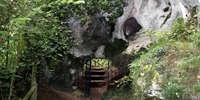 El Buxu Cave was discovered by chance in December 1916 by Cesáreo Cardin, an habitual collaborator in the archaeological digs of Hugo Obermaier and Conde de la Vega del Sella. The entrance is formed by an outer vestibule six metres wide and five metres deep, facing south-west. The original rock-shelter, however, was much larger, as is shown by the presence of numerous blocks of limestone which have collapsed from the roof, and the remains of a former floor, partially eroded away. This former rock-shelter would have faced south, situated 300 metres above present-day sea level, and 25 metres above the valley floor.
El Buxu Cave was discovered by chance in December 1916 by Cesáreo Cardin, an habitual collaborator in the archaeological digs of Hugo Obermaier and Conde de la Vega del Sella. The entrance is formed by an outer vestibule six metres wide and five metres deep, facing south-west. The original rock-shelter, however, was much larger, as is shown by the presence of numerous blocks of limestone which have collapsed from the roof, and the remains of a former floor, partially eroded away. This former rock-shelter would have faced south, situated 300 metres above present-day sea level, and 25 metres above the valley floor.
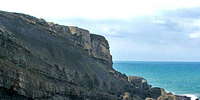 Caves and Rock Shelters on the North coast of Spain, including Cantabria and the caves and rock shelters of Mount Buciero, Covalanas Cave, and El Mirón.
Caves and Rock Shelters on the North coast of Spain, including Cantabria and the caves and rock shelters of Mount Buciero, Covalanas Cave, and El Mirón.
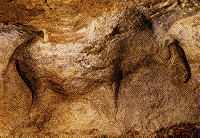 L'Abri du Cap Blanc - Over 15 000 years ago, Ice Age hunters carved horses, bison and reindeer, some of which are over two metres long, straight into the Limestone cliffs at Cap Blanc. The abri, which was discovered in 1909, is today the only frieze of prehistoric sculptures in the world to be shown to the public.
L'Abri du Cap Blanc - Over 15 000 years ago, Ice Age hunters carved horses, bison and reindeer, some of which are over two metres long, straight into the Limestone cliffs at Cap Blanc. The abri, which was discovered in 1909, is today the only frieze of prehistoric sculptures in the world to be shown to the public.
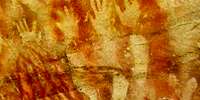 Carnarvon Gorge - an Aboriginal Rock Stencil Art site, with engravings of vulvas, emu and kangaroo tracks.
Carnarvon Gorge - an Aboriginal Rock Stencil Art site, with engravings of vulvas, emu and kangaroo tracks.
Carnarvon Gorge lies within the spectacular and rugged ranges of Queensland's central highlands. The fragile aboriginal art on the gorge's sandstone walls reflects a rich culture. Ochre stencils of tools, weapons, ornaments and ceremonial objects, as well as engravings and grooves where tools were sharpened provide an insight into the lives of the gorge's first people.
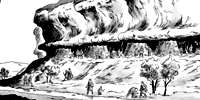 The site of Castel-Merle is also known as Vallon des Roches, and is located near the town of Sergeac on the Vézère River between Lascaux and the shelter of Moustier, near Les Eyzies-de-Tayac . This prehistoric site has the distinction of having its own museum where there are many artefacts from the various excavations of rock shelters, with six necklaces dating from the Aurignacian and Magdalenian (among the oldest in Europe). the Vallon des Roches has a unique geological formation. It consists of high parallel cliffs closer than 100 metres and comprising six shelters spread over 400 metres, giving one of the highest concentrations of prehistoric settlements of Aquitaine. The overhanging parts of these shelters have collapsed, mainly towards the end of the last glaciation, and thus ensured very good protection for the archaeological layers.
The site of Castel-Merle is also known as Vallon des Roches, and is located near the town of Sergeac on the Vézère River between Lascaux and the shelter of Moustier, near Les Eyzies-de-Tayac . This prehistoric site has the distinction of having its own museum where there are many artefacts from the various excavations of rock shelters, with six necklaces dating from the Aurignacian and Magdalenian (among the oldest in Europe). the Vallon des Roches has a unique geological formation. It consists of high parallel cliffs closer than 100 metres and comprising six shelters spread over 400 metres, giving one of the highest concentrations of prehistoric settlements of Aquitaine. The overhanging parts of these shelters have collapsed, mainly towards the end of the last glaciation, and thus ensured very good protection for the archaeological layers.
 The Cueva de El Castillo, or the Cave of the Castle, is an archaeological site within the complex of the Caves of Monte Castillo, and is located in Puente Viesgo, in the province of Cantabria, Spain.
This cave was discovered in 1903 by Hermilio Alcalde del Río, the Spanish archaeologist, who was one of the pioneers in the study of the earliest cave paintings of Cantabria. In the time of the cave painters, the entrance to the cave was not as large as it is today, because it was enlarged by the excavations in the front of the caves. By way of the entrance one can access the different rooms in which Alcalde del Río found an extensive sequence of images. The paintings and other markings span from the Lower Palaeolithic to the Bronze Age, and even into the Middle Ages. There are over 150 figures already catalogued, including engravings of deer, complete with shadowing.
The Cueva de El Castillo, or the Cave of the Castle, is an archaeological site within the complex of the Caves of Monte Castillo, and is located in Puente Viesgo, in the province of Cantabria, Spain.
This cave was discovered in 1903 by Hermilio Alcalde del Río, the Spanish archaeologist, who was one of the pioneers in the study of the earliest cave paintings of Cantabria. In the time of the cave painters, the entrance to the cave was not as large as it is today, because it was enlarged by the excavations in the front of the caves. By way of the entrance one can access the different rooms in which Alcalde del Río found an extensive sequence of images. The paintings and other markings span from the Lower Palaeolithic to the Bronze Age, and even into the Middle Ages. There are over 150 figures already catalogued, including engravings of deer, complete with shadowing.
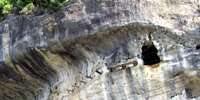 The Roc de Cazelle has been inhabited since prehistoric times, and the 25 000 year old Venus of Sereuil was found close by. It has been occupied almost continuously since. In the Middle Ages many of the caves were deepened and turned into strongholds during the wars of that time. In recent times the lower caverns were used as dwellings for farm owners and their staff, and the whole area has now been turned into displays for tourists to see how their ancestors lived.
The Roc de Cazelle has been inhabited since prehistoric times, and the 25 000 year old Venus of Sereuil was found close by. It has been occupied almost continuously since. In the Middle Ages many of the caves were deepened and turned into strongholds during the wars of that time. In recent times the lower caverns were used as dwellings for farm owners and their staff, and the whole area has now been turned into displays for tourists to see how their ancestors lived.
 The Cycladic culture flourished in the islands of the Aegean Sea from circa 3 300 - 1 100 BC. Cycladic art comprises one of the three main branches of Aegean art. The best known type of artwork that has survived is the marble figurine, most commonly a single full-length female figure with arms folded across the front. Apart from a sharply-defined nose, the faces are a smooth blank, although there is evidence on some that they were originally painted.
The Cycladic culture flourished in the islands of the Aegean Sea from circa 3 300 - 1 100 BC. Cycladic art comprises one of the three main branches of Aegean art. The best known type of artwork that has survived is the marble figurine, most commonly a single full-length female figure with arms folded across the front. Apart from a sharply-defined nose, the faces are a smooth blank, although there is evidence on some that they were originally painted.
 When Neandertals were first described on the basis of skeletons found in the Neander Valley in Germany, they were presented as not quite human. Steadily, evidence has grown that Neandertals had most of the cultural abilities of anatomically modern humans. What has been missing up until now is evidence of their artistic ability, in particular art on the walls of caves, such as is much in evidence for anatomically modern humans, such as those from the Magdalenian. Finally this lack has been rectified, with discoveries of Neandertal paintings in three separate caves in Spain.
When Neandertals were first described on the basis of skeletons found in the Neander Valley in Germany, they were presented as not quite human. Steadily, evidence has grown that Neandertals had most of the cultural abilities of anatomically modern humans. What has been missing up until now is evidence of their artistic ability, in particular art on the walls of caves, such as is much in evidence for anatomically modern humans, such as those from the Magdalenian. Finally this lack has been rectified, with discoveries of Neandertal paintings in three separate caves in Spain.
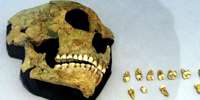 St Césaire Neanderthal Skeleton
St Césaire Neanderthal Skeleton
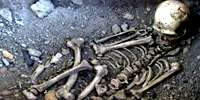 The Neandertal skeleton from La Chapelle-aux-Saints
The Neandertal skeleton from La Chapelle-aux-Saints
 Chauvet Cave in the valley of the Ardèche River in France is filled with paintings, engravings and drawings created more than 30 000 years ago, of cave lions, mammoths, rhinos, bison, cave bears and horses. It contains the earliest known cave paintings, as well as other evidence of Upper Paleolithic life. It is situated on a limestone cliff above the former bed of the Ardèche River. The later Gravettian occupation, which occurred 25 000 to 27 000 years ago, left little but a child's footprints, the charred remains of ancient hearths and carbon smoke stains from torches that lit the caves. After the child's visit to the cave, evidence suggests that the cave had been untouched until discovered in 1994. The footprints may be the oldest human footprints that can be dated accurately
Chauvet Cave in the valley of the Ardèche River in France is filled with paintings, engravings and drawings created more than 30 000 years ago, of cave lions, mammoths, rhinos, bison, cave bears and horses. It contains the earliest known cave paintings, as well as other evidence of Upper Paleolithic life. It is situated on a limestone cliff above the former bed of the Ardèche River. The later Gravettian occupation, which occurred 25 000 to 27 000 years ago, left little but a child's footprints, the charred remains of ancient hearths and carbon smoke stains from torches that lit the caves. After the child's visit to the cave, evidence suggests that the cave had been untouched until discovered in 1994. The footprints may be the oldest human footprints that can be dated accurately
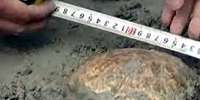
80 000 to 100 000 years old hominin skull found in China
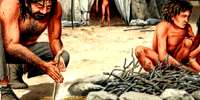
The Côa Valley in Portugal
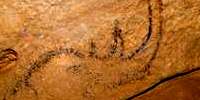
The oldest cave paintings in Central Europe, estimated at between 23 000 and 35 000 BP, have been discovered by a team of Romanian speleologists at the Coliboaia Cave, Romania.
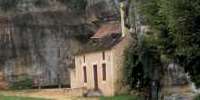 Les Combarelles in the Dordogne, with more than 600 images on its walls, most of them engraved, is considered to be one of the major sanctuaries of Magdalenian culture. This extraordinary site was discovered in 1901. Beyond the entrance of the cave two galleries diverge. The largest one, now open to the public, is a narrow and winding passage, following a zig zag pattern for more than 240 metres. The animals represented are finely engraved. A diverse fauna is represented, including horses, reindeer, ibex, mammoths, rhinoceros, bears, lions and a few bisons and aurochs.
Les Combarelles in the Dordogne, with more than 600 images on its walls, most of them engraved, is considered to be one of the major sanctuaries of Magdalenian culture. This extraordinary site was discovered in 1901. Beyond the entrance of the cave two galleries diverge. The largest one, now open to the public, is a narrow and winding passage, following a zig zag pattern for more than 240 metres. The animals represented are finely engraved. A diverse fauna is represented, including horses, reindeer, ibex, mammoths, rhinoceros, bears, lions and a few bisons and aurochs.
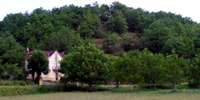
Combe-Capelle, a Neanderthal site in Southern France
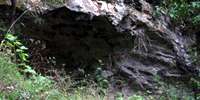
Combe Grenal - a Neanderthal (and earlier) site in the Dordogne valley, France
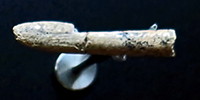 The site of Combe Saunière consists of an ensemble of caves, the principal one containing a long sequence of Middle and Upper Palaeolithic deposits. The cave is situated in an open environment with small valleys and a few low cliffs with habitable caves dispersed along the river edges. The Solutrean levels are dated to approximately 19 000 BP. The oldest known propulseur or spear thrower, dating from the upper Solutrean, was discovered in layer 4 of Combe-Saunière.
The site of Combe Saunière consists of an ensemble of caves, the principal one containing a long sequence of Middle and Upper Palaeolithic deposits. The cave is situated in an open environment with small valleys and a few low cliffs with habitable caves dispersed along the river edges. The Solutrean levels are dated to approximately 19 000 BP. The oldest known propulseur or spear thrower, dating from the upper Solutrean, was discovered in layer 4 of Combe-Saunière.
 La Cotte de St Brelade is a Neandertal site in St Brelade, Jersey. Neanderthals lived there from around 238 000 years ago until between 100 000 and 40 000 years ago - making it the earliest known the occupation of the Channel Islands by a hominin species, and also possibly one of the last Neanderthal sites in northwestern Europe. At that time, with sea levels below those at present, Jersey was part of Normandy, a peninsula jutting out from the coast. After the last Ice Age the sea rose again, separating Jersey from the mainland.
La Cotte de St Brelade is a Neandertal site in St Brelade, Jersey. Neanderthals lived there from around 238 000 years ago until between 100 000 and 40 000 years ago - making it the earliest known the occupation of the Channel Islands by a hominin species, and also possibly one of the last Neanderthal sites in northwestern Europe. At that time, with sea levels below those at present, Jersey was part of Normandy, a peninsula jutting out from the coast. After the last Ice Age the sea rose again, separating Jersey from the mainland.
 The Grottes de Cougnac caves are near Gourdon, Lot. The site consists of two caves separated by 200 metres. The first contains many concretions, some very fine, called soda straws. The second is a decorated cave from the Paleolithic. The cave has many prehistoric paintings dated to the upper Paleolithic. Depictions include deer, megaloceros, the ibex, and mammoths as well as various schematic human figures. The paintings corresponded to at least two clearly distinct phases: one around 25 000 BP, the other about 14 000 years before the present.
The Grottes de Cougnac caves are near Gourdon, Lot. The site consists of two caves separated by 200 metres. The first contains many concretions, some very fine, called soda straws. The second is a decorated cave from the Paleolithic. The cave has many prehistoric paintings dated to the upper Paleolithic. Depictions include deer, megaloceros, the ibex, and mammoths as well as various schematic human figures. The paintings corresponded to at least two clearly distinct phases: one around 25 000 BP, the other about 14 000 years before the present.
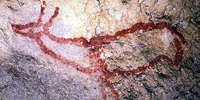 Covalanas cave in Cantabria, Spain, was first discovered to have art work in 1903. It is situated on the South-Western hillside of Pando mountain, near the cave of el Míron. Although the entrance is not huge, access is easy. From the entrance two galleries continue, though only one of them has palaeolithic decoration. In a deep zone of the gallery, and in a space less than 12 metres in length, the largest group of art in the cave is located. It has 22 figures, of which 18 are hinds, a characteristic animal in the Cantabrian decorated caves, as well as a horse, a reindeer and an aurochs. The paintings are between 20 000 and 14 400 years old.
Covalanas cave in Cantabria, Spain, was first discovered to have art work in 1903. It is situated on the South-Western hillside of Pando mountain, near the cave of el Míron. Although the entrance is not huge, access is easy. From the entrance two galleries continue, though only one of them has palaeolithic decoration. In a deep zone of the gallery, and in a space less than 12 metres in length, the largest group of art in the cave is located. It has 22 figures, of which 18 are hinds, a characteristic animal in the Cantabrian decorated caves, as well as a horse, a reindeer and an aurochs. The paintings are between 20 000 and 14 400 years old.
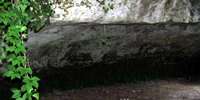
The Cro-Magnon Shelter
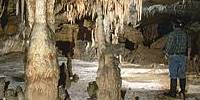 The Grotte de Cussac contains over 150 Paleolithic artworks as well as several human remains. It was discovered on September 30, 2000 by amateur speleologist Marc Delluc. It is closed to the public. The cave's artworks are almost exclusively engravings, often very large, made with stone tools on the walls, or with fingers on clay. At least five people, four adults and a teenager, were deposited in the cavities, with bones dated by Carbon 14 measurements to approximately 25 000 years in age.
The Grotte de Cussac contains over 150 Paleolithic artworks as well as several human remains. It was discovered on September 30, 2000 by amateur speleologist Marc Delluc. It is closed to the public. The cave's artworks are almost exclusively engravings, often very large, made with stone tools on the walls, or with fingers on clay. At least five people, four adults and a teenager, were deposited in the cavities, with bones dated by Carbon 14 measurements to approximately 25 000 years in age.
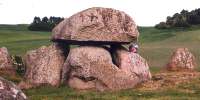
Burial Mounds in Denmark
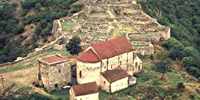
The Homo Erectus site at Dmanisi
 Dolni Vestonice is an ice age mammoth hunters site in the Czech Republic near the town of Brno, in Sudmären - Southern Moravia. Dolni Vestonice I is the original site, where a kiln and pottery figures were found. Dolni Vestonice II is the site where a triple burial of three teenagers was discovered. Dolni Vestonice III is between these two, and has yielded so far tools and bone fragments.
Dolni Vestonice is an ice age mammoth hunters site in the Czech Republic near the town of Brno, in Sudmären - Southern Moravia. Dolni Vestonice I is the original site, where a kiln and pottery figures were found. Dolni Vestonice II is the site where a triple burial of three teenagers was discovered. Dolni Vestonice III is between these two, and has yielded so far tools and bone fragments.
 The complex of Gravettian stations near Milovice lies in a side valley without a view of the Dyje (Thaya) River, aside from the main settlement area, below Pálava. The stations are part of the complex including Pavlov and Dolní Věstonice. The site is notable for the huge amount of accumulated bones of mammoths for which the valley provided extremely suitable conditions for hunting.
The complex of Gravettian stations near Milovice lies in a side valley without a view of the Dyje (Thaya) River, aside from the main settlement area, below Pálava. The stations are part of the complex including Pavlov and Dolní Věstonice. The site is notable for the huge amount of accumulated bones of mammoths for which the valley provided extremely suitable conditions for hunting.

The Dordogne - scene for Book 5, Shelters of Stone. Scenes from the Dordogne, cooking Clan style - preparation of ptarmigan, and using a firestone to make a fire. Photos courtesy Sharon Rogers/walkhound
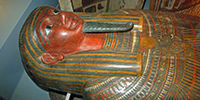 Ancient Egyptian culture from its beginnings through the dynasties to the Ptolemaic period and its eventual decline as a Roman Province, told through reference to its mummies, statues, burial practices and artefacts.
Ancient Egyptian culture from its beginnings through the dynasties to the Ptolemaic period and its eventual decline as a Roman Province, told through reference to its mummies, statues, burial practices and artefacts.
 La Grotte d'Enlène, 200 metres long, is the longest known Volp cave, and was the subject of numerous excavations during the second half of the nineteenth century until the Second World War. However, it has long been ignored because the main findings of movable art that were made there have always been attributed to lesTrois Frères, with which it communicates by a narrow passage. However, one of the major interests of Enlène is that it is a cave-habitat with a high occupancy rate during the Magdalenian IV, while Les Trois-Frères was a cave-shrine and has never been used as a habitat, at least in the long term and delivered little movable art remains.
La Grotte d'Enlène, 200 metres long, is the longest known Volp cave, and was the subject of numerous excavations during the second half of the nineteenth century until the Second World War. However, it has long been ignored because the main findings of movable art that were made there have always been attributed to lesTrois Frères, with which it communicates by a narrow passage. However, one of the major interests of Enlène is that it is a cave-habitat with a high occupancy rate during the Magdalenian IV, while Les Trois-Frères was a cave-shrine and has never been used as a habitat, at least in the long term and delivered little movable art remains.
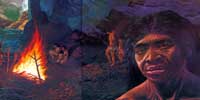
Homo erectus (Beijing Man, Peking Man) sites
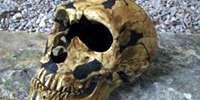
La Ferrassie rock shelter yielded skeletons from eight Neanderthal individuals, including adults, children, infants, and two fetuses. Today the skeleton of La Ferrassie 1 is considered the classic example of Neanderthal anatomy. It was unearthed on 17th September 1909 by R. Capitan and D. Peyrony
 Homo floresiensis was a one metre tall, human-like creature living and using tools in Indonesia just 18 000 years ago and was a distinct species, not just a malformed modern human. The so-called hobbit had wrist bones almost identical to those found in early hominins and modern chimpanzees, and so must have diverged from the human lineage well before modern humans and Neanderthals arose.
Homo floresiensis was a one metre tall, human-like creature living and using tools in Indonesia just 18 000 years ago and was a distinct species, not just a malformed modern human. The so-called hobbit had wrist bones almost identical to those found in early hominins and modern chimpanzees, and so must have diverged from the human lineage well before modern humans and Neanderthals arose.
 Several teeth from an adult and children, and the fossilised mandible of a diminutive species of early human that lived 700 000 years ago have been discovered on the Indonesian island of Flores. It is thought to be the direct ancestor of the Hobbit of Flores, the 1.1 metre tall human species that lived around 50 000 years ago.
Several teeth from an adult and children, and the fossilised mandible of a diminutive species of early human that lived 700 000 years ago have been discovered on the Indonesian island of Flores. It is thought to be the direct ancestor of the Hobbit of Flores, the 1.1 metre tall human species that lived around 50 000 years ago.
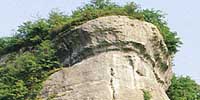 Font-de-Gaume is a cave near Les Eyzies. The cave contains prehistoric polychrome cave paintings and engravings. The paintings were discovered by Denis Peyrony, a local schoolmaster, on 12 September 1901. The cave had been known to the general public before this, but the significance of the paintings had not been recognised. The paintings in the cave at Font-de-Gaume were the first to be discovered in the Périgord province. Prehistoric people living in the Dordogne Valley first settled in the mouth of Font-de-Gaume around 25 000 BC. The cave mouth was inhabited at least sporadically for the next several thousand years. The paintings date from around 17 000 BC, during the Magdalenian period. Many of the cave's paintings have been discovered in recent decades. The cave's most famous painting, a frieze of five bison was discovered accidentally in 1966 while scientists were cleaning the cave.
Font-de-Gaume is a cave near Les Eyzies. The cave contains prehistoric polychrome cave paintings and engravings. The paintings were discovered by Denis Peyrony, a local schoolmaster, on 12 September 1901. The cave had been known to the general public before this, but the significance of the paintings had not been recognised. The paintings in the cave at Font-de-Gaume were the first to be discovered in the Périgord province. Prehistoric people living in the Dordogne Valley first settled in the mouth of Font-de-Gaume around 25 000 BC. The cave mouth was inhabited at least sporadically for the next several thousand years. The paintings date from around 17 000 BC, during the Magdalenian period. Many of the cave's paintings have been discovered in recent decades. The cave's most famous painting, a frieze of five bison was discovered accidentally in 1966 while scientists were cleaning the cave.
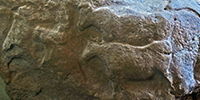 Fourneau du Diable is a prominent cliff face on the road leading to the east from the village of Bourdeilles, beside the river Dronne. It was once a settlement in the late Solutrean, and lithic and bone industries from that time were excavated there, but the most important discovery was of a large limestone block with several well executed sculptures of aurochs carved on its face.
Fourneau du Diable is a prominent cliff face on the road leading to the east from the village of Bourdeilles, beside the river Dronne. It was once a settlement in the late Solutrean, and lithic and bone industries from that time were excavated there, but the most important discovery was of a large limestone block with several well executed sculptures of aurochs carved on its face.
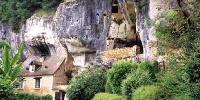
French and Spanish Caves and Rock Shelters

Grottes et Abris-sous-Roche Français et Espagnols
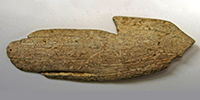 La grotte des Fées is located in the Moron valley near the cave of Pair-non-Pair. It is a small cave that has its opening at the top of a limestone cliff. F. Daleau undertook extensive excavations there and collected a handsome middle and upper Magdalenian lithic industry as well as faunal remains. The Roc de Marcamps was discovered just below the prehistoric cave of la grotte des Fées. It is a Magdalenien archaeological site. Both these sites are very close to the cave of Pair-non-Pair.
La grotte des Fées is located in the Moron valley near the cave of Pair-non-Pair. It is a small cave that has its opening at the top of a limestone cliff. F. Daleau undertook extensive excavations there and collected a handsome middle and upper Magdalenian lithic industry as well as faunal remains. The Roc de Marcamps was discovered just below the prehistoric cave of la grotte des Fées. It is a Magdalenien archaeological site. Both these sites are very close to the cave of Pair-non-Pair.
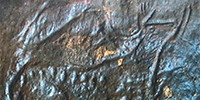 The small Grotte de la Forêt lies between Moustier and Tursac. It is at the junction of the valley of Fontpeyrine and the Vézère, between the cliffs of Reignac upstream and Lespinasse downstream. It houses a magnificently engraved reindeer, with its head erect, the antlers thrown backwards, the limbs in vertical extension. Details abound: eye underlined with a curved line, lower lip slightly turned down, nostrils, punctuated flank, as well as an abundant mane shown by parallel streaks, attributes of a male subject.
The small Grotte de la Forêt lies between Moustier and Tursac. It is at the junction of the valley of Fontpeyrine and the Vézère, between the cliffs of Reignac upstream and Lespinasse downstream. It houses a magnificently engraved reindeer, with its head erect, the antlers thrown backwards, the limbs in vertical extension. Details abound: eye underlined with a curved line, lower lip slightly turned down, nostrils, punctuated flank, as well as an abundant mane shown by parallel streaks, attributes of a male subject.
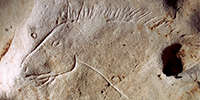 The 200 engravings of the narrow Grotte de Gabillou, discovered in 1941, indicate a Magdalenian age. It is located in the valley of l'Isle, near Mussidan, France. The cave is in a sandy Maastrichtian limestone. Its northwestern end, once expanded by man and used as a storeroom, is obscured by a building. It was discovered in 1941 by M. Charmarty and M. Truffier.
The 200 engravings of the narrow Grotte de Gabillou, discovered in 1941, indicate a Magdalenian age. It is located in the valley of l'Isle, near Mussidan, France. The cave is in a sandy Maastrichtian limestone. Its northwestern end, once expanded by man and used as a storeroom, is obscured by a building. It was discovered in 1941 by M. Charmarty and M. Truffier.
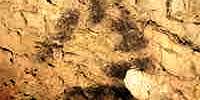
The cave art of Grotte de Gargas constitutes one of the most moving revelations today of the life and thoughts of our prehistoric ancestors. It is made up of two very important elements - painted hands, many apparently mutilated, as well as important animal engravings and paintings.
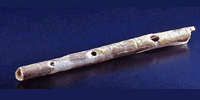 The Site of Geissenklösterle, Hohle Fels, and Middle Paleolithic sites in the Swabian Alb near the city of Ulm - important areas of ice age art occurred near Ulm (Germany), in the Schwaebische Alb, in the valleys of the Ach and Blau river near Blaubeuren, where the famous lion/human figure was found in the Hohlenstein-Stadel cave. A number of world-wide famous caves, such as the Geissenklösterle, Brillenhöhle ('spectacle cave'), Grosse Grotte (great cave), Sirgenstein and Hohle Fels cave, can be reached from Blaubeuren on a labelled hiking path and are easily accessible from the important Museum für Ur-und Frühgeschichte which displays the earliest known flutes.
The Site of Geissenklösterle, Hohle Fels, and Middle Paleolithic sites in the Swabian Alb near the city of Ulm - important areas of ice age art occurred near Ulm (Germany), in the Schwaebische Alb, in the valleys of the Ach and Blau river near Blaubeuren, where the famous lion/human figure was found in the Hohlenstein-Stadel cave. A number of world-wide famous caves, such as the Geissenklösterle, Brillenhöhle ('spectacle cave'), Grosse Grotte (great cave), Sirgenstein and Hohle Fels cave, can be reached from Blaubeuren on a labelled hiking path and are easily accessible from the important Museum für Ur-und Frühgeschichte which displays the earliest known flutes.
 Gontsy was the first Upper Palaeolithic site to be found on the central Russian Plain, in 1871, and is the site of a series of mammoth bone huts. Gontsy is located on the right (southern) promontory formed by the second terrace of the Udaï River. The promontory faces north and is bordered today, as it was at the time of occupation, by ravines and the floodplain. It has been extremely well researched by Lyudmila Iakovleva and François Djindjian, who have not only described the site in a professional manner, they have done excellent work in teasing out exactly why and how the phenomenon of mammoth bone huts in the Dniepr plain occurred. Their paper entitled L'habitat à cabanes en os de mammouths de Gontsy (Ukraine) is a masterpiece.
Gontsy was the first Upper Palaeolithic site to be found on the central Russian Plain, in 1871, and is the site of a series of mammoth bone huts. Gontsy is located on the right (southern) promontory formed by the second terrace of the Udaï River. The promontory faces north and is bordered today, as it was at the time of occupation, by ravines and the floodplain. It has been extremely well researched by Lyudmila Iakovleva and François Djindjian, who have not only described the site in a professional manner, they have done excellent work in teasing out exactly why and how the phenomenon of mammoth bone huts in the Dniepr plain occurred. Their paper entitled L'habitat à cabanes en os de mammouths de Gontsy (Ukraine) is a masterpiece.
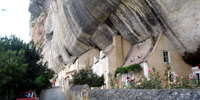
Grotte du Grand Roc is a cave of calcite concretions, with no history of being used by prehistoric people. It is between Laugerie Basse and the Gorge d'Enfer. In 1922, Jean Maury, who was then an archaeologist at Laugerie Basse, noticed a small natural terrace halfway up the great cliff of the Grand Roc. He quickly climbed up to discover a small crack from which came a small spring. Unaware of the origin of this flow, his inquiring mind rapidly imagined that a hidden cavity might reveal the source. After two years of hard work and a last mining foray on April 29, 1924, Jean Maury, his sister and daughter, entered the untouched cave.
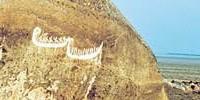
Gobustan on the Caspian Sea
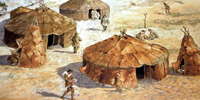 The open-air site of Gönnersdorf was discovered in 1968, during the construction of a cellar for a private house. After digging through the pumice, bones and stone slabs appeared and it became clear that it was a location of the late ice age. A wonderful inventory of ice age life was unearthed: pulverised red hematite, a fireplace, evidence of habitation constructions, a lithic industry, statuettes of ivory and antler, engraved slate plaquettes, jet beads, perforated animal teeth and a well preserved faunal record. Based on these finds it was evident that Gönnersdorf was a site of huge importance.
The open-air site of Gönnersdorf was discovered in 1968, during the construction of a cellar for a private house. After digging through the pumice, bones and stone slabs appeared and it became clear that it was a location of the late ice age. A wonderful inventory of ice age life was unearthed: pulverised red hematite, a fireplace, evidence of habitation constructions, a lithic industry, statuettes of ivory and antler, engraved slate plaquettes, jet beads, perforated animal teeth and a well preserved faunal record. Based on these finds it was evident that Gönnersdorf was a site of huge importance.
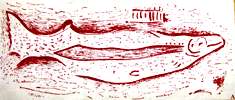
The Gorge d'Enfer is on the right bank of the Vézère River near Les Eyzies-de-Tayac, and contains L'Abri Poisson. The shelter was discovered in 1892 by Paul Girod, and dates from the Aurignacian. In 1912 Jean Marsan identified the fish carved in the ceiling of a small abri that made the site famous.
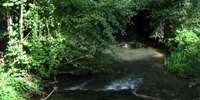
La Gravette, the type site for the Gravettian - The Gravettian toolmaking culture is named after the type site of La Gravette in the Dordogne region of France where its characteristic tools were first found and studied. It dates from between 28 000 and 22 000 years ago. Artistic achievements of the Gravettian cultural stage include the hundreds of Venus figurines, which are widely distributed in Europe.
 Maarten Perdeck has collected more than 8 000 pieces of worked flint and 300 retouched tools on a Hamburgian site in the Netherlands, an upper palaeolithic reindeer hunter site from the end of the Weichselien. The tools reflect the type of the site, a camp for reindeer hunters, and consist mostly of scrapers, chisels, and drilling tools. The artefacts have been superbly photographed by Christophe Brochard. These superb specimens are mute testimony to the lives of the reindeer hunters who used the site many thousands of years ago, at a time when the ice caps were not far away from the Netherlands, where these pieces were were found in a ploughed field over a period of twenty years.
Maarten Perdeck has collected more than 8 000 pieces of worked flint and 300 retouched tools on a Hamburgian site in the Netherlands, an upper palaeolithic reindeer hunter site from the end of the Weichselien. The tools reflect the type of the site, a camp for reindeer hunters, and consist mostly of scrapers, chisels, and drilling tools. The artefacts have been superbly photographed by Christophe Brochard. These superb specimens are mute testimony to the lives of the reindeer hunters who used the site many thousands of years ago, at a time when the ice caps were not far away from the Netherlands, where these pieces were were found in a ploughed field over a period of twenty years.
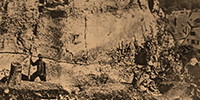 Heidenschmiede - below the castle in Heidenheim, the rock face 35 metres above the valley floor forms a small overhang just large enough to create an 8 square metre abri, or rock shelter. In spite of its small size, this rock shelter was a place our ancestors went to time and again. This may have been because of the splendid view across the wide, open valley of the Brenz River, which provided an excellent hunting ground.
Heidenschmiede - below the castle in Heidenheim, the rock face 35 metres above the valley floor forms a small overhang just large enough to create an 8 square metre abri, or rock shelter. In spite of its small size, this rock shelter was a place our ancestors went to time and again. This may have been because of the splendid view across the wide, open valley of the Brenz River, which provided an excellent hunting ground.
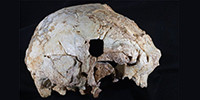 The recently found oldest fossil human cranium in Portugal marks an important contribution to the knowledge of human evolution during the middle Pleistocene in Europe and to the origin of the Neandertals. This cranium of Homo heidelbergensis represents the westernmost human fossil ever found in Europe during the middle Pleistocene epoch and one of the earliest on this continent to be associated with the Acheulean stone tool industry.
The recently found oldest fossil human cranium in Portugal marks an important contribution to the knowledge of human evolution during the middle Pleistocene in Europe and to the origin of the Neandertals. This cranium of Homo heidelbergensis represents the westernmost human fossil ever found in Europe during the middle Pleistocene epoch and one of the earliest on this continent to be associated with the Acheulean stone tool industry.
 Homo heidelbergensis is an extinct species of the genus Homo which lived in Africa, Europe and western Asia from at least 600 000 years ago, and may date back 1 300 000 years. It survived until 200 000 to 250 000 years ago. It is probably the ancestor of Homo sapiens in Africa and the Neanderthals in Europe, and perhaps also the Denisovans in Asia. It was first discovered near Heidelberg in Germany in 1907 and named by Otto Schoetensack. Some experts believe that H. heidelbergensis, like its descendant H. neandertalensis, acquired a primitive form of language. No forms of art or sophisticated artefacts other than stone tools have been uncovered, although red ochre, a mineral that can be used to create a red pigment which is useful as a paint, has been found at Terra Amata excavations in the south of France.
Homo heidelbergensis is an extinct species of the genus Homo which lived in Africa, Europe and western Asia from at least 600 000 years ago, and may date back 1 300 000 years. It survived until 200 000 to 250 000 years ago. It is probably the ancestor of Homo sapiens in Africa and the Neanderthals in Europe, and perhaps also the Denisovans in Asia. It was first discovered near Heidelberg in Germany in 1907 and named by Otto Schoetensack. Some experts believe that H. heidelbergensis, like its descendant H. neandertalensis, acquired a primitive form of language. No forms of art or sophisticated artefacts other than stone tools have been uncovered, although red ochre, a mineral that can be used to create a red pigment which is useful as a paint, has been found at Terra Amata excavations in the south of France.
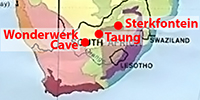 Hominid sites in Africa and nearby regions. This is a useful tool for forming an overall understanding of hominids from Africa, including Homo sapiens.
Hominid sites in Africa and nearby regions. This is a useful tool for forming an overall understanding of hominids from Africa, including Homo sapiens.
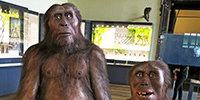 This is an overview of all the hominin species (ancestors of humans), including Homo sapiens, collected together in one place, arranged in approximate age. It is meant to be a short introduction to each of these hominins, in order, to give the reader the overall picture of the evolution of hominins.
This is an overview of all the hominin species (ancestors of humans), including Homo sapiens, collected together in one place, arranged in approximate age. It is meant to be a short introduction to each of these hominins, in order, to give the reader the overall picture of the evolution of hominins.
 The Middle Stone Age grave of a three year old Homo sapiens child who lived 78 000 years ago has been found in a cave in Kenya. Researchers who studied the fragile, ancient remains described how its head appeared to have been laid on a pillow. Scientists have named the child Mtoto, meaning 'child' in Swahili.
The Middle Stone Age grave of a three year old Homo sapiens child who lived 78 000 years ago has been found in a cave in Kenya. Researchers who studied the fragile, ancient remains described how its head appeared to have been laid on a pillow. Scientists have named the child Mtoto, meaning 'child' in Swahili.

Ice age hunters of Northern Europe, hunting reindeer and elk as well as utilising other food and shelter resources, moved into the periglacial tundras after the last Glacial Maximum, ca 20 000 BP.
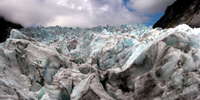 Ice Age maps: The Causes of the end of the last Ice Age: The last great ice age began around 120 000 years ago. One massive ice sheet, more than 3 kilometres thick in places, grew in fits and starts until it covered almost all of Canada and stretched down as far as Manhattan. Then, 20 000 years ago, a great thaw began. Over the following 10 000 years, the average global temperature rose by 3.5° C and most of the ice melted. Rising seas swallowed up low-lying areas such as the English Channel and North Sea, forcing our ancestors to abandon many settlements.
Ice Age maps: The Causes of the end of the last Ice Age: The last great ice age began around 120 000 years ago. One massive ice sheet, more than 3 kilometres thick in places, grew in fits and starts until it covered almost all of Canada and stretched down as far as Manhattan. Then, 20 000 years ago, a great thaw began. Over the following 10 000 years, the average global temperature rose by 3.5° C and most of the ice melted. Rising seas swallowed up low-lying areas such as the English Channel and North Sea, forcing our ancestors to abandon many settlements.
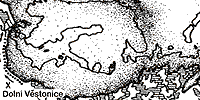
Ice Age maps: Go to the maps of the extent of the ice in the last ice age. A set of maps illustrate how the last British ice sheet shrunk during the Ice Age. The unique maps record the pattern and speed of shrinkage of the large ice sheet that covered the British Isles during the last Ice Age, approximately 20 000 years ago. The sheet, which subsumed most of Britain, Ireland and the North Sea, had an ice volume sufficient to raise global sea level by around 2.5 metres when it melted.
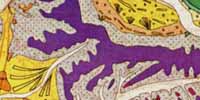
Ice Age maps: Go to the map of the Wurm and Riss Glaciation deposits in the Rhone valley.
Carte dressée par P. Mandier L.A 260 CNRS Lyon
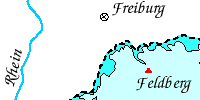
Ice Age maps:
Go to the map of the Wurm and Riss Glaciation in the headwaters of the Donau (Danube)
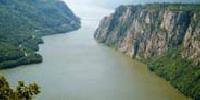
The Iron Gates Gorge, a very important series of mesolithic sites on the Danube
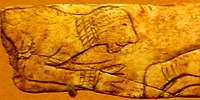 Les Grottes d'Isturitz et d'Oxocelhaya- The Caves of Isturitz and Oxocelhaya date back to the Mousterian, about 80 000 BC, and there is evidence of Neanderthals living there, but occupation extended to almost the end of the ice age in 10 000 BC. It is in the Atlantic Pyrennees region. The network consists of three caves, the upper Isturitz Cave, then 20 metres below, Oxocelhaya Cave with calcite concretions and finally the Erberua cave where the Arberoue river now runs. Isturitz is famous for the discovery of a series of important prehistoric flutes dating from the Upper Paleolithic (Aurignacian to the Magdalenian), about 35 000 to 10 000 BC.
Les Grottes d'Isturitz et d'Oxocelhaya- The Caves of Isturitz and Oxocelhaya date back to the Mousterian, about 80 000 BC, and there is evidence of Neanderthals living there, but occupation extended to almost the end of the ice age in 10 000 BC. It is in the Atlantic Pyrennees region. The network consists of three caves, the upper Isturitz Cave, then 20 metres below, Oxocelhaya Cave with calcite concretions and finally the Erberua cave where the Arberoue river now runs. Isturitz is famous for the discovery of a series of important prehistoric flutes dating from the Upper Paleolithic (Aurignacian to the Magdalenian), about 35 000 to 10 000 BC.
 Kapova Cave is a famous Russian Palaeolithic cave. It has painted mammoths, rhinos, horses and a bison on its walls. The cave has two levels, the paintings are mainly in the upper level at some distance from the entrance. The charcoal was dated with the 14C method to be 14 680 ±150 years old. Among the animal bones were cave bear bones. Kapova Cave is a complex natural monument with multiple grottos and halls connected by passages on various levels. The walls of the cave are rich in calcite deposits of all kinds of forms and sizes. An underground river flows out of the cave and forms the Blue Lake at its entrance.
Kapova Cave is a famous Russian Palaeolithic cave. It has painted mammoths, rhinos, horses and a bison on its walls. The cave has two levels, the paintings are mainly in the upper level at some distance from the entrance. The charcoal was dated with the 14C method to be 14 680 ±150 years old. Among the animal bones were cave bear bones. Kapova Cave is a complex natural monument with multiple grottos and halls connected by passages on various levels. The walls of the cave are rich in calcite deposits of all kinds of forms and sizes. An underground river flows out of the cave and forms the Blue Lake at its entrance.
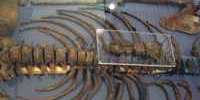 The neanderthal skeleton from Kebara in Israel
The neanderthal skeleton from Kebara in Israel

Kostenki and other sites on the Don River
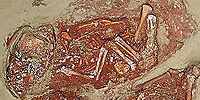
Ice Age Infants - discovered at the Krems-Wachtberg Pavlovian site in Austria on the Danube
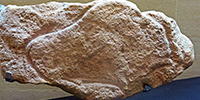 Les Jamblancs is an upper Solutrean / Magdalenian site in the Bayac-Bourniquel area. It is notable for its stone engravings and tool kit. The site consists mainly of the deposits at abris below a cliff, and is important for the study of the old Magdalenian, or Badegoulian. However much of the material remains unpublished.
Les Jamblancs is an upper Solutrean / Magdalenian site in the Bayac-Bourniquel area. It is notable for its stone engravings and tool kit. The site consists mainly of the deposits at abris below a cliff, and is important for the study of the old Magdalenian, or Badegoulian. However much of the material remains unpublished.
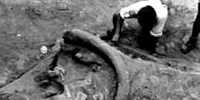
The Krems-Wachtberg Pavlovian mammoth site in Austria on the Danube
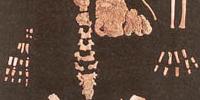 The Lagar Velho Hybrid Child from Portugal - The Lagar Velho site is a rock-shelter in the Lapedo valley, a limestone canyon ca. 140 km north of Lisbon, Portugal. In 1998, the discovery of an early Upper Paleolithic human burial in this site has provided evidence of early modern humans from southern Iberia. The remains, the largely complete skeleton of an approximately 4 year old child buried with pierced shells and red ochre, is dated to ca. 24 500 years B.P. The cranium, mandible, dentition, and postcrania appear to present a mosaic of European early modern human and Neanderthal features.
The Lagar Velho Hybrid Child from Portugal - The Lagar Velho site is a rock-shelter in the Lapedo valley, a limestone canyon ca. 140 km north of Lisbon, Portugal. In 1998, the discovery of an early Upper Paleolithic human burial in this site has provided evidence of early modern humans from southern Iberia. The remains, the largely complete skeleton of an approximately 4 year old child buried with pierced shells and red ochre, is dated to ca. 24 500 years B.P. The cranium, mandible, dentition, and postcrania appear to present a mosaic of European early modern human and Neanderthal features.
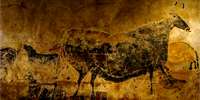 Lascaux Cave is famous for its Paleolithic cave paintings. The paintings are estimated to be 17 300 years old. They primarily consist of images of large animals, most of which are known from fossil evidence to have lived in the area at the time. The cave was discovered on September 12, 1940 by four teenagers. The cave complex was opened to the public in 1948. Rooms in the cave include The Hall of the Bulls, the Passageway, the Shaft, the Nave, the Apse, and the Chamber of Felines. Lascaux II, a replica of two of the cave halls — the Great Hall of the Bulls and the Painted Gallery — was opened in 1983, 200 metres from the original.
Lascaux Cave is famous for its Paleolithic cave paintings. The paintings are estimated to be 17 300 years old. They primarily consist of images of large animals, most of which are known from fossil evidence to have lived in the area at the time. The cave was discovered on September 12, 1940 by four teenagers. The cave complex was opened to the public in 1948. Rooms in the cave include The Hall of the Bulls, the Passageway, the Shaft, the Nave, the Apse, and the Chamber of Felines. Lascaux II, a replica of two of the cave halls — the Great Hall of the Bulls and the Painted Gallery — was opened in 1983, 200 metres from the original.
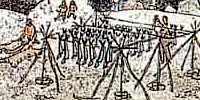
Laugerie Haute
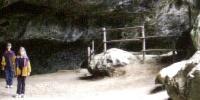
Laugerie Basse
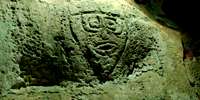 Lene Hara Cave has provided evidence that Timor has been occupied by humans for 35 000 years BP. In May 2009, carved faces were found high in the cave, and have since been dated to 10 000 years. Paintings in the caves of Ile Kére Kére, of which Lene Hara is a part, are believed to be 2 000 to 6 000 years old.
Lene Hara Cave has provided evidence that Timor has been occupied by humans for 35 000 years BP. In May 2009, carved faces were found high in the cave, and have since been dated to 10 000 years. Paintings in the caves of Ile Kére Kére, of which Lene Hara is a part, are believed to be 2 000 to 6 000 years old.
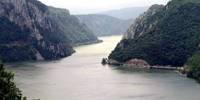
Proto Lepenski Vir and Lepenski Vir Ia - a mesolithic site on the Donau
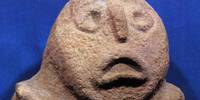
Lepenski Vir Ib-e, II, III - a mesolithic site on the Donau

Liujiang - ancient modern human skull
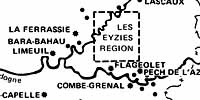
Location Maps and Themes of Cave Paintings
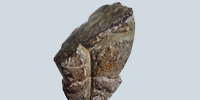 The Linsenberg - Mainz archaeological site occupies a height overlooking the city of Mainz. It is an open air site, and is buried in loess, the archaeological layer lying just above a bed of clay. Around 1920 E. Neeb and O. Schmidtgen collected two fragments of statues made of greenish sandstone, which are kept at the Archaeological Museum in Mainz. The first, with a height of 36 mm, includes only the lower limbs, with feet represented by a blunt point, and part of the pelvis, with the pubic triangle.
The Linsenberg - Mainz archaeological site occupies a height overlooking the city of Mainz. It is an open air site, and is buried in loess, the archaeological layer lying just above a bed of clay. Around 1920 E. Neeb and O. Schmidtgen collected two fragments of statues made of greenish sandstone, which are kept at the Archaeological Museum in Mainz. The first, with a height of 36 mm, includes only the lower limbs, with feet represented by a blunt point, and part of the pelvis, with the pubic triangle.
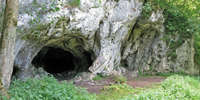 Lonetal Sites, including Neanderthal and Middle Paleolithic sites in the Swabian Alb near the city of Ulm, were important areas of ice age art. The sites occur in the Schwaebische Alb (Swabian Alb), in the valleys of the Ach and Blau river near Blaubeuren, where the famous lion/human figure was found in the Hohlenstein-Stadel cave.
Lonetal Sites, including Neanderthal and Middle Paleolithic sites in the Swabian Alb near the city of Ulm, were important areas of ice age art. The sites occur in the Schwaebische Alb (Swabian Alb), in the valleys of the Ach and Blau river near Blaubeuren, where the famous lion/human figure was found in the Hohlenstein-Stadel cave.
 Lucy, Australopithecus afarensis, is an extinct hominid that lived between 3.9 and 2.9 million years ago. Australopithecus afarensis was slenderly built, like the younger Australopithecus africanus. It is thought that Australopithecus afarensis was more closely related to the genus Homo (which includes the modern human species Homo sapiens ), whether as a direct ancestor or a close relative of an unknown ancestor, than any other known primate from the same time.
Lucy, Australopithecus afarensis, is an extinct hominid that lived between 3.9 and 2.9 million years ago. Australopithecus afarensis was slenderly built, like the younger Australopithecus africanus. It is thought that Australopithecus afarensis was more closely related to the genus Homo (which includes the modern human species Homo sapiens ), whether as a direct ancestor or a close relative of an unknown ancestor, than any other known primate from the same time.

Lucy's baby, Australopithecus afarensis
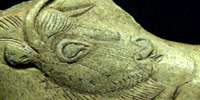
La Madeleine is a rock shelter located in the Vézère valley, in the Dordogne, France. In 1926 the skeleton of a three year old child was discovered, with exquisite shell jewellery, dating from the end of the Magdalenian period. It is a treasure house of art and knowledge about the people of the Magdalenian. Much of this art is on display at the Musée National de Préhistoire, Les Eyzies-de-Tayac.
 The Mal'ta - Buret' venuses and culture in Siberia - the site of Mal'ta, is composed of a series of subterranean houses made of large animal bones and reindeer antler which had likely been covered with animal skins and sod to protect inhabitants from the severe, prevailing northerly winds. Among the artistic accomplishments evident at Mal'ta are the remains of expertly carved bone, ivory, and antler objects. Figurines of birds and human females are the most commonly found items.
The Mal'ta - Buret' venuses and culture in Siberia - the site of Mal'ta, is composed of a series of subterranean houses made of large animal bones and reindeer antler which had likely been covered with animal skins and sod to protect inhabitants from the severe, prevailing northerly winds. Among the artistic accomplishments evident at Mal'ta are the remains of expertly carved bone, ivory, and antler objects. Figurines of birds and human females are the most commonly found items.

Mamontovaya Kurya - Мамонтовой Курьи - Human presence in the European
Arctic nearly 40 000 years ago
 The word pā refers to hill forts - fortified settlements with palisades and defensive terraces - and also to fortified villages. Pā are mainly in the North Island of New Zealand, north of Lake Taupo. Over 5000 sites have been located, photographed and examined although few have been subject to detailed analysis.
The word pā refers to hill forts - fortified settlements with palisades and defensive terraces - and also to fortified villages. Pā are mainly in the North Island of New Zealand, north of Lake Taupo. Over 5000 sites have been located, photographed and examined although few have been subject to detailed analysis.
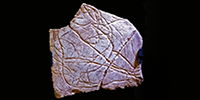 The cave of La Marche (Municipality of Lussac-les-Châteaux) can be considered as one of the most important archaeological sites for stone engravings. When French scientist Léon Péricard excavated La Marche between 1937 and 1942, he catalogued more than 1 500 slabs of limestone that had been placed carefully on the floor. Many of these have been engraved with human figures. Some can only be seen after careful study, and the painstaking removal of extraneous lines on the drawings made.
The cave of La Marche (Municipality of Lussac-les-Châteaux) can be considered as one of the most important archaeological sites for stone engravings. When French scientist Léon Péricard excavated La Marche between 1937 and 1942, he catalogued more than 1 500 slabs of limestone that had been placed carefully on the floor. Many of these have been engraved with human figures. Some can only be seen after careful study, and the painstaking removal of extraneous lines on the drawings made.
 The Manis Mastodon - A newly analysed mastodon rib bone shows that Native Americans were using bone-pointed weapons to take down big game nearly a thousand years earlier than thought, according to a new study. Images of the rib show a broken bone projectile point still stuck where a hunter drove it in 13 800 years ago.
The rib was found near the town of Sequim on Washington’s Olympic Peninsula, in the late 1970s. Radiocarbon analysis, DNA samples, genetics work, and other modern techniques recently revealed its true age.
The Manis Mastodon - A newly analysed mastodon rib bone shows that Native Americans were using bone-pointed weapons to take down big game nearly a thousand years earlier than thought, according to a new study. Images of the rib show a broken bone projectile point still stuck where a hunter drove it in 13 800 years ago.
The rib was found near the town of Sequim on Washington’s Olympic Peninsula, in the late 1970s. Radiocarbon analysis, DNA samples, genetics work, and other modern techniques recently revealed its true age.
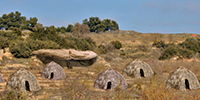 An engraved object recently found at the site of Molí del Salt in Spain and dated to the end of the Upper Paleolithic, about 13 800 BP, may show a hunter-gatherer campsite. The site location is privileged so far as mobility and resource distribution are concerned. On the one hand, the Francolí valley is a natural passage linking the Ebro basin and the coastal Mediterranean regions. On the other hand, it is an ecotone between the plain of the Ebro basin and the mountain domain of the Prades Mountains, 4 km south of the site. In addition, good-quality flint outcrops are common in the region.
An engraved object recently found at the site of Molí del Salt in Spain and dated to the end of the Upper Paleolithic, about 13 800 BP, may show a hunter-gatherer campsite. The site location is privileged so far as mobility and resource distribution are concerned. On the one hand, the Francolí valley is a natural passage linking the Ebro basin and the coastal Mediterranean regions. On the other hand, it is an ecotone between the plain of the Ebro basin and the mountain domain of the Prades Mountains, 4 km south of the site. In addition, good-quality flint outcrops are common in the region.
 In 1914 stone quarry workers in Bonn-Oberkassel discovered two human skeletons, bones from a dog, and two works of art made of bones and antlers. The combination of a double burial for humans and art and one of the oldest domestic dogs in the world, unique in Central Europe of around 14 000 years ago, makes this ensemble of findings one of the most important sources for the late Ice Age.
In 1914 stone quarry workers in Bonn-Oberkassel discovered two human skeletons, bones from a dog, and two works of art made of bones and antlers. The combination of a double burial for humans and art and one of the oldest domestic dogs in the world, unique in Central Europe of around 14 000 years ago, makes this ensemble of findings one of the most important sources for the late Ice Age.
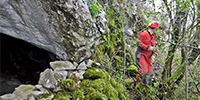 Partisan Cave in Slovenia - based on a chemical analysis of the red colour from one of the cave walls, this may be a remnant of the first Palaeolithic cave painting art in Slovenia. A human incisor belonging to a Neanderthal, which is the first fossil remains of Neanderthal man found in Slovenia, has been found.
Partisan Cave in Slovenia - based on a chemical analysis of the red colour from one of the cave walls, this may be a remnant of the first Palaeolithic cave painting art in Slovenia. A human incisor belonging to a Neanderthal, which is the first fossil remains of Neanderthal man found in Slovenia, has been found.
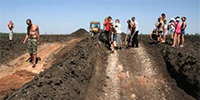 Burial mounds in the Rossosh area, south of the major city of Voronezh in Russia, have yielded evidence of several bronze age cultures including the pit-grave culture, the catacomb-grave culture, the Srubnaya culture, and the Sarmatian culture.
Burial mounds in the Rossosh area, south of the major city of Voronezh in Russia, have yielded evidence of several bronze age cultures including the pit-grave culture, the catacomb-grave culture, the Srubnaya culture, and the Sarmatian culture.
 The Salisbury axe quarry is in the Armidale/Uralla area of northern NSW Australia, and consists of an outcrop of vitrified (welded) tuff which has been used as a quarry for the blanks for ground axe heads by the local indigenous population for ten thousand years, since the end of the last ice age. The method of quarrying was thermal shock using fire to spall off large blanks which were subsequently worked into rough axe heads by knapping techniques, and then ground to a final shape and edge.
The Salisbury axe quarry is in the Armidale/Uralla area of northern NSW Australia, and consists of an outcrop of vitrified (welded) tuff which has been used as a quarry for the blanks for ground axe heads by the local indigenous population for ten thousand years, since the end of the last ice age. The method of quarrying was thermal shock using fire to spall off large blanks which were subsequently worked into rough axe heads by knapping techniques, and then ground to a final shape and edge.
 The Cave of Trois-Frères is a cave 427 metres long in southwestern France famous for its cave paintings. One of these, called 'The Sorcerer' is as familiar as any art in the more famous cave of Lascaux. The cave is part of a single cave-complex with the Tuc d'Audoubert, both galleries formed by the Volp River. The cave art appears to date to approximately 15 000 BP. The cave is named for the three sons of Comte Bégouen who discovered it in 1914. The drawings of the cave were made famous in the publications of the Abbé Henri Breuil.
The Cave of Trois-Frères is a cave 427 metres long in southwestern France famous for its cave paintings. One of these, called 'The Sorcerer' is as familiar as any art in the more famous cave of Lascaux. The cave is part of a single cave-complex with the Tuc d'Audoubert, both galleries formed by the Volp River. The cave art appears to date to approximately 15 000 BP. The cave is named for the three sons of Comte Bégouen who discovered it in 1914. The drawings of the cave were made famous in the publications of the Abbé Henri Breuil.
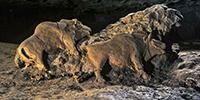 Tuc d'Audoubert, 640 metres long, may only be accessed via the stream, the Volp, which includes two impassable siphons. The cave of Tuc Audoubert was discovered by the sons of Count Henri three Bégouën i 1912. Having been to Mas d'Azil, during the summer holidays of 1912, July 20, they decided to explore the resurgence of Volp using a raft they made, and thus discovered the cave of Tuc d'Audoubert and the first engravings. A prehistorian, Emile Cartailhac, a family friend, was called immediately and authenticated the drawings. On 10 October, through a narrow gap which became known as the catflap, with the help of their friend François Camel, they penetrated the upper galleries at the bottom of which awaited the clay bisons!
Tuc d'Audoubert, 640 metres long, may only be accessed via the stream, the Volp, which includes two impassable siphons. The cave of Tuc Audoubert was discovered by the sons of Count Henri three Bégouën i 1912. Having been to Mas d'Azil, during the summer holidays of 1912, July 20, they decided to explore the resurgence of Volp using a raft they made, and thus discovered the cave of Tuc d'Audoubert and the first engravings. A prehistorian, Emile Cartailhac, a family friend, was called immediately and authenticated the drawings. On 10 October, through a narrow gap which became known as the catflap, with the help of their friend François Camel, they penetrated the upper galleries at the bottom of which awaited the clay bisons!
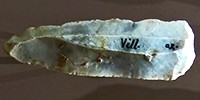 l'abri Villepin lies just downstream of the important site of l'abri de la Madeleine, itself just downstream of the Medieval village of La Madeleine. L'abri Villepin serves as the reference site for the definition of the end of the Magdalenian, and includes both Magdalenian and Azilian deposits and artefacts, including double barbed harpoon heads, double bevelled spear points, and works of art engraved on pebbles.
l'abri Villepin lies just downstream of the important site of l'abri de la Madeleine, itself just downstream of the Medieval village of La Madeleine. L'abri Villepin serves as the reference site for the definition of the end of the Magdalenian, and includes both Magdalenian and Azilian deposits and artefacts, including double barbed harpoon heads, double bevelled spear points, and works of art engraved on pebbles.

Maps of the extent of the ice in the last ice age in northern Europe and Eurasia. As well there is a set of maps illustrate how the last British ice sheet shrunk as the Ice Age ended. These unique maps record the pattern and speed of shrinkage of the large ice sheet that covered most of the British Isles during the last Ice Age, reaching its peak approximately 20 000 years ago. The sheet, which subsumed most of Britain, Ireland and the North Sea, had an ice volume sufficient to raise global sea level by around 2.5 metres when it melted.

Map of the Wurm and Riss Glaciation deposits in the Rhone valley.
Carte dressée par P. Mandier L.A 260 CNRS Lyon

Map of the Wurm and Riss Glaciation in the headwaters of the Donau (Danube)
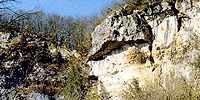
L'Abri des Marseilles, near Laugerie Haute and Laugerie Basse, contains many important deposits from the Magdalenian.
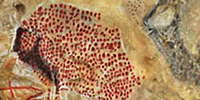 Marsoulas - La Grotte de Marsoulas, near Salies (Haute-Garonne), is formed by layers of limestone raised vertically against other layers which then buttress each other. It is the result of a fault. Around 1885, the Abbé Cau-Durban, archaeologist from Ariege, found the floor consisting of carbonaceous ash, animal bones, and worked flint. Patiently he collected many artefacts, the remains of an ice age site. The type of industry and the absence of barbed harpoons led him to believe its relative great age. The cave has since been explored thoroughly, and has revealed paintings and engravings of bison and horses on the walls, as well as artefacts from the ice age, and a huge Triton bailer shell from the sea 300 km away.
Marsoulas - La Grotte de Marsoulas, near Salies (Haute-Garonne), is formed by layers of limestone raised vertically against other layers which then buttress each other. It is the result of a fault. Around 1885, the Abbé Cau-Durban, archaeologist from Ariege, found the floor consisting of carbonaceous ash, animal bones, and worked flint. Patiently he collected many artefacts, the remains of an ice age site. The type of industry and the absence of barbed harpoons led him to believe its relative great age. The cave has since been explored thoroughly, and has revealed paintings and engravings of bison and horses on the walls, as well as artefacts from the ice age, and a huge Triton bailer shell from the sea 300 km away.
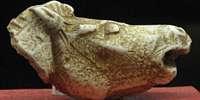 The cave of Mas-d'Azil is a large, 500 metre long tunnel dug by the Arize River through a wall of the Massif Plantaurelin, part of the Ariege Pyrenees. Secondary caves leading off the main tunnel were occupied at various prehistoric and historic times during a period of 20 000 years, and the objects found there gave the name of the cave to a prehistoric culture, the Azilian. It was excavated by Edouard Piette in the 19th century, who interpreted the halter-like marks on animal heads as being evidence of the domestication of reindeer and horses.
The cave of Mas-d'Azil is a large, 500 metre long tunnel dug by the Arize River through a wall of the Massif Plantaurelin, part of the Ariege Pyrenees. Secondary caves leading off the main tunnel were occupied at various prehistoric and historic times during a period of 20 000 years, and the objects found there gave the name of the cave to a prehistoric culture, the Azilian. It was excavated by Edouard Piette in the 19th century, who interpreted the halter-like marks on animal heads as being evidence of the domestication of reindeer and horses.
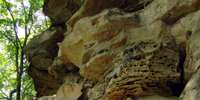 Meadowcroft Rockshelter, a pre-Clovis site. It has been continually inhabited for 16 000 years. It is an archaeological site on the north bank of Cross Creek, located near Avella in Washington County, in southwestern Pennsylvania, United States. The site, a rock shelter in a bluff overlooking Cross Creek (a tributary of the Ohio River) is located about 36 miles west-southwest of Pittsburgh. The artifacts from the site show the area has been continually inhabited for 16 000 years, since Paleo-Indian times. Meadowcroft Rockshelter was one of the first archaeological sites in the United States to contain evidence of pre-Clovis populations.
Meadowcroft Rockshelter, a pre-Clovis site. It has been continually inhabited for 16 000 years. It is an archaeological site on the north bank of Cross Creek, located near Avella in Washington County, in southwestern Pennsylvania, United States. The site, a rock shelter in a bluff overlooking Cross Creek (a tributary of the Ohio River) is located about 36 miles west-southwest of Pittsburgh. The artifacts from the site show the area has been continually inhabited for 16 000 years, since Paleo-Indian times. Meadowcroft Rockshelter was one of the first archaeological sites in the United States to contain evidence of pre-Clovis populations.
 At Mezhirich in 1965, a farmer dug up the lower jawbone of a mammoth while in the process of expanding his cellar. Further excavations revealed the presence of four huts, made up of a total of 149 mammoth bones. These dwellings, dating back some 15 000 years, were determined to have been some of the oldest shelters known to have been constructed by prehistoric man. Mezhirich or Mezhyrich or Межиріч, is a village in central Ukraine near the point where the Rosava River flows into the Ros.
At Mezhirich in 1965, a farmer dug up the lower jawbone of a mammoth while in the process of expanding his cellar. Further excavations revealed the presence of four huts, made up of a total of 149 mammoth bones. These dwellings, dating back some 15 000 years, were determined to have been some of the oldest shelters known to have been constructed by prehistoric man. Mezhirich or Mezhyrich or Межиріч, is a village in central Ukraine near the point where the Rosava River flows into the Ros.

Mizyn
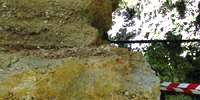 La Micoque open air Neanderthal site
La Micoque open air Neanderthal site
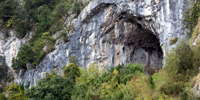 The archaeological cave site of El Mirón is located in the Rio Asón valley of eastern Cantabria, Spain. The cave opening is about 260 metres above sea level, and the cave opening is about 13 metres high, 8-16 metres wide, and 120 metres deep. El Mirón is remarkable for its long occupation history and thus for its long unbroken sequence of history and prehistory of Cantabria, Spain. The site includes human occupations between the Middle Paleolithic (ca 41 000 years ago) to AD 1400, including Mousterian, Early Upper Paleolithic, Solutrean, Magdalenian, Azilian, Mesolithic, Neolithic, Chalcolithic, and Bronze Age deposits.
The archaeological cave site of El Mirón is located in the Rio Asón valley of eastern Cantabria, Spain. The cave opening is about 260 metres above sea level, and the cave opening is about 13 metres high, 8-16 metres wide, and 120 metres deep. El Mirón is remarkable for its long occupation history and thus for its long unbroken sequence of history and prehistory of Cantabria, Spain. The site includes human occupations between the Middle Paleolithic (ca 41 000 years ago) to AD 1400, including Mousterian, Early Upper Paleolithic, Solutrean, Magdalenian, Azilian, Mesolithic, Neolithic, Chalcolithic, and Bronze Age deposits.
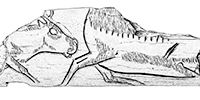 l'Abri du Morin is located in the commune of Pessac-sur-Dordogne, in Gironde. It was excavated between 1954 and 1958 by Deffarge who described two main sedimentary complexes, covered by a superficial level containing several pottery shards and other post-glacial remains. The site has yielded a large quantity of lithic and faunal remains attributed to the Magdalenian. Le Morin also yielded an abundant antler industry, with numerous decorated harpoons, a diversity of decorated objects and a rich fauna.
l'Abri du Morin is located in the commune of Pessac-sur-Dordogne, in Gironde. It was excavated between 1954 and 1958 by Deffarge who described two main sedimentary complexes, covered by a superficial level containing several pottery shards and other post-glacial remains. The site has yielded a large quantity of lithic and faunal remains attributed to the Magdalenian. Le Morin also yielded an abundant antler industry, with numerous decorated harpoons, a diversity of decorated objects and a rich fauna.

Mousterian (Neanderthal) Sites

Le Moustier Neanderthal skeletons - Neanderthal man lived in these rock shelters overlooking the small town of Le Moustier in the Dordogne, and gave its name to a characteristic Neanderthal tool set and culture, the Mousterian. Le Moustier is on the right bank of the Vezere at its confluence with the Vimont valley. Village houses rise in tiers on the rocky steps of the limestone outcrops at the angle formed by the two valleys.
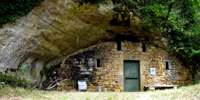
Grotte de la Mouthe was discovered in 1894, and was excavated by Emile Rivière. It contains more than 200 engravings and paintings of bison, horses, deer, cats, wolves, as well as two hands and a tectiform. The deposits in the cave record its use by Neanderthals and modern humans, based on the tools which were found there.
 The original Neanderthal skeleton found in 1856 in the Neander Valley in Germany consisted of a skull cap, two femora, three bones from the right arm, two from the left arm, part of the left ilium, fragments of a scapula, and ribs. The workers who recovered this material originally thought it to be the remains of a bear. This discovery is now considered the beginning of paleoanthropology. These and other discoveries led to the idea these remains were from ancient Europeans who had played an important role in modern human origins. The bones of over 400 Neanderthals have been found since.
The original Neanderthal skeleton found in 1856 in the Neander Valley in Germany consisted of a skull cap, two femora, three bones from the right arm, two from the left arm, part of the left ilium, fragments of a scapula, and ribs. The workers who recovered this material originally thought it to be the remains of a bear. This discovery is now considered the beginning of paleoanthropology. These and other discoveries led to the idea these remains were from ancient Europeans who had played an important role in modern human origins. The bones of over 400 Neanderthals have been found since.
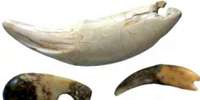
Neanderthal Symbolism - this is a translation of an excellent article discussing artefacts from many Neanderthal sites
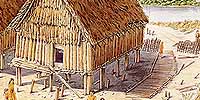
Neolithic and later sites
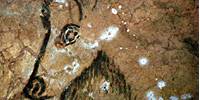 Niaux Cave, or la Grotte de Niaux is one of the most famous prehistoric caves in Europe. It lies in the northern foothills of the Pyrenees, and is located in Ariège, in the valley of Vicdessos, across the valley from the smaller Grotte de la Vache, in an area rich with prehistoric sites. The huge cave entrance, 55 metres high and 50 metres wide, is at 678 metres above sea level. There are more than two kilometres of galleries, with a hundred or more superb paintings from Magdalenian times, most of which are in the famous 'Salon Noir', 800 metres from the entrance. Many of the paintings are done in the classic style of the Magdalenian, outlined in black or red pigment, mostly haematite or manganese dioxide respectively.
Niaux Cave, or la Grotte de Niaux is one of the most famous prehistoric caves in Europe. It lies in the northern foothills of the Pyrenees, and is located in Ariège, in the valley of Vicdessos, across the valley from the smaller Grotte de la Vache, in an area rich with prehistoric sites. The huge cave entrance, 55 metres high and 50 metres wide, is at 678 metres above sea level. There are more than two kilometres of galleries, with a hundred or more superb paintings from Magdalenian times, most of which are in the famous 'Salon Noir', 800 metres from the entrance. Many of the paintings are done in the classic style of the Magdalenian, outlined in black or red pigment, mostly haematite or manganese dioxide respectively.
 Otzi the Iceman is a well-preserved natural mummy of a man from about 5300 BP. The mummy was found in 1991 in the Schnalstal glacier on the border between Austria and Italy. He is Europe's oldest natural human mummy, and has offered an unprecedented view of Chalcolithic (Copper Age) Europeans. The body and his belongings are displayed in the South Tyrol Museum of Archaeology in Bolzano, northern Italy.
Otzi the Iceman is a well-preserved natural mummy of a man from about 5300 BP. The mummy was found in 1991 in the Schnalstal glacier on the border between Austria and Italy. He is Europe's oldest natural human mummy, and has offered an unprecedented view of Chalcolithic (Copper Age) Europeans. The body and his belongings are displayed in the South Tyrol Museum of Archaeology in Bolzano, northern Italy.
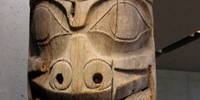 The First Nations of the Pacific North West Coast at one time had the most densely populated areas of indigenous people. The land and waters provided rich natural resources through cedar and salmon, and highly structured cultures developed from relatively dense populations. Within the Pacific Northwest, many different nations developed, each with their own distinct history, culture, and society. The creation of beautiful and practical objects (for all tribal communities) served as a means of transmitting stories, history, wisdom and property from generation to generation. Art provided Indigenous people with a tie to the land by depicting their histories on totem poles the Big (Plank) Houses of the Pacific Northwest coast – the symbols depicted were a constant reminder of their birth places, lineages and nations.
The First Nations of the Pacific North West Coast at one time had the most densely populated areas of indigenous people. The land and waters provided rich natural resources through cedar and salmon, and highly structured cultures developed from relatively dense populations. Within the Pacific Northwest, many different nations developed, each with their own distinct history, culture, and society. The creation of beautiful and practical objects (for all tribal communities) served as a means of transmitting stories, history, wisdom and property from generation to generation. Art provided Indigenous people with a tie to the land by depicting their histories on totem poles the Big (Plank) Houses of the Pacific Northwest coast – the symbols depicted were a constant reminder of their birth places, lineages and nations.
 Discovered in 1881, the cave of Pair-non-Pair contains engravings (featuring horses, ibexes, cervidae, mammoths) which rank among the most ancient examples of art made by prehistoric man (between 33 000 and 26 000 years old). Prehistoric objects and artefacts discovered at the Pair-non-Pair Caves are on display in a special museum section.
Discovered in 1881, the cave of Pair-non-Pair contains engravings (featuring horses, ibexes, cervidae, mammoths) which rank among the most ancient examples of art made by prehistoric man (between 33 000 and 26 000 years old). Prehistoric objects and artefacts discovered at the Pair-non-Pair Caves are on display in a special museum section.
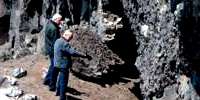 The Paisley Caves are located in the Summer Lake basin near Paisley, about 220 miles southeast of Eugene on the eastern side of the Cascade Range. The series of eight caves are westward-facing, wave-cut shelters on the highest shoreline of pluvial Lake Chewaucan, which rose and fell in periods of greater precipitation during the Pleistocene. One of the caves contains archaeological evidence of the oldest definitively-dated human presence in North America.
The Paisley Caves are located in the Summer Lake basin near Paisley, about 220 miles southeast of Eugene on the eastern side of the Cascade Range. The series of eight caves are westward-facing, wave-cut shelters on the highest shoreline of pluvial Lake Chewaucan, which rose and fell in periods of greater precipitation during the Pleistocene. One of the caves contains archaeological evidence of the oldest definitively-dated human presence in North America.
 Grottes du Pape, Brassempouy - The Venus of Brassempouy, or the lady with the hood was discovered in the Grottes du Pape, (Pope's Cave) in 1894, accompanied by at least eight other human figures. These may be an example of unfinished work, as if artist(s) carved several figurines at the same time. P.E. Dubalen first explored the Grotte du Pape in 1881, followed by J. de Laporterie and Édouard Piette (1827–1906) from 1894 onwards.
Grottes du Pape, Brassempouy - The Venus of Brassempouy, or the lady with the hood was discovered in the Grottes du Pape, (Pope's Cave) in 1894, accompanied by at least eight other human figures. These may be an example of unfinished work, as if artist(s) carved several figurines at the same time. P.E. Dubalen first explored the Grotte du Pape in 1881, followed by J. de Laporterie and Édouard Piette (1827–1906) from 1894 onwards.
 Paranthropus boisei was an early hominin. It lived in Eastern Africa during the Pleistocene epoch from about 2.3 until about 1.2 million years ago. First discovered by anthropologist Mary Leakey in 1959, at Olduvai Gorge, Tanzania, the well-preserved cranium (nicknamed 'Nutcracker Man') was dated to 1.75 million years old and had characteristics distinctive of the robust australopithecines. The brain volume is quite small, about 500 cc, not much larger in comparison to Australopithecus afarensis and Australopithecus africanus, or modern day chimpanzees. It had a skull highly specialised for heavy chewing and several traits seen in modern day gorillas. It inhabited savannah woodland territories.
Paranthropus boisei was an early hominin. It lived in Eastern Africa during the Pleistocene epoch from about 2.3 until about 1.2 million years ago. First discovered by anthropologist Mary Leakey in 1959, at Olduvai Gorge, Tanzania, the well-preserved cranium (nicknamed 'Nutcracker Man') was dated to 1.75 million years old and had characteristics distinctive of the robust australopithecines. The brain volume is quite small, about 500 cc, not much larger in comparison to Australopithecus afarensis and Australopithecus africanus, or modern day chimpanzees. It had a skull highly specialised for heavy chewing and several traits seen in modern day gorillas. It inhabited savannah woodland territories.
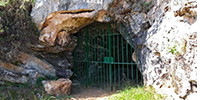 Pasiega Cave in Spain was of mostly academic interest until the discovery that some of the art in the cave was put there by Neandertals. This is a revolution in our understanding of the Neandertals. Here is the background to that discovery, with many drawings of the art of the cave from the old master himself, Breuil.
Pasiega Cave in Spain was of mostly academic interest until the discovery that some of the art in the cave was put there by Neandertals. This is a revolution in our understanding of the Neandertals. Here is the background to that discovery, with many drawings of the art of the cave from the old master himself, Breuil.
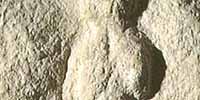
The Venus of Abri Pataud, as well as the site of Abri Pataud
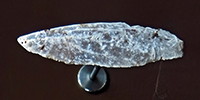 The Le Piage deposit is part of a set of caves and shelters opening at the base of a cliff 8 km from the Dordogne valley, just north of Gourdon. One of the richest collections in the world of artefacts from the Protoaurignacian has been excavated there.
The Le Piage deposit is part of a set of caves and shelters opening at the base of a cliff 8 km from the Dordogne valley, just north of Gourdon. One of the richest collections in the world of artefacts from the Protoaurignacian has been excavated there.
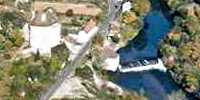
Pech Merle is one of the few prehistoric cave painting sites in France which remain open to the general public. Extending for more than a mile from the entrance are caverns the walls of which are painted with dramatic murals dating from the Gravettian culture (some 25 000 years BP) Some of the paintings and engravings, however, could date from the later Magdalenian era (16 000 years BP). The walls of seven of the chambers at Pech Merle have fresh, lifelike images of a woolly mammoth, spotted horses, bovids, reindeer, handprints, and some human figures. Footprints of children, preserved in what was once clay, have been found more than a kilometre underground.
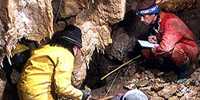
Peștera cu Oase
 Cueva del Pindal is situated near the town of Pimiango near the border of Cantabria. The cave paintings were discovered in 1908. Most of the cave paintings are located on the right walls of the cave as the visitor enters. Various studies have confirmed the existence of 13 bison, 8 horses, a deer, deer antlers, a mammoth and other unrecognisable figures. There are also abundant red marks such as dots, lines, parallel lines and claviform figures.
Cueva del Pindal is situated near the town of Pimiango near the border of Cantabria. The cave paintings were discovered in 1908. Most of the cave paintings are located on the right walls of the cave as the visitor enters. Various studies have confirmed the existence of 13 bison, 8 horses, a deer, deer antlers, a mammoth and other unrecognisable figures. There are also abundant red marks such as dots, lines, parallel lines and claviform figures.
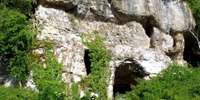 La grotte du Placard is a decorated cave in the commune of Vilhonneur in Charante, 30 km east of Angoulême. It has been extensively researched and has levels dating from the Middle and Upper Paleolithic, especially the Magdalenian and Solutrean. A dozen aviform signs identical to those discovered in the caves of Pech Merle and Cougnac. Similar signs were found in the Cosquer Cave near Marseille, 500 km away. The figures date back about 20 000 years to the Solutrean. The signs are known as Placard type signs. The cave is not accessible to the public.
La grotte du Placard is a decorated cave in the commune of Vilhonneur in Charante, 30 km east of Angoulême. It has been extensively researched and has levels dating from the Middle and Upper Paleolithic, especially the Magdalenian and Solutrean. A dozen aviform signs identical to those discovered in the caves of Pech Merle and Cougnac. Similar signs were found in the Cosquer Cave near Marseille, 500 km away. The figures date back about 20 000 years to the Solutrean. The signs are known as Placard type signs. The cave is not accessible to the public.

L'Abri Poisson is located in the valley of the Gorge d'Enfer, on the right bank of the Vézère River near Les Eyzies-de-Tayac. The shelter was discovered in 1892 by Paul Girod, and dates from the Aurignacian. In 1912 Jean Marsan identified the fish carved in the ceiling of a small abri that made the site famous.
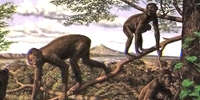 Proconsul africanus is the first species of the oligocene-era fossil genus of primate to be discovered and was named by Arthur Hopwood, an associate of Louis Leakey, in 1933. The Leakey expedition of 1947 - 1948 to Rusinga Island in Lake Victoria uncovered more species of Proconsul. Louis Leakey made an especially complete find of Proconsul there in 1948. The 18-million-year-old fossil species has been considered a possible ancestor of both great and lesser apes, and of humans. Opinion currently favours a position between the monkeys and the apes.
Proconsul africanus is the first species of the oligocene-era fossil genus of primate to be discovered and was named by Arthur Hopwood, an associate of Louis Leakey, in 1933. The Leakey expedition of 1947 - 1948 to Rusinga Island in Lake Victoria uncovered more species of Proconsul. Louis Leakey made an especially complete find of Proconsul there in 1948. The 18-million-year-old fossil species has been considered a possible ancestor of both great and lesser apes, and of humans. Opinion currently favours a position between the monkeys and the apes.
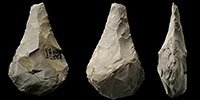 Qesem is a pre-Mousterian cave in Israel which was found in October 2000 when road construction destroyed its ceiling. This led to two rescue excavations in 2001. At present the site is protected, covered, and fenced, and subject to on-going excavations. The inhabitants stored the long bones of their kill for up to eight weeks, in order to be able to later consume the bone marrow preserved in it.
Qesem is a pre-Mousterian cave in Israel which was found in October 2000 when road construction destroyed its ceiling. This led to two rescue excavations in 2001. At present the site is protected, covered, and fenced, and subject to on-going excavations. The inhabitants stored the long bones of their kill for up to eight weeks, in order to be able to later consume the bone marrow preserved in it.
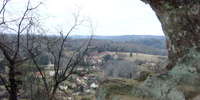
Grotte de Queylou just outside Les Eyzies is a spectacular pre-historic site, which is not generally known. It also in many ways personifies what a pre-historic cave dwelling would be like, with its medieval features of large carved out windows, shelves, benches, and holes for wooden beams. Grotte de Queylou is located on a main trail that goes along the bottom of long cliff face, which contains many prehistoric overhangs, rock shelters, and numerous caves.

La Quina is a Neanderthal site located in the Charente region of south-western France. The artisans of the La Quina Mousterian industry type (thick asymmetric tools transformed many times) had a particular way of life: they were hunters specializing in the hunt for Reindeer or Bison, and they moved following the herds. Their prey was generally transported, either all or in part, back to their base camps, caves or shelters.
 Abri de Raymonden, Chancelade, was discovered in 1876 by M. Hardy, who also started the excavation work. The Raymonden deposits contained a multitude of stone and bone artefacts from the Magdalenian including numerous art works such as the famous bison hunt pendant. The skeleton of 'Chancelade Man' was discovered on 1st October, 1888 below the floor of the rock shelter, resting on bedrock. After years of studying casts of the skeleton's skull as well as carrying out detailed anthropometric surveys, Ms Élisabeth Daynès has created a silicone reconstruction of what the man would have looked like. The result is a grey and balding looking man with blue eyes and wrinkled skin. He is estimated to have been between 55 and 65 years old at death.
Abri de Raymonden, Chancelade, was discovered in 1876 by M. Hardy, who also started the excavation work. The Raymonden deposits contained a multitude of stone and bone artefacts from the Magdalenian including numerous art works such as the famous bison hunt pendant. The skeleton of 'Chancelade Man' was discovered on 1st October, 1888 below the floor of the rock shelter, resting on bedrock. After years of studying casts of the skeleton's skull as well as carrying out detailed anthropometric surveys, Ms Élisabeth Daynès has created a silicone reconstruction of what the man would have looked like. The result is a grey and balding looking man with blue eyes and wrinkled skin. He is estimated to have been between 55 and 65 years old at death.
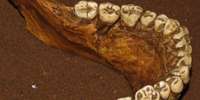
Le Regourdou is one of the most important Neanderthal sites in France. Excavated by Georges Laplace and Eugene Bonifay, the bones of Le Regourdou 1 are the remains of a young Neanderthal adult, of undetermined sex, from the beginning of the last glaciation, about 90 000 years ago. The archeological site of Regourdou is located on the same hilltop as Lascaux, 800 metres from the famous caves.
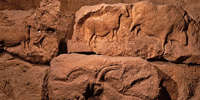 The Roc de Sers sculpted frieze is one of the relatively few examples of parietal art that can be confidently attributed to the Solutrean as it fragmented and fell off the rear wall of the rockshelter into dated archaeological deposits. Sculpture is rare in Upper Palaeolithic parietal art, and, given the relative paucity of Solutrean parietal art in general, Roc de Sers is doubly important as it serves as a benchmark for defining Solutrean artistic form and technique. Abundant evidence has been recovered from three main activity areas across a large part of the rockshelter and associated small cave; a rich classic Solutrean lithic assemblage bears witness to the production of feuilles de laurier, pointes à cran, burins and grattoirs.
The Roc de Sers sculpted frieze is one of the relatively few examples of parietal art that can be confidently attributed to the Solutrean as it fragmented and fell off the rear wall of the rockshelter into dated archaeological deposits. Sculpture is rare in Upper Palaeolithic parietal art, and, given the relative paucity of Solutrean parietal art in general, Roc de Sers is doubly important as it serves as a benchmark for defining Solutrean artistic form and technique. Abundant evidence has been recovered from three main activity areas across a large part of the rockshelter and associated small cave; a rich classic Solutrean lithic assemblage bears witness to the production of feuilles de laurier, pointes à cran, burins and grattoirs.
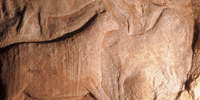
Roc-aux-Sorciers is an Upper Paleolithic rock shelter site dating to the mid-Magdalenian cultural stage, ca 14 000 BP, made famous by its relief wall carvings. The south-facing rock-shelter is composed of two geologically distinct sections; below is the Abri Bourdois, a classic rock-shelter site beneath a slight overhang, and above is the Cave Taillebourg, a deeper vestibule. The art of Roc-aux-Sorciers is in two distinct categories - a 20 metre long frieze, still standing, not open to the public, and a series of sculptures, formerly on a wall of a collapsed section of the site.
 The viking ships of Roskilde. Towards the close of the Viking Age the fairways of Roskilde Fjord were blocked by a series of barriers to protect the important trading town of Roskilde from attack by enemy fleets. The five viking ships in the Roskilde Viking Ship museum come from one of these blockages in the Peberrende channel at Skuldelev, 20 km north of Roskilde. Here, a total of five ships were sunk across the channel and boulders heaped up on top of them. In 1962 a coffer dam of sheet piling was built around the blockage so that it could be drained. In a period of less than four months all five ships were excavated and brought to land in thousands of fragments, which have since been reassembled.
The viking ships of Roskilde. Towards the close of the Viking Age the fairways of Roskilde Fjord were blocked by a series of barriers to protect the important trading town of Roskilde from attack by enemy fleets. The five viking ships in the Roskilde Viking Ship museum come from one of these blockages in the Peberrende channel at Skuldelev, 20 km north of Roskilde. Here, a total of five ships were sunk across the channel and boulders heaped up on top of them. In 1962 a coffer dam of sheet piling was built around the blockage so that it could be drained. In a period of less than four months all five ships were excavated and brought to land in thousands of fragments, which have since been reassembled.
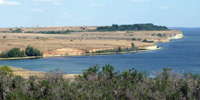
Russian, Ukrainian and Siberian Paleolithic sites - The Paleolithic of the former USSR.
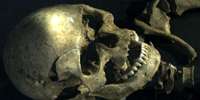
Roc-de-Cave

Roc de Marsal, a Neanderthal site in the Dordogne. The three year old child discovered in 1961 here was well preserved, and with a date of around 70 000 years BP it is one of the oldest burials of the Perigord.
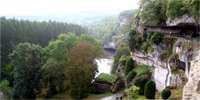 Reflection Rock and Roque Saint-Christophe - The Roque Saint Christophe is a cliff with five separate levels overlooking 900 metres of the Vezere valley. Its hundreds of natural rock shelters were inhabited from the ice ages until the Middle Ages, and the terraces could accommodate up to 1000 people. An impressive fortress and town were constructed on the different levels, and was one of the main bastions of defence during the Hundred Years War with the English. The English laid siege to it in 1401 and gained possession of it by starving the inhabitants out, only to lose possession themselves just five years later.
Reflection Rock and Roque Saint-Christophe - The Roque Saint Christophe is a cliff with five separate levels overlooking 900 metres of the Vezere valley. Its hundreds of natural rock shelters were inhabited from the ice ages until the Middle Ages, and the terraces could accommodate up to 1000 people. An impressive fortress and town were constructed on the different levels, and was one of the main bastions of defence during the Hundred Years War with the English. The English laid siege to it in 1401 and gained possession of it by starving the inhabitants out, only to lose possession themselves just five years later.

Prehistory of the Oltenia region of Romania - The Alexis Project. This is an overview of the work in progress by a small but dedicated group of Romanian people interested in preserving the prehistory and history of their region, and increasing knowledge about their area.
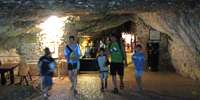 La Grotte de Rouffignac has been known for centuries and was described in 1575 by Francois de Belleforest. It is located in the heart of the Perigord, between Bergerac and Sarlat in the Dordogne region. The site has more than 250 etchings and line drawings dating from the Upper Paleolithic (Magdalenian, more than 13 000 years BP). With a length of over eight kilometres, this cave is one of the largest painted caves in Europe. These galleries were decorated with 158 mammoths associated with woolly rhinoceroses, bison, horses and ibex.
La Grotte de Rouffignac has been known for centuries and was described in 1575 by Francois de Belleforest. It is located in the heart of the Perigord, between Bergerac and Sarlat in the Dordogne region. The site has more than 250 etchings and line drawings dating from the Upper Paleolithic (Magdalenian, more than 13 000 years BP). With a length of over eight kilometres, this cave is one of the largest painted caves in Europe. These galleries were decorated with 158 mammoths associated with woolly rhinoceroses, bison, horses and ibex.
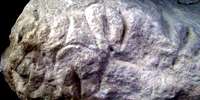
Le Ruth and Le Cellier - Sous le Ruth is the house beneath the archeological site, le Ruth, near le Moustier, and is a private gisement, with a good display of stone tools, and access to the excavated site of le Ruth. Le Cellier is an important site a few hundred metres away, which yielded many Aurignacian tools and stone engravings of vulvas. The deposits of le Ruth above Sous le Ruth were excavated by Otto Hauser.
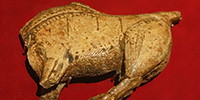 La Salle Piette contains a fabulous collection of prehistoric artefacts, tools and weapons discovered in the 19th century by Édouard Piette during excavations in the Pyrenees. Many masterpieces are exhibited, including several famous 'venus' figures. The set design is unchanged since the 19th century at the express request of Edward Piette who bequeathed his collection to the state on conditions defined by him, and unchanging over time.
La Salle Piette contains a fabulous collection of prehistoric artefacts, tools and weapons discovered in the 19th century by Édouard Piette during excavations in the Pyrenees. Many masterpieces are exhibited, including several famous 'venus' figures. The set design is unchanged since the 19th century at the express request of Edward Piette who bequeathed his collection to the state on conditions defined by him, and unchanging over time.
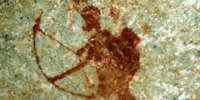 These paintings by the San people of South Africa are on the Sevilla Trail near the Traveller's Rest, a lodge on a farm about 30 km east of Clanwilliam in the Western Cape Province of South Africa, and are taken by Michael Hess. The Bushmen/San were the original inhabitants of Southern Africa and are commonly known as Bushmen or San. They were hunter-gatherers, hunting with bows and arrows, trapping small animals and eating edible roots and berries. They lived in rock shelters, in the open or in crude shelters of twigs and grass or animal skins. They made no pottery, rather using ostrich eggshells or animal parts for storing and holding liquids. For these reasons, animals and nature are central features in the Bushmen's religious tradition, folklore, art and rituals.
These paintings by the San people of South Africa are on the Sevilla Trail near the Traveller's Rest, a lodge on a farm about 30 km east of Clanwilliam in the Western Cape Province of South Africa, and are taken by Michael Hess. The Bushmen/San were the original inhabitants of Southern Africa and are commonly known as Bushmen or San. They were hunter-gatherers, hunting with bows and arrows, trapping small animals and eating edible roots and berries. They lived in rock shelters, in the open or in crude shelters of twigs and grass or animal skins. They made no pottery, rather using ostrich eggshells or animal parts for storing and holding liquids. For these reasons, animals and nature are central features in the Bushmen's religious tradition, folklore, art and rituals.
 The earliest evidence of human life in Schleswig-Holstein occurred 120 000 years ago. At Drelsdorf in the district of Nordfriesland, the stone tools of a group of Neanderthals, who camped here 120 000 years ago, were discovered. In the subsequent ice age, the site was located in front of the ice sheet edge. The extremely cold climatic conditions have changed the surface of the artefacts in a characteristic way, giving them a patina they would not otherwise have.
The earliest evidence of human life in Schleswig-Holstein occurred 120 000 years ago. At Drelsdorf in the district of Nordfriesland, the stone tools of a group of Neanderthals, who camped here 120 000 years ago, were discovered. In the subsequent ice age, the site was located in front of the ice sheet edge. The extremely cold climatic conditions have changed the surface of the artefacts in a characteristic way, giving them a patina they would not otherwise have.
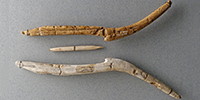 Ice Age Hunters become farmers: Schleswig-Holstein on the way to the Neolithic. The Schleswig-Holstein region has a long history of settlement, from neanderthal times to the present day. The period from that of the reindeer hunters, who advanced into the area after the ice started to retreat after 20 000 BP, through to the end of the Mesolithic, was particularly interesting.
Ice Age Hunters become farmers: Schleswig-Holstein on the way to the Neolithic. The Schleswig-Holstein region has a long history of settlement, from neanderthal times to the present day. The period from that of the reindeer hunters, who advanced into the area after the ice started to retreat after 20 000 BP, through to the end of the Mesolithic, was particularly interesting.
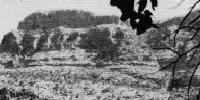 Shanidar Cave is located in the Zagros Mountains of Kurdistan in Iraq. It was excavated between 1957-1961 by Ralph Solecki and his team from Columbia University and yielded the first adult Neanderthal skeletons in Iraq, dating between 60-80 000 years BP.
Shanidar Cave is located in the Zagros Mountains of Kurdistan in Iraq. It was excavated between 1957-1961 by Ralph Solecki and his team from Columbia University and yielded the first adult Neanderthal skeletons in Iraq, dating between 60-80 000 years BP.
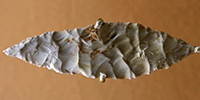 The Solutrean takes its name from the Crôt du Charnier site in Solutré-Pouilly, in Saône-et-Loire. During all the upper Paleolithic, Solutré was a site which specialised in the hunting of horses, where prehistoric men returned periodically. It does not include living areas occupied for long periods, but there are specialised areas of activity, especially the processing of game after the hunt. Some tools - pointes à face plane, laurel leaves, shouldered points - were made by a sophisticated retouch that was obtained by a new technique called pressure flaking, on flint which had been heat treated to make it much more workable.
The Solutrean takes its name from the Crôt du Charnier site in Solutré-Pouilly, in Saône-et-Loire. During all the upper Paleolithic, Solutré was a site which specialised in the hunting of horses, where prehistoric men returned periodically. It does not include living areas occupied for long periods, but there are specialised areas of activity, especially the processing of game after the hunt. Some tools - pointes à face plane, laurel leaves, shouldered points - were made by a sophisticated retouch that was obtained by a new technique called pressure flaking, on flint which had been heat treated to make it much more workable.
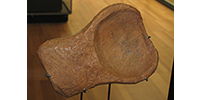 Solvieux is a large open-air site in the middle Isle Basin. It has stratigraphical sequences from the Middle Palaeolithic to the Magdalenian. J. Sackett's excavations in this area have yielded an unknown industry in Southwestern France, between the Mousterian and the Aurignacian. This industry is characterised by the great abundance (50%) of truncated blades that J. Sackett has called 'Solvieux truncations' and by the presence of bladelets with thin retouch on the lower face. The cultural affiliation of this industry known now as the Beauronnian, is not yet resolved.
Solvieux is a large open-air site in the middle Isle Basin. It has stratigraphical sequences from the Middle Palaeolithic to the Magdalenian. J. Sackett's excavations in this area have yielded an unknown industry in Southwestern France, between the Mousterian and the Aurignacian. This industry is characterised by the great abundance (50%) of truncated blades that J. Sackett has called 'Solvieux truncations' and by the presence of bladelets with thin retouch on the lower face. The cultural affiliation of this industry known now as the Beauronnian, is not yet resolved.
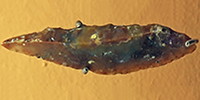 The Châtelperronian is a proposed industry of the Upper Palaeolithic, the existence of which is debated. It derives its name from the site of la Grotte des Fées, in Châtelperron, Allier, France. It is preceded by the Mousterian industry, and lasted from circa 45 000 to circa 40 000 BP. The industry produced denticulate stone tools and also a distinctive flint knife with a single cutting edge and a blunt, curved back. It is followed by the Aurignacian industry. Scholars who question its existence claim that it is an archaeological mix of Mousterian and Aurignacian layers.
The Châtelperronian is a proposed industry of the Upper Palaeolithic, the existence of which is debated. It derives its name from the site of la Grotte des Fées, in Châtelperron, Allier, France. It is preceded by the Mousterian industry, and lasted from circa 45 000 to circa 40 000 BP. The industry produced denticulate stone tools and also a distinctive flint knife with a single cutting edge and a blunt, curved back. It is followed by the Aurignacian industry. Scholars who question its existence claim that it is an archaeological mix of Mousterian and Aurignacian layers.

The Grotte du Sorcier, or the Roc Saint-Cirq, is one of the sites classified as a World Heritage site by UNESCO among the prehistoric painted caves in the Vézère valley. It was discovered in late 1951. This site contains prehistoric engravings dating from the Magdalenian. There are engravings of humans, including the famous sorcerer, as well as animals (bison, horses and ibex), and linear signs.
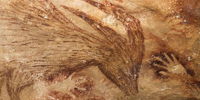 Cave paintings from the Indonesian island of Sulawesi are at least 40 thousand years old, according to a study published this week in the scientific journal Nature. This is compatible in age with the oldest known rock art from Europe, long seen as the birthplace of 'Ice Age' cave painting and home to the most sophisticated artworks in early human cultural history.
Cave paintings from the Indonesian island of Sulawesi are at least 40 thousand years old, according to a study published this week in the scientific journal Nature. This is compatible in age with the oldest known rock art from Europe, long seen as the birthplace of 'Ice Age' cave painting and home to the most sophisticated artworks in early human cultural history.

The Sungir - Sunghir site near Moscow - About 24 000 years ago, a group of hunters and gatherers buried their dead - including two boys with physical conditions - using the utmost care. The roughly 10 and 12 year-old boys were buried head to head in a long, slender grave filled with riches, including more than 10 000 mammoth ivory beads, more than 20 armbands, about 300 pierced fox teeth, 16 ivory mammoth spears, carved artwork, deer antlers and two human fibulas laid across the boys' chests, the researchers said.
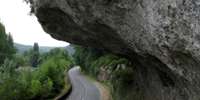
Fort de Tayac - a refuge from war during the Middle Ages
Fort de Tayac is a cliff beside the Vezere River, with a history of previous human habitation using the broad flat ledges as living space, and evidence in the form of holes in the cliff which formerly held supports for roofs of dwellings.
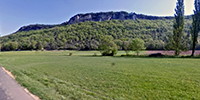 La Grotte Vaufrey is one of 22 caves and rock shelters known to dot the limestone cliff on the east side of the Céou River just south of its junction with the Dordogne River in Southwestern France. Excavated under the direction of Jean-Philippe Rigaud between 1969 and 1982, this site proved to contain a remarkable sequence of Acheulean and Mousterian occupations distributed across 12 major depositional units, couches I - XII.
La Grotte Vaufrey is one of 22 caves and rock shelters known to dot the limestone cliff on the east side of the Céou River just south of its junction with the Dordogne River in Southwestern France. Excavated under the direction of Jean-Philippe Rigaud between 1969 and 1982, this site proved to contain a remarkable sequence of Acheulean and Mousterian occupations distributed across 12 major depositional units, couches I - XII.
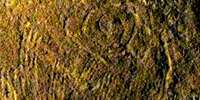
La Grotte de la Vache is important for the complete camp of Magdalenian hunters found, and may be seen almost as it was 12 000 to 15 000 years ago. Weapons, tools, typical game and artworks have been recovered from this small but important site. It was the living quarters for the artists at Niaux Cave, just across the Vicdessos Valley.
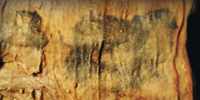 The Grottes de Villars contain galleries of stalactites and earth coloured calcite accumulations, including 17 000 year old prehistoric paintings dating from the same period as those at Lascaux. The slow seepage of water has created some of the most beautiful natural scenery. There are all types of concretions: calcite, thin stalactites, gours, translucent draperies and countless stalagmites. Some of the cave paintings, like those of the rotunda of the horses are covered with a thin layer of calcite that gives them a special blue color.The scene of the bison and the sorcerer is one of the few human representations of prehistoric art.
The Grottes de Villars contain galleries of stalactites and earth coloured calcite accumulations, including 17 000 year old prehistoric paintings dating from the same period as those at Lascaux. The slow seepage of water has created some of the most beautiful natural scenery. There are all types of concretions: calcite, thin stalactites, gours, translucent draperies and countless stalagmites. Some of the cave paintings, like those of the rotunda of the horses are covered with a thin layer of calcite that gives them a special blue color.The scene of the bison and the sorcerer is one of the few human representations of prehistoric art.
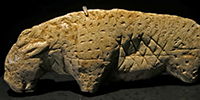 Vogelherd cave is located on the edge of the Lone valley, about 1 km northwest of Stetten and northeast of the Alb-Donau county (Alb-Donau-Kreis). Vogelherd cave is a very scenic place and well worth a visit, as indeed is all of the Lone valley. The cave is not visible from the road and one must first walk over a ridge to gain access to the three entrances on the edge of the Lone valley. The cave covers an area of 170 square metres. This extremely important site, rich in finds, was first discovered when Stone Age artefacts turned up from a badger's burrow. The actual size of it only became apparent after the excavations by Gustav Riek in the summer of 1931. The finds range from the Middle Palaeolithic to modern times. The world-renowned ivory carvings originate from the Middle Aurignacian period.
Vogelherd cave is located on the edge of the Lone valley, about 1 km northwest of Stetten and northeast of the Alb-Donau county (Alb-Donau-Kreis). Vogelherd cave is a very scenic place and well worth a visit, as indeed is all of the Lone valley. The cave is not visible from the road and one must first walk over a ridge to gain access to the three entrances on the edge of the Lone valley. The cave covers an area of 170 square metres. This extremely important site, rich in finds, was first discovered when Stone Age artefacts turned up from a badger's burrow. The actual size of it only became apparent after the excavations by Gustav Riek in the summer of 1931. The finds range from the Middle Palaeolithic to modern times. The world-renowned ivory carvings originate from the Middle Aurignacian period.
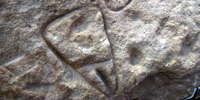 The Vulva in Stone Age Art - The vulva is well represented in Palaeolithic art. It is mostly seen as engravings on stone, bone or ivory. The representation is obviously a well known one that has become abstracted to the point where it is often no more than an oval or circle with a single mark at its centre or at its lower edge. Although many examples are from Europe, and from the upper Palaeolithic, it occurs over a broad time range, and a very large area, including not just Europe, but Australia as well.
The Vulva in Stone Age Art - The vulva is well represented in Palaeolithic art. It is mostly seen as engravings on stone, bone or ivory. The representation is obviously a well known one that has become abstracted to the point where it is often no more than an oval or circle with a single mark at its centre or at its lower edge. Although many examples are from Europe, and from the upper Palaeolithic, it occurs over a broad time range, and a very large area, including not just Europe, but Australia as well.
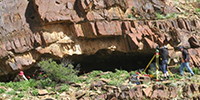 In a stunning discovery, a team of archaeologists in Australia has found extensive remains of a sophisticated human community living 50 000 years ago in Warratyi Rock Shelter. Packed with a range of tools, decorative pigments, and animal bones, the shelter is a wide, roomy space located in the Flinders Ranges, which are the ancestral lands of the Adnyamathanha. The find overturns previous hypotheses of how humans colonised Australia, and it also proves that they interacted with now-extinct megafauna that ranged across the continent.
In a stunning discovery, a team of archaeologists in Australia has found extensive remains of a sophisticated human community living 50 000 years ago in Warratyi Rock Shelter. Packed with a range of tools, decorative pigments, and animal bones, the shelter is a wide, roomy space located in the Flinders Ranges, which are the ancestral lands of the Adnyamathanha. The find overturns previous hypotheses of how humans colonised Australia, and it also proves that they interacted with now-extinct megafauna that ranged across the continent.
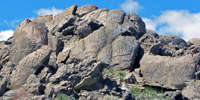 Winnemucca Lake petroglyphs discovered in western Nevada are at least 10 500 years old, making them the oldest rock art ever dated in North America. On the west side of Nevada's dried-up Winnemucca Lake, there are several limestone boulders with deep, ancient carvings; some resemble trees and leaves, whereas others are more abstract designs that look like ovals or diamonds in a chain. The true age of this rock art had not been known, but a new analysis suggests these petroglyphs are the oldest North America, dating back to between 10 500 and 14 800 years ago.
Winnemucca Lake petroglyphs discovered in western Nevada are at least 10 500 years old, making them the oldest rock art ever dated in North America. On the west side of Nevada's dried-up Winnemucca Lake, there are several limestone boulders with deep, ancient carvings; some resemble trees and leaves, whereas others are more abstract designs that look like ovals or diamonds in a chain. The true age of this rock art had not been known, but a new analysis suggests these petroglyphs are the oldest North America, dating back to between 10 500 and 14 800 years ago.
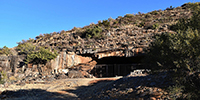 Wonderwerk Cave in South Africa contains stone tools dated to two million years ago, possibly knapped by Homo habilis. It is one of the earliest cave occupation sites in the world, and is the site of some of the earliest uses of controlled fire and tool making.
Wonderwerk Cave in South Africa contains stone tools dated to two million years ago, possibly knapped by Homo habilis. It is one of the earliest cave occupation sites in the world, and is the site of some of the earliest uses of controlled fire and tool making.
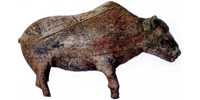
Zaraysk



 L'Abri du Cap Blanc - Over 15 000 years ago, Ice Age hunters carved horses, bison and reindeer, some of which are over two metres long, straight into the Limestone cliffs at Cap Blanc. The abri, which was discovered in 1909, is today the only frieze of prehistoric sculptures in the world to be shown to the public.
L'Abri du Cap Blanc - Over 15 000 years ago, Ice Age hunters carved horses, bison and reindeer, some of which are over two metres long, straight into the Limestone cliffs at Cap Blanc. The abri, which was discovered in 1909, is today the only frieze of prehistoric sculptures in the world to be shown to the public.  St Césaire Neanderthal Skeleton
St Césaire Neanderthal Skeleton The Neandertal skeleton from La Chapelle-aux-Saints
The Neandertal skeleton from La Chapelle-aux-Saints Chauvet Cave in the valley of the Ardèche River in France is filled with paintings, engravings and drawings created more than 30 000 years ago, of cave lions, mammoths, rhinos, bison, cave bears and horses. It contains the earliest known cave paintings, as well as other evidence of Upper Paleolithic life. It is situated on a limestone cliff above the former bed of the Ardèche River. The later Gravettian occupation, which occurred 25 000 to 27 000 years ago, left little but a child's footprints, the charred remains of ancient hearths and carbon smoke stains from torches that lit the caves. After the child's visit to the cave, evidence suggests that the cave had been untouched until discovered in 1994. The footprints may be the oldest human footprints that can be dated accurately
Chauvet Cave in the valley of the Ardèche River in France is filled with paintings, engravings and drawings created more than 30 000 years ago, of cave lions, mammoths, rhinos, bison, cave bears and horses. It contains the earliest known cave paintings, as well as other evidence of Upper Paleolithic life. It is situated on a limestone cliff above the former bed of the Ardèche River. The later Gravettian occupation, which occurred 25 000 to 27 000 years ago, left little but a child's footprints, the charred remains of ancient hearths and carbon smoke stains from torches that lit the caves. After the child's visit to the cave, evidence suggests that the cave had been untouched until discovered in 1994. The footprints may be the oldest human footprints that can be dated accurately


 The Grotte de Cussac contains over 150 Paleolithic artworks as well as several human remains. It was discovered on September 30, 2000 by amateur speleologist Marc Delluc. It is closed to the public. The cave's artworks are almost exclusively engravings, often very large, made with stone tools on the walls, or with fingers on clay. At least five people, four adults and a teenager, were deposited in the cavities, with bones dated by Carbon 14 measurements to approximately 25 000 years in age.
The Grotte de Cussac contains over 150 Paleolithic artworks as well as several human remains. It was discovered on September 30, 2000 by amateur speleologist Marc Delluc. It is closed to the public. The cave's artworks are almost exclusively engravings, often very large, made with stone tools on the walls, or with fingers on clay. At least five people, four adults and a teenager, were deposited in the cavities, with bones dated by Carbon 14 measurements to approximately 25 000 years in age. 
 Dolni Vestonice is an ice age mammoth hunters site in the Czech Republic near the town of Brno, in Sudmären - Southern Moravia. Dolni Vestonice I is the original site, where a kiln and pottery figures were found. Dolni Vestonice II is the site where a triple burial of three teenagers was discovered. Dolni Vestonice III is between these two, and has yielded so far tools and bone fragments.
Dolni Vestonice is an ice age mammoth hunters site in the Czech Republic near the town of Brno, in Sudmären - Southern Moravia. Dolni Vestonice I is the original site, where a kiln and pottery figures were found. Dolni Vestonice II is the site where a triple burial of three teenagers was discovered. Dolni Vestonice III is between these two, and has yielded so far tools and bone fragments.

 Homo floresiensis was a one metre tall, human-like creature living and using tools in Indonesia just 18 000 years ago and was a distinct species, not just a malformed modern human. The so-called hobbit had wrist bones almost identical to those found in early hominins and modern chimpanzees, and so must have diverged from the human lineage well before modern humans and Neanderthals arose.
Homo floresiensis was a one metre tall, human-like creature living and using tools in Indonesia just 18 000 years ago and was a distinct species, not just a malformed modern human. The so-called hobbit had wrist bones almost identical to those found in early hominins and modern chimpanzees, and so must have diverged from the human lineage well before modern humans and Neanderthals arose. Font-de-Gaume is a cave near Les Eyzies. The cave contains prehistoric polychrome cave paintings and engravings. The paintings were discovered by Denis Peyrony, a local schoolmaster, on 12 September 1901. The cave had been known to the general public before this, but the significance of the paintings had not been recognised. The paintings in the cave at Font-de-Gaume were the first to be discovered in the Périgord province. Prehistoric people living in the Dordogne Valley first settled in the mouth of Font-de-Gaume around 25 000 BC. The cave mouth was inhabited at least sporadically for the next several thousand years. The paintings date from around 17 000 BC, during the Magdalenian period. Many of the cave's paintings have been discovered in recent decades. The cave's most famous painting, a frieze of five bison was discovered accidentally in 1966 while scientists were cleaning the cave.
Font-de-Gaume is a cave near Les Eyzies. The cave contains prehistoric polychrome cave paintings and engravings. The paintings were discovered by Denis Peyrony, a local schoolmaster, on 12 September 1901. The cave had been known to the general public before this, but the significance of the paintings had not been recognised. The paintings in the cave at Font-de-Gaume were the first to be discovered in the Périgord province. Prehistoric people living in the Dordogne Valley first settled in the mouth of Font-de-Gaume around 25 000 BC. The cave mouth was inhabited at least sporadically for the next several thousand years. The paintings date from around 17 000 BC, during the Magdalenian period. Many of the cave's paintings have been discovered in recent decades. The cave's most famous painting, a frieze of five bison was discovered accidentally in 1966 while scientists were cleaning the cave. 





 The neanderthal skeleton from Kebara in Israel
The neanderthal skeleton from Kebara in Israel 

 The Lagar Velho Hybrid Child from Portugal - The Lagar Velho site is a rock-shelter in the Lapedo valley, a limestone canyon ca. 140 km north of Lisbon, Portugal. In 1998, the discovery of an early Upper Paleolithic human burial in this site has provided evidence of early modern humans from southern Iberia. The remains, the largely complete skeleton of an approximately 4 year old child buried with pierced shells and red ochre, is dated to ca. 24 500 years B.P. The cranium, mandible, dentition, and postcrania appear to present a mosaic of European early modern human and Neanderthal features.
The Lagar Velho Hybrid Child from Portugal - The Lagar Velho site is a rock-shelter in the Lapedo valley, a limestone canyon ca. 140 km north of Lisbon, Portugal. In 1998, the discovery of an early Upper Paleolithic human burial in this site has provided evidence of early modern humans from southern Iberia. The remains, the largely complete skeleton of an approximately 4 year old child buried with pierced shells and red ochre, is dated to ca. 24 500 years B.P. The cranium, mandible, dentition, and postcrania appear to present a mosaic of European early modern human and Neanderthal features.








 At Mezhirich in 1965, a farmer dug up the lower jawbone of a mammoth while in the process of expanding his cellar. Further excavations revealed the presence of four huts, made up of a total of 149 mammoth bones. These dwellings, dating back some 15 000 years, were determined to have been some of the oldest shelters known to have been constructed by prehistoric man. Mezhirich or Mezhyrich or Межиріч, is a village in central Ukraine near the point where the Rosava River flows into the Ros.
At Mezhirich in 1965, a farmer dug up the lower jawbone of a mammoth while in the process of expanding his cellar. Further excavations revealed the presence of four huts, made up of a total of 149 mammoth bones. These dwellings, dating back some 15 000 years, were determined to have been some of the oldest shelters known to have been constructed by prehistoric man. Mezhirich or Mezhyrich or Межиріч, is a village in central Ukraine near the point where the Rosava River flows into the Ros.
 La Micoque open air Neanderthal site
La Micoque open air Neanderthal site 




 Shanidar Cave is located in the Zagros Mountains of Kurdistan in Iraq. It was excavated between 1957-1961 by Ralph Solecki and his team from Columbia University and yielded the first adult Neanderthal skeletons in Iraq, dating between 60-80 000 years BP.
Shanidar Cave is located in the Zagros Mountains of Kurdistan in Iraq. It was excavated between 1957-1961 by Ralph Solecki and his team from Columbia University and yielded the first adult Neanderthal skeletons in Iraq, dating between 60-80 000 years BP. 
 The Grottes de Villars contain galleries of stalactites and earth coloured calcite accumulations, including 17 000 year old prehistoric paintings dating from the same period as those at Lascaux. The slow seepage of water has created some of the most beautiful natural scenery. There are all types of concretions: calcite, thin stalactites, gours, translucent draperies and countless stalagmites. Some of the cave paintings, like those of the rotunda of the horses are covered with a thin layer of calcite that gives them a special blue color.The scene of the bison and the sorcerer is one of the few human representations of prehistoric art.
The Grottes de Villars contain galleries of stalactites and earth coloured calcite accumulations, including 17 000 year old prehistoric paintings dating from the same period as those at Lascaux. The slow seepage of water has created some of the most beautiful natural scenery. There are all types of concretions: calcite, thin stalactites, gours, translucent draperies and countless stalagmites. Some of the cave paintings, like those of the rotunda of the horses are covered with a thin layer of calcite that gives them a special blue color.The scene of the bison and the sorcerer is one of the few human representations of prehistoric art. The Acheulian is named after the eponymous site of Saint Acheul. There are a series of sites in the lower Somme valley of Pleistocene deposits containing the distinctive large hand axes of the period. These artefacts were in terraces which resulted from alternating cycles of stream deposition and down-cutting allied to changes in climate and sea level that accompanied the alternating glacial and interglacial stages of Pleistocene times. These deposits attracted early researchers, who found not just the hand axes, but also the bones of what were identified as elephants and rhinoceroses.
The Acheulian is named after the eponymous site of Saint Acheul. There are a series of sites in the lower Somme valley of Pleistocene deposits containing the distinctive large hand axes of the period. These artefacts were in terraces which resulted from alternating cycles of stream deposition and down-cutting allied to changes in climate and sea level that accompanied the alternating glacial and interglacial stages of Pleistocene times. These deposits attracted early researchers, who found not just the hand axes, but also the bones of what were identified as elephants and rhinoceroses.
 Afontova Gora - Афонтова Гора is an important site which has cultural ties with Mal'ta and Buret', hundreds of kilometres to the south east. It is on a north flowing river, the Yenisei, Енисея.
The settlement is dated to 20 000 - 18 000 BP, a very cold part of the last ice age, and the northern ice sheet can not have been far away.
Afontova Gora - Афонтова Гора is an important site which has cultural ties with Mal'ta and Buret', hundreds of kilometres to the south east. It is on a north flowing river, the Yenisei, Енисея.
The settlement is dated to 20 000 - 18 000 BP, a very cold part of the last ice age, and the northern ice sheet can not have been far away.

 Altamira Cave is 270 metres long and consists of a series of twisting passages and chambers, and is decorated with ice age paintings. The artists used charcoal and ochre or haematite to create the images. They also exploited the natural contours in the cave walls to give their subjects a three-dimensional effect. The Polychrome Ceiling is the most impressive feature of the cave, depicting a herd of extinct Steppe Bison in different poses, two horses, a large doe, and possibly a wild boar. Around 13 000 years ago a rockfall sealed the cave's entrance, preserving its contents until its eventual discovery.
Altamira Cave is 270 metres long and consists of a series of twisting passages and chambers, and is decorated with ice age paintings. The artists used charcoal and ochre or haematite to create the images. They also exploited the natural contours in the cave walls to give their subjects a three-dimensional effect. The Polychrome Ceiling is the most impressive feature of the cave, depicting a herd of extinct Steppe Bison in different poses, two horses, a large doe, and possibly a wild boar. Around 13 000 years ago a rockfall sealed the cave's entrance, preserving its contents until its eventual discovery.
 La Grotte d'Aurignac and the Aurignacian - La Grotte d'Aurignac is a cave located in the commune of Aurignac, in Haute-Garonne (Midi-Pyrenees, France). Occupied during the Upper Palaeolithic, it gave its name to the Aurignacian, a prehistoric culture of the beginning of that period.
La Grotte d'Aurignac and the Aurignacian - La Grotte d'Aurignac is a cave located in the commune of Aurignac, in Haute-Garonne (Midi-Pyrenees, France). Occupied during the Upper Palaeolithic, it gave its name to the Aurignacian, a prehistoric culture of the beginning of that period.
 La Grotte de Bara Bahau is an Historic Monument containing Ice Age Cave Art. It is 100 metres long, 12 metres wide, and up to six metres high. There are many scratches on the walls from the Cave Bears which once inhabited this limestone cave. Magdalenian hunters left engravings of horses, bison, deer, aurochs, human hands, a phallus, and bears, as well as signs whose meaning we can only guess at. The cave itself was well known for many years, but the engravings were discovered in April 1951 when the famous caver Norbert Casteret in company with his son Raoul and his daughter explored the cave thoroughly and discovered the Magdalenian engravings. These were authenticated by Henri Breuil in August of that year. Later, in 1955 Father Glory made a thorough examination of the cave, and in 1997 Brigitte and Gilles Delluc published a monograph on the cave.
La Grotte de Bara Bahau is an Historic Monument containing Ice Age Cave Art. It is 100 metres long, 12 metres wide, and up to six metres high. There are many scratches on the walls from the Cave Bears which once inhabited this limestone cave. Magdalenian hunters left engravings of horses, bison, deer, aurochs, human hands, a phallus, and bears, as well as signs whose meaning we can only guess at. The cave itself was well known for many years, but the engravings were discovered in April 1951 when the famous caver Norbert Casteret in company with his son Raoul and his daughter explored the cave thoroughly and discovered the Magdalenian engravings. These were authenticated by Henri Breuil in August of that year. Later, in 1955 Father Glory made a thorough examination of the cave, and in 1997 Brigitte and Gilles Delluc published a monograph on the cave.
 The Badegoulian culture spans the Solutrean and the early Magdalenian, and has been dated to between 19 000 and 17 000 BP. The lithic industry includes laurel leaf points and shouldered points, as well as the small scrapers known as raclettes. Shells for jewellery were obtained from fossil sites, as well as from both Atlantic and Mediterranean beaches. The site of Badegoule is at the base and the extremity of a limestone cliff facing south, on the left bank of a tributary of Le Cern brook. The site may have been a huge living place, covering a large surface on the slope of the present relief, at least 50 m long and 20 m deep.
The Badegoulian culture spans the Solutrean and the early Magdalenian, and has been dated to between 19 000 and 17 000 BP. The lithic industry includes laurel leaf points and shouldered points, as well as the small scrapers known as raclettes. Shells for jewellery were obtained from fossil sites, as well as from both Atlantic and Mediterranean beaches. The site of Badegoule is at the base and the extremity of a limestone cliff facing south, on the left bank of a tributary of Le Cern brook. The site may have been a huge living place, covering a large surface on the slope of the present relief, at least 50 m long and 20 m deep.
 Batavia was a ship of the Dutch East India Company (VOC). It was built in Amsterdam in 1628, and armed with 24 cast-iron cannons and a number of bronze guns. Batavia was shipwrecked on her maiden voyage, and was made famous by the subsequent mutiny and massacre that took place among the survivors. A twentieth-century replica of the ship, also called the Batavia can be visited in Lelystad, Netherlands.
Batavia was a ship of the Dutch East India Company (VOC). It was built in Amsterdam in 1628, and armed with 24 cast-iron cannons and a number of bronze guns. Batavia was shipwrecked on her maiden voyage, and was made famous by the subsequent mutiny and massacre that took place among the survivors. A twentieth-century replica of the ship, also called the Batavia can be visited in Lelystad, Netherlands.
 Grotte de Bédeilhac has a huge entrance and was a good shelter for Magdalenian hunters. There are two horizons with human remains.
Important finds include clay sculptures, bone polishers, baguettes demi-ronde, perforated horse teeth and many paintings and engravings on the walls.
Grotte de Bédeilhac has a huge entrance and was a good shelter for Magdalenian hunters. There are two horizons with human remains.
Important finds include clay sculptures, bone polishers, baguettes demi-ronde, perforated horse teeth and many paintings and engravings on the walls.
 Grotte de Bernifal is a cave decorated with over 100 engravings and paintings. It includes engravings of horses, bison, mammoths and ibex as well as the enigmatic tectiform (roof shaped) drawings seen in many other caves of the same period. It has changed very little in more than twelve thousand years, and has not been vandalised, since the original entrance was blocked with rubble when the last artists left.
Grotte de Bernifal is a cave decorated with over 100 engravings and paintings. It includes engravings of horses, bison, mammoths and ibex as well as the enigmatic tectiform (roof shaped) drawings seen in many other caves of the same period. It has changed very little in more than twelve thousand years, and has not been vandalised, since the original entrance was blocked with rubble when the last artists left.
 Blombos Cave is on the south coast of South Africa. About 20 square metres of the Middle Stone Age has been excavated to a depth of about 2 metres below the original surface. Dating by the optically stimulated luminescence (OSL) and thermoluminescence (TL) methods has provided occupation dates for each phase: these are about 73 000 BP for the M1 phase, about 80 000 BP for the M2 phase, and between 100 000 and 140 000 BP for the M3 phase. The evidence indicates periods of relatively brief occupation separated by long periods of non-occupation, including a separation between occupation during the Late Stone Age (LSA) and the Middle Stone Age. Bone tools, marine shell beads, and engraved ochre were found in the M1 phase, bone tools in the Upper M2 phase, and considerable quantities of ochre and associated ochre working tools in the M3 phase.
Blombos Cave is on the south coast of South Africa. About 20 square metres of the Middle Stone Age has been excavated to a depth of about 2 metres below the original surface. Dating by the optically stimulated luminescence (OSL) and thermoluminescence (TL) methods has provided occupation dates for each phase: these are about 73 000 BP for the M1 phase, about 80 000 BP for the M2 phase, and between 100 000 and 140 000 BP for the M3 phase. The evidence indicates periods of relatively brief occupation separated by long periods of non-occupation, including a separation between occupation during the Late Stone Age (LSA) and the Middle Stone Age. Bone tools, marine shell beads, and engraved ochre were found in the M1 phase, bone tools in the Upper M2 phase, and considerable quantities of ochre and associated ochre working tools in the M3 phase.

 El Buxu Cave was discovered by chance in December 1916 by Cesáreo Cardin, an habitual collaborator in the archaeological digs of Hugo Obermaier and Conde de la Vega del Sella. The entrance is formed by an outer vestibule six metres wide and five metres deep, facing south-west. The original rock-shelter, however, was much larger, as is shown by the presence of numerous blocks of limestone which have collapsed from the roof, and the remains of a former floor, partially eroded away. This former rock-shelter would have faced south, situated 300 metres above present-day sea level, and 25 metres above the valley floor.
El Buxu Cave was discovered by chance in December 1916 by Cesáreo Cardin, an habitual collaborator in the archaeological digs of Hugo Obermaier and Conde de la Vega del Sella. The entrance is formed by an outer vestibule six metres wide and five metres deep, facing south-west. The original rock-shelter, however, was much larger, as is shown by the presence of numerous blocks of limestone which have collapsed from the roof, and the remains of a former floor, partially eroded away. This former rock-shelter would have faced south, situated 300 metres above present-day sea level, and 25 metres above the valley floor.
 Caves and Rock Shelters on the North coast of Spain, including Cantabria and the caves and rock shelters of Mount Buciero, Covalanas Cave, and El Mirón.
Caves and Rock Shelters on the North coast of Spain, including Cantabria and the caves and rock shelters of Mount Buciero, Covalanas Cave, and El Mirón.
 Carnarvon Gorge - an Aboriginal Rock Stencil Art site, with engravings of vulvas, emu and kangaroo tracks.
Carnarvon Gorge - an Aboriginal Rock Stencil Art site, with engravings of vulvas, emu and kangaroo tracks.  The site of Castel-Merle is also known as Vallon des Roches, and is located near the town of Sergeac on the Vézère River between Lascaux and the shelter of Moustier, near Les Eyzies-de-Tayac . This prehistoric site has the distinction of having its own museum where there are many artefacts from the various excavations of rock shelters, with six necklaces dating from the Aurignacian and Magdalenian (among the oldest in Europe). the Vallon des Roches has a unique geological formation. It consists of high parallel cliffs closer than 100 metres and comprising six shelters spread over 400 metres, giving one of the highest concentrations of prehistoric settlements of Aquitaine. The overhanging parts of these shelters have collapsed, mainly towards the end of the last glaciation, and thus ensured very good protection for the archaeological layers.
The site of Castel-Merle is also known as Vallon des Roches, and is located near the town of Sergeac on the Vézère River between Lascaux and the shelter of Moustier, near Les Eyzies-de-Tayac . This prehistoric site has the distinction of having its own museum where there are many artefacts from the various excavations of rock shelters, with six necklaces dating from the Aurignacian and Magdalenian (among the oldest in Europe). the Vallon des Roches has a unique geological formation. It consists of high parallel cliffs closer than 100 metres and comprising six shelters spread over 400 metres, giving one of the highest concentrations of prehistoric settlements of Aquitaine. The overhanging parts of these shelters have collapsed, mainly towards the end of the last glaciation, and thus ensured very good protection for the archaeological layers.  The Cueva de El Castillo, or the Cave of the Castle, is an archaeological site within the complex of the Caves of Monte Castillo, and is located in Puente Viesgo, in the province of Cantabria, Spain.
This cave was discovered in 1903 by Hermilio Alcalde del Río, the Spanish archaeologist, who was one of the pioneers in the study of the earliest cave paintings of Cantabria. In the time of the cave painters, the entrance to the cave was not as large as it is today, because it was enlarged by the excavations in the front of the caves. By way of the entrance one can access the different rooms in which Alcalde del Río found an extensive sequence of images. The paintings and other markings span from the Lower Palaeolithic to the Bronze Age, and even into the Middle Ages. There are over 150 figures already catalogued, including engravings of deer, complete with shadowing.
The Cueva de El Castillo, or the Cave of the Castle, is an archaeological site within the complex of the Caves of Monte Castillo, and is located in Puente Viesgo, in the province of Cantabria, Spain.
This cave was discovered in 1903 by Hermilio Alcalde del Río, the Spanish archaeologist, who was one of the pioneers in the study of the earliest cave paintings of Cantabria. In the time of the cave painters, the entrance to the cave was not as large as it is today, because it was enlarged by the excavations in the front of the caves. By way of the entrance one can access the different rooms in which Alcalde del Río found an extensive sequence of images. The paintings and other markings span from the Lower Palaeolithic to the Bronze Age, and even into the Middle Ages. There are over 150 figures already catalogued, including engravings of deer, complete with shadowing.
 The Roc de Cazelle has been inhabited since prehistoric times, and the 25 000 year old Venus of Sereuil was found close by. It has been occupied almost continuously since. In the Middle Ages many of the caves were deepened and turned into strongholds during the wars of that time. In recent times the lower caverns were used as dwellings for farm owners and their staff, and the whole area has now been turned into displays for tourists to see how their ancestors lived.
The Roc de Cazelle has been inhabited since prehistoric times, and the 25 000 year old Venus of Sereuil was found close by. It has been occupied almost continuously since. In the Middle Ages many of the caves were deepened and turned into strongholds during the wars of that time. In recent times the lower caverns were used as dwellings for farm owners and their staff, and the whole area has now been turned into displays for tourists to see how their ancestors lived.
 The Cycladic culture flourished in the islands of the Aegean Sea from circa 3 300 - 1 100 BC. Cycladic art comprises one of the three main branches of Aegean art. The best known type of artwork that has survived is the marble figurine, most commonly a single full-length female figure with arms folded across the front. Apart from a sharply-defined nose, the faces are a smooth blank, although there is evidence on some that they were originally painted.
The Cycladic culture flourished in the islands of the Aegean Sea from circa 3 300 - 1 100 BC. Cycladic art comprises one of the three main branches of Aegean art. The best known type of artwork that has survived is the marble figurine, most commonly a single full-length female figure with arms folded across the front. Apart from a sharply-defined nose, the faces are a smooth blank, although there is evidence on some that they were originally painted.
 When Neandertals were first described on the basis of skeletons found in the Neander Valley in Germany, they were presented as not quite human. Steadily, evidence has grown that Neandertals had most of the cultural abilities of anatomically modern humans. What has been missing up until now is evidence of their artistic ability, in particular art on the walls of caves, such as is much in evidence for anatomically modern humans, such as those from the Magdalenian. Finally this lack has been rectified, with discoveries of Neandertal paintings in three separate caves in Spain.
When Neandertals were first described on the basis of skeletons found in the Neander Valley in Germany, they were presented as not quite human. Steadily, evidence has grown that Neandertals had most of the cultural abilities of anatomically modern humans. What has been missing up until now is evidence of their artistic ability, in particular art on the walls of caves, such as is much in evidence for anatomically modern humans, such as those from the Magdalenian. Finally this lack has been rectified, with discoveries of Neandertal paintings in three separate caves in Spain.

 Les Combarelles in the Dordogne, with more than 600 images on its walls, most of them engraved, is considered to be one of the major sanctuaries of Magdalenian culture. This extraordinary site was discovered in 1901. Beyond the entrance of the cave two galleries diverge. The largest one, now open to the public, is a narrow and winding passage, following a zig zag pattern for more than 240 metres. The animals represented are finely engraved. A diverse fauna is represented, including horses, reindeer, ibex, mammoths, rhinoceros, bears, lions and a few bisons and aurochs.
Les Combarelles in the Dordogne, with more than 600 images on its walls, most of them engraved, is considered to be one of the major sanctuaries of Magdalenian culture. This extraordinary site was discovered in 1901. Beyond the entrance of the cave two galleries diverge. The largest one, now open to the public, is a narrow and winding passage, following a zig zag pattern for more than 240 metres. The animals represented are finely engraved. A diverse fauna is represented, including horses, reindeer, ibex, mammoths, rhinoceros, bears, lions and a few bisons and aurochs.
 The site of Combe Saunière consists of an ensemble of caves, the principal one containing a long sequence of Middle and Upper Palaeolithic deposits. The cave is situated in an open environment with small valleys and a few low cliffs with habitable caves dispersed along the river edges. The Solutrean levels are dated to approximately 19 000 BP. The oldest known propulseur or spear thrower, dating from the upper Solutrean, was discovered in layer 4 of Combe-Saunière.
The site of Combe Saunière consists of an ensemble of caves, the principal one containing a long sequence of Middle and Upper Palaeolithic deposits. The cave is situated in an open environment with small valleys and a few low cliffs with habitable caves dispersed along the river edges. The Solutrean levels are dated to approximately 19 000 BP. The oldest known propulseur or spear thrower, dating from the upper Solutrean, was discovered in layer 4 of Combe-Saunière.
 La Cotte de St Brelade is a Neandertal site in St Brelade, Jersey. Neanderthals lived there from around 238 000 years ago until between 100 000 and 40 000 years ago - making it the earliest known the occupation of the Channel Islands by a hominin species, and also possibly one of the last Neanderthal sites in northwestern Europe. At that time, with sea levels below those at present, Jersey was part of Normandy, a peninsula jutting out from the coast. After the last Ice Age the sea rose again, separating Jersey from the mainland.
La Cotte de St Brelade is a Neandertal site in St Brelade, Jersey. Neanderthals lived there from around 238 000 years ago until between 100 000 and 40 000 years ago - making it the earliest known the occupation of the Channel Islands by a hominin species, and also possibly one of the last Neanderthal sites in northwestern Europe. At that time, with sea levels below those at present, Jersey was part of Normandy, a peninsula jutting out from the coast. After the last Ice Age the sea rose again, separating Jersey from the mainland.
 The Grottes de Cougnac caves are near Gourdon, Lot. The site consists of two caves separated by 200 metres. The first contains many concretions, some very fine, called soda straws. The second is a decorated cave from the Paleolithic. The cave has many prehistoric paintings dated to the upper Paleolithic. Depictions include deer, megaloceros, the ibex, and mammoths as well as various schematic human figures. The paintings corresponded to at least two clearly distinct phases: one around 25 000 BP, the other about 14 000 years before the present.
The Grottes de Cougnac caves are near Gourdon, Lot. The site consists of two caves separated by 200 metres. The first contains many concretions, some very fine, called soda straws. The second is a decorated cave from the Paleolithic. The cave has many prehistoric paintings dated to the upper Paleolithic. Depictions include deer, megaloceros, the ibex, and mammoths as well as various schematic human figures. The paintings corresponded to at least two clearly distinct phases: one around 25 000 BP, the other about 14 000 years before the present. Covalanas cave in Cantabria, Spain, was first discovered to have art work in 1903. It is situated on the South-Western hillside of Pando mountain, near the cave of el Míron. Although the entrance is not huge, access is easy. From the entrance two galleries continue, though only one of them has palaeolithic decoration. In a deep zone of the gallery, and in a space less than 12 metres in length, the largest group of art in the cave is located. It has 22 figures, of which 18 are hinds, a characteristic animal in the Cantabrian decorated caves, as well as a horse, a reindeer and an aurochs. The paintings are between 20 000 and 14 400 years old.
Covalanas cave in Cantabria, Spain, was first discovered to have art work in 1903. It is situated on the South-Western hillside of Pando mountain, near the cave of el Míron. Although the entrance is not huge, access is easy. From the entrance two galleries continue, though only one of them has palaeolithic decoration. In a deep zone of the gallery, and in a space less than 12 metres in length, the largest group of art in the cave is located. It has 22 figures, of which 18 are hinds, a characteristic animal in the Cantabrian decorated caves, as well as a horse, a reindeer and an aurochs. The paintings are between 20 000 and 14 400 years old.

 The complex of Gravettian stations near Milovice lies in a side valley without a view of the Dyje (Thaya) River, aside from the main settlement area, below Pálava. The stations are part of the complex including Pavlov and Dolní Věstonice. The site is notable for the huge amount of accumulated bones of mammoths for which the valley provided extremely suitable conditions for hunting.
The complex of Gravettian stations near Milovice lies in a side valley without a view of the Dyje (Thaya) River, aside from the main settlement area, below Pálava. The stations are part of the complex including Pavlov and Dolní Věstonice. The site is notable for the huge amount of accumulated bones of mammoths for which the valley provided extremely suitable conditions for hunting.
 Ancient Egyptian culture from its beginnings through the dynasties to the Ptolemaic period and its eventual decline as a Roman Province, told through reference to its mummies, statues, burial practices and artefacts.
Ancient Egyptian culture from its beginnings through the dynasties to the Ptolemaic period and its eventual decline as a Roman Province, told through reference to its mummies, statues, burial practices and artefacts.
 La Grotte d'Enlène, 200 metres long, is the longest known Volp cave, and was the subject of numerous excavations during the second half of the nineteenth century until the Second World War. However, it has long been ignored because the main findings of movable art that were made there have always been attributed to lesTrois Frères, with which it communicates by a narrow passage. However, one of the major interests of Enlène is that it is a cave-habitat with a high occupancy rate during the Magdalenian IV, while Les Trois-Frères was a cave-shrine and has never been used as a habitat, at least in the long term and delivered little movable art remains.
La Grotte d'Enlène, 200 metres long, is the longest known Volp cave, and was the subject of numerous excavations during the second half of the nineteenth century until the Second World War. However, it has long been ignored because the main findings of movable art that were made there have always been attributed to lesTrois Frères, with which it communicates by a narrow passage. However, one of the major interests of Enlène is that it is a cave-habitat with a high occupancy rate during the Magdalenian IV, while Les Trois-Frères was a cave-shrine and has never been used as a habitat, at least in the long term and delivered little movable art remains.

 Several teeth from an adult and children, and the fossilised mandible of a diminutive species of early human that lived 700 000 years ago have been discovered on the Indonesian island of Flores. It is thought to be the direct ancestor of the Hobbit of Flores, the 1.1 metre tall human species that lived around 50 000 years ago.
Several teeth from an adult and children, and the fossilised mandible of a diminutive species of early human that lived 700 000 years ago have been discovered on the Indonesian island of Flores. It is thought to be the direct ancestor of the Hobbit of Flores, the 1.1 metre tall human species that lived around 50 000 years ago.
 Fourneau du Diable is a prominent cliff face on the road leading to the east from the village of Bourdeilles, beside the river Dronne. It was once a settlement in the late Solutrean, and lithic and bone industries from that time were excavated there, but the most important discovery was of a large limestone block with several well executed sculptures of aurochs carved on its face.
Fourneau du Diable is a prominent cliff face on the road leading to the east from the village of Bourdeilles, beside the river Dronne. It was once a settlement in the late Solutrean, and lithic and bone industries from that time were excavated there, but the most important discovery was of a large limestone block with several well executed sculptures of aurochs carved on its face.
 La grotte des Fées is located in the Moron valley near the cave of Pair-non-Pair. It is a small cave that has its opening at the top of a limestone cliff. F. Daleau undertook extensive excavations there and collected a handsome middle and upper Magdalenian lithic industry as well as faunal remains. The Roc de Marcamps was discovered just below the prehistoric cave of la grotte des Fées. It is a Magdalenien archaeological site. Both these sites are very close to the cave of Pair-non-Pair.
La grotte des Fées is located in the Moron valley near the cave of Pair-non-Pair. It is a small cave that has its opening at the top of a limestone cliff. F. Daleau undertook extensive excavations there and collected a handsome middle and upper Magdalenian lithic industry as well as faunal remains. The Roc de Marcamps was discovered just below the prehistoric cave of la grotte des Fées. It is a Magdalenien archaeological site. Both these sites are very close to the cave of Pair-non-Pair.
 The small Grotte de la Forêt lies between Moustier and Tursac. It is at the junction of the valley of Fontpeyrine and the Vézère, between the cliffs of Reignac upstream and Lespinasse downstream. It houses a magnificently engraved reindeer, with its head erect, the antlers thrown backwards, the limbs in vertical extension. Details abound: eye underlined with a curved line, lower lip slightly turned down, nostrils, punctuated flank, as well as an abundant mane shown by parallel streaks, attributes of a male subject.
The small Grotte de la Forêt lies between Moustier and Tursac. It is at the junction of the valley of Fontpeyrine and the Vézère, between the cliffs of Reignac upstream and Lespinasse downstream. It houses a magnificently engraved reindeer, with its head erect, the antlers thrown backwards, the limbs in vertical extension. Details abound: eye underlined with a curved line, lower lip slightly turned down, nostrils, punctuated flank, as well as an abundant mane shown by parallel streaks, attributes of a male subject.
 The 200 engravings of the narrow Grotte de Gabillou, discovered in 1941, indicate a Magdalenian age. It is located in the valley of l'Isle, near Mussidan, France. The cave is in a sandy Maastrichtian limestone. Its northwestern end, once expanded by man and used as a storeroom, is obscured by a building. It was discovered in 1941 by M. Charmarty and M. Truffier.
The 200 engravings of the narrow Grotte de Gabillou, discovered in 1941, indicate a Magdalenian age. It is located in the valley of l'Isle, near Mussidan, France. The cave is in a sandy Maastrichtian limestone. Its northwestern end, once expanded by man and used as a storeroom, is obscured by a building. It was discovered in 1941 by M. Charmarty and M. Truffier.

 The Site of Geissenklösterle, Hohle Fels, and Middle Paleolithic sites in the Swabian Alb near the city of Ulm - important areas of ice age art occurred near Ulm (Germany), in the Schwaebische Alb, in the valleys of the Ach and Blau river near Blaubeuren, where the famous lion/human figure was found in the Hohlenstein-Stadel cave. A number of world-wide famous caves, such as the Geissenklösterle, Brillenhöhle ('spectacle cave'), Grosse Grotte (great cave), Sirgenstein and Hohle Fels cave, can be reached from Blaubeuren on a labelled hiking path and are easily accessible from the important Museum für Ur-und Frühgeschichte which displays the earliest known flutes.
The Site of Geissenklösterle, Hohle Fels, and Middle Paleolithic sites in the Swabian Alb near the city of Ulm - important areas of ice age art occurred near Ulm (Germany), in the Schwaebische Alb, in the valleys of the Ach and Blau river near Blaubeuren, where the famous lion/human figure was found in the Hohlenstein-Stadel cave. A number of world-wide famous caves, such as the Geissenklösterle, Brillenhöhle ('spectacle cave'), Grosse Grotte (great cave), Sirgenstein and Hohle Fels cave, can be reached from Blaubeuren on a labelled hiking path and are easily accessible from the important Museum für Ur-und Frühgeschichte which displays the earliest known flutes.
 Gontsy was the first Upper Palaeolithic site to be found on the central Russian Plain, in 1871, and is the site of a series of mammoth bone huts. Gontsy is located on the right (southern) promontory formed by the second terrace of the Udaï River. The promontory faces north and is bordered today, as it was at the time of occupation, by ravines and the floodplain. It has been extremely well researched by Lyudmila Iakovleva and François Djindjian, who have not only described the site in a professional manner, they have done excellent work in teasing out exactly why and how the phenomenon of mammoth bone huts in the Dniepr plain occurred. Their paper entitled L'habitat à cabanes en os de mammouths de Gontsy (Ukraine) is a masterpiece.
Gontsy was the first Upper Palaeolithic site to be found on the central Russian Plain, in 1871, and is the site of a series of mammoth bone huts. Gontsy is located on the right (southern) promontory formed by the second terrace of the Udaï River. The promontory faces north and is bordered today, as it was at the time of occupation, by ravines and the floodplain. It has been extremely well researched by Lyudmila Iakovleva and François Djindjian, who have not only described the site in a professional manner, they have done excellent work in teasing out exactly why and how the phenomenon of mammoth bone huts in the Dniepr plain occurred. Their paper entitled L'habitat à cabanes en os de mammouths de Gontsy (Ukraine) is a masterpiece.


 The open-air site of Gönnersdorf was discovered in 1968, during the construction of a cellar for a private house. After digging through the pumice, bones and stone slabs appeared and it became clear that it was a location of the late ice age. A wonderful inventory of ice age life was unearthed: pulverised red hematite, a fireplace, evidence of habitation constructions, a lithic industry, statuettes of ivory and antler, engraved slate plaquettes, jet beads, perforated animal teeth and a well preserved faunal record. Based on these finds it was evident that Gönnersdorf was a site of huge importance.
The open-air site of Gönnersdorf was discovered in 1968, during the construction of a cellar for a private house. After digging through the pumice, bones and stone slabs appeared and it became clear that it was a location of the late ice age. A wonderful inventory of ice age life was unearthed: pulverised red hematite, a fireplace, evidence of habitation constructions, a lithic industry, statuettes of ivory and antler, engraved slate plaquettes, jet beads, perforated animal teeth and a well preserved faunal record. Based on these finds it was evident that Gönnersdorf was a site of huge importance.


 Maarten Perdeck has collected more than 8 000 pieces of worked flint and 300 retouched tools on a Hamburgian site in the Netherlands, an upper palaeolithic reindeer hunter site from the end of the Weichselien. The tools reflect the type of the site, a camp for reindeer hunters, and consist mostly of scrapers, chisels, and drilling tools. The artefacts have been superbly photographed by Christophe Brochard. These superb specimens are mute testimony to the lives of the reindeer hunters who used the site many thousands of years ago, at a time when the ice caps were not far away from the Netherlands, where these pieces were were found in a ploughed field over a period of twenty years.
Maarten Perdeck has collected more than 8 000 pieces of worked flint and 300 retouched tools on a Hamburgian site in the Netherlands, an upper palaeolithic reindeer hunter site from the end of the Weichselien. The tools reflect the type of the site, a camp for reindeer hunters, and consist mostly of scrapers, chisels, and drilling tools. The artefacts have been superbly photographed by Christophe Brochard. These superb specimens are mute testimony to the lives of the reindeer hunters who used the site many thousands of years ago, at a time when the ice caps were not far away from the Netherlands, where these pieces were were found in a ploughed field over a period of twenty years.  Heidenschmiede - below the castle in Heidenheim, the rock face 35 metres above the valley floor forms a small overhang just large enough to create an 8 square metre abri, or rock shelter. In spite of its small size, this rock shelter was a place our ancestors went to time and again. This may have been because of the splendid view across the wide, open valley of the Brenz River, which provided an excellent hunting ground.
Heidenschmiede - below the castle in Heidenheim, the rock face 35 metres above the valley floor forms a small overhang just large enough to create an 8 square metre abri, or rock shelter. In spite of its small size, this rock shelter was a place our ancestors went to time and again. This may have been because of the splendid view across the wide, open valley of the Brenz River, which provided an excellent hunting ground.
 The recently found oldest fossil human cranium in Portugal marks an important contribution to the knowledge of human evolution during the middle Pleistocene in Europe and to the origin of the Neandertals. This cranium of Homo heidelbergensis represents the westernmost human fossil ever found in Europe during the middle Pleistocene epoch and one of the earliest on this continent to be associated with the Acheulean stone tool industry.
The recently found oldest fossil human cranium in Portugal marks an important contribution to the knowledge of human evolution during the middle Pleistocene in Europe and to the origin of the Neandertals. This cranium of Homo heidelbergensis represents the westernmost human fossil ever found in Europe during the middle Pleistocene epoch and one of the earliest on this continent to be associated with the Acheulean stone tool industry.
 Homo heidelbergensis is an extinct species of the genus Homo which lived in Africa, Europe and western Asia from at least 600 000 years ago, and may date back 1 300 000 years. It survived until 200 000 to 250 000 years ago. It is probably the ancestor of Homo sapiens in Africa and the Neanderthals in Europe, and perhaps also the Denisovans in Asia. It was first discovered near Heidelberg in Germany in 1907 and named by Otto Schoetensack. Some experts believe that H. heidelbergensis, like its descendant H. neandertalensis, acquired a primitive form of language. No forms of art or sophisticated artefacts other than stone tools have been uncovered, although red ochre, a mineral that can be used to create a red pigment which is useful as a paint, has been found at Terra Amata excavations in the south of France.
Homo heidelbergensis is an extinct species of the genus Homo which lived in Africa, Europe and western Asia from at least 600 000 years ago, and may date back 1 300 000 years. It survived until 200 000 to 250 000 years ago. It is probably the ancestor of Homo sapiens in Africa and the Neanderthals in Europe, and perhaps also the Denisovans in Asia. It was first discovered near Heidelberg in Germany in 1907 and named by Otto Schoetensack. Some experts believe that H. heidelbergensis, like its descendant H. neandertalensis, acquired a primitive form of language. No forms of art or sophisticated artefacts other than stone tools have been uncovered, although red ochre, a mineral that can be used to create a red pigment which is useful as a paint, has been found at Terra Amata excavations in the south of France.
 Hominid sites in Africa and nearby regions. This is a useful tool for forming an overall understanding of hominids from Africa, including Homo sapiens.
Hominid sites in Africa and nearby regions. This is a useful tool for forming an overall understanding of hominids from Africa, including Homo sapiens.  This is an overview of all the hominin species (ancestors of humans), including Homo sapiens, collected together in one place, arranged in approximate age. It is meant to be a short introduction to each of these hominins, in order, to give the reader the overall picture of the evolution of hominins.
This is an overview of all the hominin species (ancestors of humans), including Homo sapiens, collected together in one place, arranged in approximate age. It is meant to be a short introduction to each of these hominins, in order, to give the reader the overall picture of the evolution of hominins.
 The Middle Stone Age grave of a three year old Homo sapiens child who lived 78 000 years ago has been found in a cave in Kenya. Researchers who studied the fragile, ancient remains described how its head appeared to have been laid on a pillow. Scientists have named the child Mtoto, meaning 'child' in Swahili.
The Middle Stone Age grave of a three year old Homo sapiens child who lived 78 000 years ago has been found in a cave in Kenya. Researchers who studied the fragile, ancient remains described how its head appeared to have been laid on a pillow. Scientists have named the child Mtoto, meaning 'child' in Swahili.

 Ice Age maps: The Causes of the end of the last Ice Age: The last great ice age began around 120 000 years ago. One massive ice sheet, more than 3 kilometres thick in places, grew in fits and starts until it covered almost all of Canada and stretched down as far as Manhattan. Then, 20 000 years ago, a great thaw began. Over the following 10 000 years, the average global temperature rose by 3.5° C and most of the ice melted. Rising seas swallowed up low-lying areas such as the English Channel and North Sea, forcing our ancestors to abandon many settlements.
Ice Age maps: The Causes of the end of the last Ice Age: The last great ice age began around 120 000 years ago. One massive ice sheet, more than 3 kilometres thick in places, grew in fits and starts until it covered almost all of Canada and stretched down as far as Manhattan. Then, 20 000 years ago, a great thaw began. Over the following 10 000 years, the average global temperature rose by 3.5° C and most of the ice melted. Rising seas swallowed up low-lying areas such as the English Channel and North Sea, forcing our ancestors to abandon many settlements.  Les Grottes d'Isturitz et d'Oxocelhaya- The Caves of Isturitz and Oxocelhaya date back to the Mousterian, about 80 000 BC, and there is evidence of Neanderthals living there, but occupation extended to almost the end of the ice age in 10 000 BC. It is in the Atlantic Pyrennees region. The network consists of three caves, the upper Isturitz Cave, then 20 metres below, Oxocelhaya Cave with calcite concretions and finally the Erberua cave where the Arberoue river now runs. Isturitz is famous for the discovery of a series of important prehistoric flutes dating from the Upper Paleolithic (Aurignacian to the Magdalenian), about 35 000 to 10 000 BC.
Les Grottes d'Isturitz et d'Oxocelhaya- The Caves of Isturitz and Oxocelhaya date back to the Mousterian, about 80 000 BC, and there is evidence of Neanderthals living there, but occupation extended to almost the end of the ice age in 10 000 BC. It is in the Atlantic Pyrennees region. The network consists of three caves, the upper Isturitz Cave, then 20 metres below, Oxocelhaya Cave with calcite concretions and finally the Erberua cave where the Arberoue river now runs. Isturitz is famous for the discovery of a series of important prehistoric flutes dating from the Upper Paleolithic (Aurignacian to the Magdalenian), about 35 000 to 10 000 BC.
 Kapova Cave is a famous Russian Palaeolithic cave. It has painted mammoths, rhinos, horses and a bison on its walls. The cave has two levels, the paintings are mainly in the upper level at some distance from the entrance. The charcoal was dated with the 14C method to be 14 680 ±150 years old. Among the animal bones were cave bear bones. Kapova Cave is a complex natural monument with multiple grottos and halls connected by passages on various levels. The walls of the cave are rich in calcite deposits of all kinds of forms and sizes. An underground river flows out of the cave and forms the Blue Lake at its entrance.
Kapova Cave is a famous Russian Palaeolithic cave. It has painted mammoths, rhinos, horses and a bison on its walls. The cave has two levels, the paintings are mainly in the upper level at some distance from the entrance. The charcoal was dated with the 14C method to be 14 680 ±150 years old. Among the animal bones were cave bear bones. Kapova Cave is a complex natural monument with multiple grottos and halls connected by passages on various levels. The walls of the cave are rich in calcite deposits of all kinds of forms and sizes. An underground river flows out of the cave and forms the Blue Lake at its entrance.
 Les Jamblancs is an upper Solutrean / Magdalenian site in the Bayac-Bourniquel area. It is notable for its stone engravings and tool kit. The site consists mainly of the deposits at abris below a cliff, and is important for the study of the old Magdalenian, or Badegoulian. However much of the material remains unpublished.
Les Jamblancs is an upper Solutrean / Magdalenian site in the Bayac-Bourniquel area. It is notable for its stone engravings and tool kit. The site consists mainly of the deposits at abris below a cliff, and is important for the study of the old Magdalenian, or Badegoulian. However much of the material remains unpublished.
 Lascaux Cave is famous for its Paleolithic cave paintings. The paintings are estimated to be 17 300 years old. They primarily consist of images of large animals, most of which are known from fossil evidence to have lived in the area at the time. The cave was discovered on September 12, 1940 by four teenagers. The cave complex was opened to the public in 1948. Rooms in the cave include The Hall of the Bulls, the Passageway, the Shaft, the Nave, the Apse, and the Chamber of Felines. Lascaux II, a replica of two of the cave halls — the Great Hall of the Bulls and the Painted Gallery — was opened in 1983, 200 metres from the original.
Lascaux Cave is famous for its Paleolithic cave paintings. The paintings are estimated to be 17 300 years old. They primarily consist of images of large animals, most of which are known from fossil evidence to have lived in the area at the time. The cave was discovered on September 12, 1940 by four teenagers. The cave complex was opened to the public in 1948. Rooms in the cave include The Hall of the Bulls, the Passageway, the Shaft, the Nave, the Apse, and the Chamber of Felines. Lascaux II, a replica of two of the cave halls — the Great Hall of the Bulls and the Painted Gallery — was opened in 1983, 200 metres from the original.

 Lene Hara Cave has provided evidence that Timor has been occupied by humans for 35 000 years BP. In May 2009, carved faces were found high in the cave, and have since been dated to 10 000 years. Paintings in the caves of Ile Kére Kére, of which Lene Hara is a part, are believed to be 2 000 to 6 000 years old.
Lene Hara Cave has provided evidence that Timor has been occupied by humans for 35 000 years BP. In May 2009, carved faces were found high in the cave, and have since been dated to 10 000 years. Paintings in the caves of Ile Kére Kére, of which Lene Hara is a part, are believed to be 2 000 to 6 000 years old. The Linsenberg - Mainz archaeological site occupies a height overlooking the city of Mainz. It is an open air site, and is buried in loess, the archaeological layer lying just above a bed of clay. Around 1920 E. Neeb and O. Schmidtgen collected two fragments of statues made of greenish sandstone, which are kept at the Archaeological Museum in Mainz. The first, with a height of 36 mm, includes only the lower limbs, with feet represented by a blunt point, and part of the pelvis, with the pubic triangle.
The Linsenberg - Mainz archaeological site occupies a height overlooking the city of Mainz. It is an open air site, and is buried in loess, the archaeological layer lying just above a bed of clay. Around 1920 E. Neeb and O. Schmidtgen collected two fragments of statues made of greenish sandstone, which are kept at the Archaeological Museum in Mainz. The first, with a height of 36 mm, includes only the lower limbs, with feet represented by a blunt point, and part of the pelvis, with the pubic triangle.
 Lonetal Sites, including Neanderthal and Middle Paleolithic sites in the Swabian Alb near the city of Ulm, were important areas of ice age art. The sites occur in the Schwaebische Alb (Swabian Alb), in the valleys of the Ach and Blau river near Blaubeuren, where the famous lion/human figure was found in the Hohlenstein-Stadel cave.
Lonetal Sites, including Neanderthal and Middle Paleolithic sites in the Swabian Alb near the city of Ulm, were important areas of ice age art. The sites occur in the Schwaebische Alb (Swabian Alb), in the valleys of the Ach and Blau river near Blaubeuren, where the famous lion/human figure was found in the Hohlenstein-Stadel cave.
 Lucy, Australopithecus afarensis, is an extinct hominid that lived between 3.9 and 2.9 million years ago. Australopithecus afarensis was slenderly built, like the younger Australopithecus africanus. It is thought that Australopithecus afarensis was more closely related to the genus Homo (which includes the modern human species Homo sapiens ), whether as a direct ancestor or a close relative of an unknown ancestor, than any other known primate from the same time.
Lucy, Australopithecus afarensis, is an extinct hominid that lived between 3.9 and 2.9 million years ago. Australopithecus afarensis was slenderly built, like the younger Australopithecus africanus. It is thought that Australopithecus afarensis was more closely related to the genus Homo (which includes the modern human species Homo sapiens ), whether as a direct ancestor or a close relative of an unknown ancestor, than any other known primate from the same time. 
 The Mal'ta - Buret' venuses and culture in Siberia - the site of Mal'ta, is composed of a series of subterranean houses made of large animal bones and reindeer antler which had likely been covered with animal skins and sod to protect inhabitants from the severe, prevailing northerly winds. Among the artistic accomplishments evident at Mal'ta are the remains of expertly carved bone, ivory, and antler objects. Figurines of birds and human females are the most commonly found items.
The Mal'ta - Buret' venuses and culture in Siberia - the site of Mal'ta, is composed of a series of subterranean houses made of large animal bones and reindeer antler which had likely been covered with animal skins and sod to protect inhabitants from the severe, prevailing northerly winds. Among the artistic accomplishments evident at Mal'ta are the remains of expertly carved bone, ivory, and antler objects. Figurines of birds and human females are the most commonly found items.  The word pā refers to hill forts - fortified settlements with palisades and defensive terraces - and also to fortified villages. Pā are mainly in the North Island of New Zealand, north of Lake Taupo. Over 5000 sites have been located, photographed and examined although few have been subject to detailed analysis.
The word pā refers to hill forts - fortified settlements with palisades and defensive terraces - and also to fortified villages. Pā are mainly in the North Island of New Zealand, north of Lake Taupo. Over 5000 sites have been located, photographed and examined although few have been subject to detailed analysis.  The cave of La Marche (Municipality of Lussac-les-Châteaux) can be considered as one of the most important archaeological sites for stone engravings. When French scientist Léon Péricard excavated La Marche between 1937 and 1942, he catalogued more than 1 500 slabs of limestone that had been placed carefully on the floor. Many of these have been engraved with human figures. Some can only be seen after careful study, and the painstaking removal of extraneous lines on the drawings made.
The cave of La Marche (Municipality of Lussac-les-Châteaux) can be considered as one of the most important archaeological sites for stone engravings. When French scientist Léon Péricard excavated La Marche between 1937 and 1942, he catalogued more than 1 500 slabs of limestone that had been placed carefully on the floor. Many of these have been engraved with human figures. Some can only be seen after careful study, and the painstaking removal of extraneous lines on the drawings made.
 The Manis Mastodon - A newly analysed mastodon rib bone shows that Native Americans were using bone-pointed weapons to take down big game nearly a thousand years earlier than thought, according to a new study. Images of the rib show a broken bone projectile point still stuck where a hunter drove it in 13 800 years ago.
The rib was found near the town of Sequim on Washington’s Olympic Peninsula, in the late 1970s. Radiocarbon analysis, DNA samples, genetics work, and other modern techniques recently revealed its true age.
The Manis Mastodon - A newly analysed mastodon rib bone shows that Native Americans were using bone-pointed weapons to take down big game nearly a thousand years earlier than thought, according to a new study. Images of the rib show a broken bone projectile point still stuck where a hunter drove it in 13 800 years ago.
The rib was found near the town of Sequim on Washington’s Olympic Peninsula, in the late 1970s. Radiocarbon analysis, DNA samples, genetics work, and other modern techniques recently revealed its true age.  An engraved object recently found at the site of Molí del Salt in Spain and dated to the end of the Upper Paleolithic, about 13 800 BP, may show a hunter-gatherer campsite. The site location is privileged so far as mobility and resource distribution are concerned. On the one hand, the Francolí valley is a natural passage linking the Ebro basin and the coastal Mediterranean regions. On the other hand, it is an ecotone between the plain of the Ebro basin and the mountain domain of the Prades Mountains, 4 km south of the site. In addition, good-quality flint outcrops are common in the region.
An engraved object recently found at the site of Molí del Salt in Spain and dated to the end of the Upper Paleolithic, about 13 800 BP, may show a hunter-gatherer campsite. The site location is privileged so far as mobility and resource distribution are concerned. On the one hand, the Francolí valley is a natural passage linking the Ebro basin and the coastal Mediterranean regions. On the other hand, it is an ecotone between the plain of the Ebro basin and the mountain domain of the Prades Mountains, 4 km south of the site. In addition, good-quality flint outcrops are common in the region.
 In 1914 stone quarry workers in Bonn-Oberkassel discovered two human skeletons, bones from a dog, and two works of art made of bones and antlers. The combination of a double burial for humans and art and one of the oldest domestic dogs in the world, unique in Central Europe of around 14 000 years ago, makes this ensemble of findings one of the most important sources for the late Ice Age.
In 1914 stone quarry workers in Bonn-Oberkassel discovered two human skeletons, bones from a dog, and two works of art made of bones and antlers. The combination of a double burial for humans and art and one of the oldest domestic dogs in the world, unique in Central Europe of around 14 000 years ago, makes this ensemble of findings one of the most important sources for the late Ice Age.
 Partisan Cave in Slovenia - based on a chemical analysis of the red colour from one of the cave walls, this may be a remnant of the first Palaeolithic cave painting art in Slovenia. A human incisor belonging to a Neanderthal, which is the first fossil remains of Neanderthal man found in Slovenia, has been found.
Partisan Cave in Slovenia - based on a chemical analysis of the red colour from one of the cave walls, this may be a remnant of the first Palaeolithic cave painting art in Slovenia. A human incisor belonging to a Neanderthal, which is the first fossil remains of Neanderthal man found in Slovenia, has been found.
 Burial mounds in the Rossosh area, south of the major city of Voronezh in Russia, have yielded evidence of several bronze age cultures including the pit-grave culture, the catacomb-grave culture, the Srubnaya culture, and the Sarmatian culture.
Burial mounds in the Rossosh area, south of the major city of Voronezh in Russia, have yielded evidence of several bronze age cultures including the pit-grave culture, the catacomb-grave culture, the Srubnaya culture, and the Sarmatian culture.
 The Salisbury axe quarry is in the Armidale/Uralla area of northern NSW Australia, and consists of an outcrop of vitrified (welded) tuff which has been used as a quarry for the blanks for ground axe heads by the local indigenous population for ten thousand years, since the end of the last ice age. The method of quarrying was thermal shock using fire to spall off large blanks which were subsequently worked into rough axe heads by knapping techniques, and then ground to a final shape and edge.
The Salisbury axe quarry is in the Armidale/Uralla area of northern NSW Australia, and consists of an outcrop of vitrified (welded) tuff which has been used as a quarry for the blanks for ground axe heads by the local indigenous population for ten thousand years, since the end of the last ice age. The method of quarrying was thermal shock using fire to spall off large blanks which were subsequently worked into rough axe heads by knapping techniques, and then ground to a final shape and edge.
 The Cave of Trois-Frères is a cave 427 metres long in southwestern France famous for its cave paintings. One of these, called 'The Sorcerer' is as familiar as any art in the more famous cave of Lascaux. The cave is part of a single cave-complex with the Tuc d'Audoubert, both galleries formed by the Volp River. The cave art appears to date to approximately 15 000 BP. The cave is named for the three sons of Comte Bégouen who discovered it in 1914. The drawings of the cave were made famous in the publications of the Abbé Henri Breuil.
The Cave of Trois-Frères is a cave 427 metres long in southwestern France famous for its cave paintings. One of these, called 'The Sorcerer' is as familiar as any art in the more famous cave of Lascaux. The cave is part of a single cave-complex with the Tuc d'Audoubert, both galleries formed by the Volp River. The cave art appears to date to approximately 15 000 BP. The cave is named for the three sons of Comte Bégouen who discovered it in 1914. The drawings of the cave were made famous in the publications of the Abbé Henri Breuil.
 Tuc d'Audoubert, 640 metres long, may only be accessed via the stream, the Volp, which includes two impassable siphons. The cave of Tuc Audoubert was discovered by the sons of Count Henri three Bégouën i 1912. Having been to Mas d'Azil, during the summer holidays of 1912, July 20, they decided to explore the resurgence of Volp using a raft they made, and thus discovered the cave of Tuc d'Audoubert and the first engravings. A prehistorian, Emile Cartailhac, a family friend, was called immediately and authenticated the drawings. On 10 October, through a narrow gap which became known as the catflap, with the help of their friend François Camel, they penetrated the upper galleries at the bottom of which awaited the clay bisons!
Tuc d'Audoubert, 640 metres long, may only be accessed via the stream, the Volp, which includes two impassable siphons. The cave of Tuc Audoubert was discovered by the sons of Count Henri three Bégouën i 1912. Having been to Mas d'Azil, during the summer holidays of 1912, July 20, they decided to explore the resurgence of Volp using a raft they made, and thus discovered the cave of Tuc d'Audoubert and the first engravings. A prehistorian, Emile Cartailhac, a family friend, was called immediately and authenticated the drawings. On 10 October, through a narrow gap which became known as the catflap, with the help of their friend François Camel, they penetrated the upper galleries at the bottom of which awaited the clay bisons!
 l'abri Villepin lies just downstream of the important site of l'abri de la Madeleine, itself just downstream of the Medieval village of La Madeleine. L'abri Villepin serves as the reference site for the definition of the end of the Magdalenian, and includes both Magdalenian and Azilian deposits and artefacts, including double barbed harpoon heads, double bevelled spear points, and works of art engraved on pebbles.
l'abri Villepin lies just downstream of the important site of l'abri de la Madeleine, itself just downstream of the Medieval village of La Madeleine. L'abri Villepin serves as the reference site for the definition of the end of the Magdalenian, and includes both Magdalenian and Azilian deposits and artefacts, including double barbed harpoon heads, double bevelled spear points, and works of art engraved on pebbles.

 Marsoulas - La Grotte de Marsoulas, near Salies (Haute-Garonne), is formed by layers of limestone raised vertically against other layers which then buttress each other. It is the result of a fault. Around 1885, the Abbé Cau-Durban, archaeologist from Ariege, found the floor consisting of carbonaceous ash, animal bones, and worked flint. Patiently he collected many artefacts, the remains of an ice age site. The type of industry and the absence of barbed harpoons led him to believe its relative great age. The cave has since been explored thoroughly, and has revealed paintings and engravings of bison and horses on the walls, as well as artefacts from the ice age, and a huge Triton bailer shell from the sea 300 km away.
Marsoulas - La Grotte de Marsoulas, near Salies (Haute-Garonne), is formed by layers of limestone raised vertically against other layers which then buttress each other. It is the result of a fault. Around 1885, the Abbé Cau-Durban, archaeologist from Ariege, found the floor consisting of carbonaceous ash, animal bones, and worked flint. Patiently he collected many artefacts, the remains of an ice age site. The type of industry and the absence of barbed harpoons led him to believe its relative great age. The cave has since been explored thoroughly, and has revealed paintings and engravings of bison and horses on the walls, as well as artefacts from the ice age, and a huge Triton bailer shell from the sea 300 km away. The cave of Mas-d'Azil is a large, 500 metre long tunnel dug by the Arize River through a wall of the Massif Plantaurelin, part of the Ariege Pyrenees. Secondary caves leading off the main tunnel were occupied at various prehistoric and historic times during a period of 20 000 years, and the objects found there gave the name of the cave to a prehistoric culture, the Azilian. It was excavated by Edouard Piette in the 19th century, who interpreted the halter-like marks on animal heads as being evidence of the domestication of reindeer and horses.
The cave of Mas-d'Azil is a large, 500 metre long tunnel dug by the Arize River through a wall of the Massif Plantaurelin, part of the Ariege Pyrenees. Secondary caves leading off the main tunnel were occupied at various prehistoric and historic times during a period of 20 000 years, and the objects found there gave the name of the cave to a prehistoric culture, the Azilian. It was excavated by Edouard Piette in the 19th century, who interpreted the halter-like marks on animal heads as being evidence of the domestication of reindeer and horses.
 Meadowcroft Rockshelter, a pre-Clovis site. It has been continually inhabited for 16 000 years. It is an archaeological site on the north bank of Cross Creek, located near Avella in Washington County, in southwestern Pennsylvania, United States. The site, a rock shelter in a bluff overlooking Cross Creek (a tributary of the Ohio River) is located about 36 miles west-southwest of Pittsburgh. The artifacts from the site show the area has been continually inhabited for 16 000 years, since Paleo-Indian times. Meadowcroft Rockshelter was one of the first archaeological sites in the United States to contain evidence of pre-Clovis populations.
Meadowcroft Rockshelter, a pre-Clovis site. It has been continually inhabited for 16 000 years. It is an archaeological site on the north bank of Cross Creek, located near Avella in Washington County, in southwestern Pennsylvania, United States. The site, a rock shelter in a bluff overlooking Cross Creek (a tributary of the Ohio River) is located about 36 miles west-southwest of Pittsburgh. The artifacts from the site show the area has been continually inhabited for 16 000 years, since Paleo-Indian times. Meadowcroft Rockshelter was one of the first archaeological sites in the United States to contain evidence of pre-Clovis populations.

 The archaeological cave site of El Mirón is located in the Rio Asón valley of eastern Cantabria, Spain. The cave opening is about 260 metres above sea level, and the cave opening is about 13 metres high, 8-16 metres wide, and 120 metres deep. El Mirón is remarkable for its long occupation history and thus for its long unbroken sequence of history and prehistory of Cantabria, Spain. The site includes human occupations between the Middle Paleolithic (ca 41 000 years ago) to AD 1400, including Mousterian, Early Upper Paleolithic, Solutrean, Magdalenian, Azilian, Mesolithic, Neolithic, Chalcolithic, and Bronze Age deposits.
The archaeological cave site of El Mirón is located in the Rio Asón valley of eastern Cantabria, Spain. The cave opening is about 260 metres above sea level, and the cave opening is about 13 metres high, 8-16 metres wide, and 120 metres deep. El Mirón is remarkable for its long occupation history and thus for its long unbroken sequence of history and prehistory of Cantabria, Spain. The site includes human occupations between the Middle Paleolithic (ca 41 000 years ago) to AD 1400, including Mousterian, Early Upper Paleolithic, Solutrean, Magdalenian, Azilian, Mesolithic, Neolithic, Chalcolithic, and Bronze Age deposits. l'Abri du Morin is located in the commune of Pessac-sur-Dordogne, in Gironde. It was excavated between 1954 and 1958 by Deffarge who described two main sedimentary complexes, covered by a superficial level containing several pottery shards and other post-glacial remains. The site has yielded a large quantity of lithic and faunal remains attributed to the Magdalenian. Le Morin also yielded an abundant antler industry, with numerous decorated harpoons, a diversity of decorated objects and a rich fauna.
l'Abri du Morin is located in the commune of Pessac-sur-Dordogne, in Gironde. It was excavated between 1954 and 1958 by Deffarge who described two main sedimentary complexes, covered by a superficial level containing several pottery shards and other post-glacial remains. The site has yielded a large quantity of lithic and faunal remains attributed to the Magdalenian. Le Morin also yielded an abundant antler industry, with numerous decorated harpoons, a diversity of decorated objects and a rich fauna. 

 The original Neanderthal skeleton found in 1856 in the Neander Valley in Germany consisted of a skull cap, two femora, three bones from the right arm, two from the left arm, part of the left ilium, fragments of a scapula, and ribs. The workers who recovered this material originally thought it to be the remains of a bear. This discovery is now considered the beginning of paleoanthropology. These and other discoveries led to the idea these remains were from ancient Europeans who had played an important role in modern human origins. The bones of over 400 Neanderthals have been found since.
The original Neanderthal skeleton found in 1856 in the Neander Valley in Germany consisted of a skull cap, two femora, three bones from the right arm, two from the left arm, part of the left ilium, fragments of a scapula, and ribs. The workers who recovered this material originally thought it to be the remains of a bear. This discovery is now considered the beginning of paleoanthropology. These and other discoveries led to the idea these remains were from ancient Europeans who had played an important role in modern human origins. The bones of over 400 Neanderthals have been found since.


 Niaux Cave, or la Grotte de Niaux is one of the most famous prehistoric caves in Europe. It lies in the northern foothills of the Pyrenees, and is located in Ariège, in the valley of Vicdessos, across the valley from the smaller Grotte de la Vache, in an area rich with prehistoric sites. The huge cave entrance, 55 metres high and 50 metres wide, is at 678 metres above sea level. There are more than two kilometres of galleries, with a hundred or more superb paintings from Magdalenian times, most of which are in the famous 'Salon Noir', 800 metres from the entrance. Many of the paintings are done in the classic style of the Magdalenian, outlined in black or red pigment, mostly haematite or manganese dioxide respectively.
Niaux Cave, or la Grotte de Niaux is one of the most famous prehistoric caves in Europe. It lies in the northern foothills of the Pyrenees, and is located in Ariège, in the valley of Vicdessos, across the valley from the smaller Grotte de la Vache, in an area rich with prehistoric sites. The huge cave entrance, 55 metres high and 50 metres wide, is at 678 metres above sea level. There are more than two kilometres of galleries, with a hundred or more superb paintings from Magdalenian times, most of which are in the famous 'Salon Noir', 800 metres from the entrance. Many of the paintings are done in the classic style of the Magdalenian, outlined in black or red pigment, mostly haematite or manganese dioxide respectively. Otzi the Iceman is a well-preserved natural mummy of a man from about 5300 BP. The mummy was found in 1991 in the Schnalstal glacier on the border between Austria and Italy. He is Europe's oldest natural human mummy, and has offered an unprecedented view of Chalcolithic (Copper Age) Europeans. The body and his belongings are displayed in the South Tyrol Museum of Archaeology in Bolzano, northern Italy.
Otzi the Iceman is a well-preserved natural mummy of a man from about 5300 BP. The mummy was found in 1991 in the Schnalstal glacier on the border between Austria and Italy. He is Europe's oldest natural human mummy, and has offered an unprecedented view of Chalcolithic (Copper Age) Europeans. The body and his belongings are displayed in the South Tyrol Museum of Archaeology in Bolzano, northern Italy. The First Nations of the Pacific North West Coast at one time had the most densely populated areas of indigenous people. The land and waters provided rich natural resources through cedar and salmon, and highly structured cultures developed from relatively dense populations. Within the Pacific Northwest, many different nations developed, each with their own distinct history, culture, and society. The creation of beautiful and practical objects (for all tribal communities) served as a means of transmitting stories, history, wisdom and property from generation to generation. Art provided Indigenous people with a tie to the land by depicting their histories on totem poles the Big (Plank) Houses of the Pacific Northwest coast – the symbols depicted were a constant reminder of their birth places, lineages and nations.
The First Nations of the Pacific North West Coast at one time had the most densely populated areas of indigenous people. The land and waters provided rich natural resources through cedar and salmon, and highly structured cultures developed from relatively dense populations. Within the Pacific Northwest, many different nations developed, each with their own distinct history, culture, and society. The creation of beautiful and practical objects (for all tribal communities) served as a means of transmitting stories, history, wisdom and property from generation to generation. Art provided Indigenous people with a tie to the land by depicting their histories on totem poles the Big (Plank) Houses of the Pacific Northwest coast – the symbols depicted were a constant reminder of their birth places, lineages and nations.
 Discovered in 1881, the cave of Pair-non-Pair contains engravings (featuring horses, ibexes, cervidae, mammoths) which rank among the most ancient examples of art made by prehistoric man (between 33 000 and 26 000 years old). Prehistoric objects and artefacts discovered at the Pair-non-Pair Caves are on display in a special museum section.
Discovered in 1881, the cave of Pair-non-Pair contains engravings (featuring horses, ibexes, cervidae, mammoths) which rank among the most ancient examples of art made by prehistoric man (between 33 000 and 26 000 years old). Prehistoric objects and artefacts discovered at the Pair-non-Pair Caves are on display in a special museum section.
 The Paisley Caves are located in the Summer Lake basin near Paisley, about 220 miles southeast of Eugene on the eastern side of the Cascade Range. The series of eight caves are westward-facing, wave-cut shelters on the highest shoreline of pluvial Lake Chewaucan, which rose and fell in periods of greater precipitation during the Pleistocene. One of the caves contains archaeological evidence of the oldest definitively-dated human presence in North America.
The Paisley Caves are located in the Summer Lake basin near Paisley, about 220 miles southeast of Eugene on the eastern side of the Cascade Range. The series of eight caves are westward-facing, wave-cut shelters on the highest shoreline of pluvial Lake Chewaucan, which rose and fell in periods of greater precipitation during the Pleistocene. One of the caves contains archaeological evidence of the oldest definitively-dated human presence in North America.
 Grottes du Pape, Brassempouy - The Venus of Brassempouy, or the lady with the hood was discovered in the Grottes du Pape, (Pope's Cave) in 1894, accompanied by at least eight other human figures. These may be an example of unfinished work, as if artist(s) carved several figurines at the same time. P.E. Dubalen first explored the Grotte du Pape in 1881, followed by J. de Laporterie and Édouard Piette (1827–1906) from 1894 onwards.
Grottes du Pape, Brassempouy - The Venus of Brassempouy, or the lady with the hood was discovered in the Grottes du Pape, (Pope's Cave) in 1894, accompanied by at least eight other human figures. These may be an example of unfinished work, as if artist(s) carved several figurines at the same time. P.E. Dubalen first explored the Grotte du Pape in 1881, followed by J. de Laporterie and Édouard Piette (1827–1906) from 1894 onwards.  Paranthropus boisei was an early hominin. It lived in Eastern Africa during the Pleistocene epoch from about 2.3 until about 1.2 million years ago. First discovered by anthropologist Mary Leakey in 1959, at Olduvai Gorge, Tanzania, the well-preserved cranium (nicknamed 'Nutcracker Man') was dated to 1.75 million years old and had characteristics distinctive of the robust australopithecines. The brain volume is quite small, about 500 cc, not much larger in comparison to Australopithecus afarensis and Australopithecus africanus, or modern day chimpanzees. It had a skull highly specialised for heavy chewing and several traits seen in modern day gorillas. It inhabited savannah woodland territories.
Paranthropus boisei was an early hominin. It lived in Eastern Africa during the Pleistocene epoch from about 2.3 until about 1.2 million years ago. First discovered by anthropologist Mary Leakey in 1959, at Olduvai Gorge, Tanzania, the well-preserved cranium (nicknamed 'Nutcracker Man') was dated to 1.75 million years old and had characteristics distinctive of the robust australopithecines. The brain volume is quite small, about 500 cc, not much larger in comparison to Australopithecus afarensis and Australopithecus africanus, or modern day chimpanzees. It had a skull highly specialised for heavy chewing and several traits seen in modern day gorillas. It inhabited savannah woodland territories.
 Pasiega Cave in Spain was of mostly academic interest until the discovery that some of the art in the cave was put there by Neandertals. This is a revolution in our understanding of the Neandertals. Here is the background to that discovery, with many drawings of the art of the cave from the old master himself, Breuil.
Pasiega Cave in Spain was of mostly academic interest until the discovery that some of the art in the cave was put there by Neandertals. This is a revolution in our understanding of the Neandertals. Here is the background to that discovery, with many drawings of the art of the cave from the old master himself, Breuil.
 The Le Piage deposit is part of a set of caves and shelters opening at the base of a cliff 8 km from the Dordogne valley, just north of Gourdon. One of the richest collections in the world of artefacts from the Protoaurignacian has been excavated there.
The Le Piage deposit is part of a set of caves and shelters opening at the base of a cliff 8 km from the Dordogne valley, just north of Gourdon. One of the richest collections in the world of artefacts from the Protoaurignacian has been excavated there. 
 Cueva del Pindal is situated near the town of Pimiango near the border of Cantabria. The cave paintings were discovered in 1908. Most of the cave paintings are located on the right walls of the cave as the visitor enters. Various studies have confirmed the existence of 13 bison, 8 horses, a deer, deer antlers, a mammoth and other unrecognisable figures. There are also abundant red marks such as dots, lines, parallel lines and claviform figures.
Cueva del Pindal is situated near the town of Pimiango near the border of Cantabria. The cave paintings were discovered in 1908. Most of the cave paintings are located on the right walls of the cave as the visitor enters. Various studies have confirmed the existence of 13 bison, 8 horses, a deer, deer antlers, a mammoth and other unrecognisable figures. There are also abundant red marks such as dots, lines, parallel lines and claviform figures. La grotte du Placard is a decorated cave in the commune of Vilhonneur in Charante, 30 km east of Angoulême. It has been extensively researched and has levels dating from the Middle and Upper Paleolithic, especially the Magdalenian and Solutrean. A dozen aviform signs identical to those discovered in the caves of Pech Merle and Cougnac. Similar signs were found in the Cosquer Cave near Marseille, 500 km away. The figures date back about 20 000 years to the Solutrean. The signs are known as Placard type signs. The cave is not accessible to the public.
La grotte du Placard is a decorated cave in the commune of Vilhonneur in Charante, 30 km east of Angoulême. It has been extensively researched and has levels dating from the Middle and Upper Paleolithic, especially the Magdalenian and Solutrean. A dozen aviform signs identical to those discovered in the caves of Pech Merle and Cougnac. Similar signs were found in the Cosquer Cave near Marseille, 500 km away. The figures date back about 20 000 years to the Solutrean. The signs are known as Placard type signs. The cave is not accessible to the public. Proconsul africanus is the first species of the oligocene-era fossil genus of primate to be discovered and was named by Arthur Hopwood, an associate of Louis Leakey, in 1933. The Leakey expedition of 1947 - 1948 to Rusinga Island in Lake Victoria uncovered more species of Proconsul. Louis Leakey made an especially complete find of Proconsul there in 1948. The 18-million-year-old fossil species has been considered a possible ancestor of both great and lesser apes, and of humans. Opinion currently favours a position between the monkeys and the apes.
Proconsul africanus is the first species of the oligocene-era fossil genus of primate to be discovered and was named by Arthur Hopwood, an associate of Louis Leakey, in 1933. The Leakey expedition of 1947 - 1948 to Rusinga Island in Lake Victoria uncovered more species of Proconsul. Louis Leakey made an especially complete find of Proconsul there in 1948. The 18-million-year-old fossil species has been considered a possible ancestor of both great and lesser apes, and of humans. Opinion currently favours a position between the monkeys and the apes. Qesem is a pre-Mousterian cave in Israel which was found in October 2000 when road construction destroyed its ceiling. This led to two rescue excavations in 2001. At present the site is protected, covered, and fenced, and subject to on-going excavations. The inhabitants stored the long bones of their kill for up to eight weeks, in order to be able to later consume the bone marrow preserved in it.
Qesem is a pre-Mousterian cave in Israel which was found in October 2000 when road construction destroyed its ceiling. This led to two rescue excavations in 2001. At present the site is protected, covered, and fenced, and subject to on-going excavations. The inhabitants stored the long bones of their kill for up to eight weeks, in order to be able to later consume the bone marrow preserved in it.


 Abri de Raymonden, Chancelade, was discovered in 1876 by M. Hardy, who also started the excavation work. The Raymonden deposits contained a multitude of stone and bone artefacts from the Magdalenian including numerous art works such as the famous bison hunt pendant. The skeleton of 'Chancelade Man' was discovered on 1st October, 1888 below the floor of the rock shelter, resting on bedrock. After years of studying casts of the skeleton's skull as well as carrying out detailed anthropometric surveys, Ms Élisabeth Daynès has created a silicone reconstruction of what the man would have looked like. The result is a grey and balding looking man with blue eyes and wrinkled skin. He is estimated to have been between 55 and 65 years old at death.
Abri de Raymonden, Chancelade, was discovered in 1876 by M. Hardy, who also started the excavation work. The Raymonden deposits contained a multitude of stone and bone artefacts from the Magdalenian including numerous art works such as the famous bison hunt pendant. The skeleton of 'Chancelade Man' was discovered on 1st October, 1888 below the floor of the rock shelter, resting on bedrock. After years of studying casts of the skeleton's skull as well as carrying out detailed anthropometric surveys, Ms Élisabeth Daynès has created a silicone reconstruction of what the man would have looked like. The result is a grey and balding looking man with blue eyes and wrinkled skin. He is estimated to have been between 55 and 65 years old at death.

 The Roc de Sers sculpted frieze is one of the relatively few examples of parietal art that can be confidently attributed to the Solutrean as it fragmented and fell off the rear wall of the rockshelter into dated archaeological deposits. Sculpture is rare in Upper Palaeolithic parietal art, and, given the relative paucity of Solutrean parietal art in general, Roc de Sers is doubly important as it serves as a benchmark for defining Solutrean artistic form and technique. Abundant evidence has been recovered from three main activity areas across a large part of the rockshelter and associated small cave; a rich classic Solutrean lithic assemblage bears witness to the production of feuilles de laurier, pointes à cran, burins and grattoirs.
The Roc de Sers sculpted frieze is one of the relatively few examples of parietal art that can be confidently attributed to the Solutrean as it fragmented and fell off the rear wall of the rockshelter into dated archaeological deposits. Sculpture is rare in Upper Palaeolithic parietal art, and, given the relative paucity of Solutrean parietal art in general, Roc de Sers is doubly important as it serves as a benchmark for defining Solutrean artistic form and technique. Abundant evidence has been recovered from three main activity areas across a large part of the rockshelter and associated small cave; a rich classic Solutrean lithic assemblage bears witness to the production of feuilles de laurier, pointes à cran, burins and grattoirs.

 The viking ships of Roskilde. Towards the close of the Viking Age the fairways of Roskilde Fjord were blocked by a series of barriers to protect the important trading town of Roskilde from attack by enemy fleets. The five viking ships in the Roskilde Viking Ship museum come from one of these blockages in the Peberrende channel at Skuldelev, 20 km north of Roskilde. Here, a total of five ships were sunk across the channel and boulders heaped up on top of them. In 1962 a coffer dam of sheet piling was built around the blockage so that it could be drained. In a period of less than four months all five ships were excavated and brought to land in thousands of fragments, which have since been reassembled.
The viking ships of Roskilde. Towards the close of the Viking Age the fairways of Roskilde Fjord were blocked by a series of barriers to protect the important trading town of Roskilde from attack by enemy fleets. The five viking ships in the Roskilde Viking Ship museum come from one of these blockages in the Peberrende channel at Skuldelev, 20 km north of Roskilde. Here, a total of five ships were sunk across the channel and boulders heaped up on top of them. In 1962 a coffer dam of sheet piling was built around the blockage so that it could be drained. In a period of less than four months all five ships were excavated and brought to land in thousands of fragments, which have since been reassembled.


 Reflection Rock and Roque Saint-Christophe - The Roque Saint Christophe is a cliff with five separate levels overlooking 900 metres of the Vezere valley. Its hundreds of natural rock shelters were inhabited from the ice ages until the Middle Ages, and the terraces could accommodate up to 1000 people. An impressive fortress and town were constructed on the different levels, and was one of the main bastions of defence during the Hundred Years War with the English. The English laid siege to it in 1401 and gained possession of it by starving the inhabitants out, only to lose possession themselves just five years later.
Reflection Rock and Roque Saint-Christophe - The Roque Saint Christophe is a cliff with five separate levels overlooking 900 metres of the Vezere valley. Its hundreds of natural rock shelters were inhabited from the ice ages until the Middle Ages, and the terraces could accommodate up to 1000 people. An impressive fortress and town were constructed on the different levels, and was one of the main bastions of defence during the Hundred Years War with the English. The English laid siege to it in 1401 and gained possession of it by starving the inhabitants out, only to lose possession themselves just five years later.
 La Grotte de Rouffignac has been known for centuries and was described in 1575 by Francois de Belleforest. It is located in the heart of the Perigord, between Bergerac and Sarlat in the Dordogne region. The site has more than 250 etchings and line drawings dating from the Upper Paleolithic (Magdalenian, more than 13 000 years BP). With a length of over eight kilometres, this cave is one of the largest painted caves in Europe. These galleries were decorated with 158 mammoths associated with woolly rhinoceroses, bison, horses and ibex.
La Grotte de Rouffignac has been known for centuries and was described in 1575 by Francois de Belleforest. It is located in the heart of the Perigord, between Bergerac and Sarlat in the Dordogne region. The site has more than 250 etchings and line drawings dating from the Upper Paleolithic (Magdalenian, more than 13 000 years BP). With a length of over eight kilometres, this cave is one of the largest painted caves in Europe. These galleries were decorated with 158 mammoths associated with woolly rhinoceroses, bison, horses and ibex.

 La Salle Piette contains a fabulous collection of prehistoric artefacts, tools and weapons discovered in the 19th century by Édouard Piette during excavations in the Pyrenees. Many masterpieces are exhibited, including several famous 'venus' figures. The set design is unchanged since the 19th century at the express request of Edward Piette who bequeathed his collection to the state on conditions defined by him, and unchanging over time.
La Salle Piette contains a fabulous collection of prehistoric artefacts, tools and weapons discovered in the 19th century by Édouard Piette during excavations in the Pyrenees. Many masterpieces are exhibited, including several famous 'venus' figures. The set design is unchanged since the 19th century at the express request of Edward Piette who bequeathed his collection to the state on conditions defined by him, and unchanging over time.
 These paintings by the San people of South Africa are on the Sevilla Trail near the Traveller's Rest, a lodge on a farm about 30 km east of Clanwilliam in the Western Cape Province of South Africa, and are taken by Michael Hess. The Bushmen/San were the original inhabitants of Southern Africa and are commonly known as Bushmen or San. They were hunter-gatherers, hunting with bows and arrows, trapping small animals and eating edible roots and berries. They lived in rock shelters, in the open or in crude shelters of twigs and grass or animal skins. They made no pottery, rather using ostrich eggshells or animal parts for storing and holding liquids. For these reasons, animals and nature are central features in the Bushmen's religious tradition, folklore, art and rituals.
These paintings by the San people of South Africa are on the Sevilla Trail near the Traveller's Rest, a lodge on a farm about 30 km east of Clanwilliam in the Western Cape Province of South Africa, and are taken by Michael Hess. The Bushmen/San were the original inhabitants of Southern Africa and are commonly known as Bushmen or San. They were hunter-gatherers, hunting with bows and arrows, trapping small animals and eating edible roots and berries. They lived in rock shelters, in the open or in crude shelters of twigs and grass or animal skins. They made no pottery, rather using ostrich eggshells or animal parts for storing and holding liquids. For these reasons, animals and nature are central features in the Bushmen's religious tradition, folklore, art and rituals.
 The earliest evidence of human life in Schleswig-Holstein occurred 120 000 years ago. At Drelsdorf in the district of Nordfriesland, the stone tools of a group of Neanderthals, who camped here 120 000 years ago, were discovered. In the subsequent ice age, the site was located in front of the ice sheet edge. The extremely cold climatic conditions have changed the surface of the artefacts in a characteristic way, giving them a patina they would not otherwise have.
The earliest evidence of human life in Schleswig-Holstein occurred 120 000 years ago. At Drelsdorf in the district of Nordfriesland, the stone tools of a group of Neanderthals, who camped here 120 000 years ago, were discovered. In the subsequent ice age, the site was located in front of the ice sheet edge. The extremely cold climatic conditions have changed the surface of the artefacts in a characteristic way, giving them a patina they would not otherwise have. Ice Age Hunters become farmers: Schleswig-Holstein on the way to the Neolithic. The Schleswig-Holstein region has a long history of settlement, from neanderthal times to the present day. The period from that of the reindeer hunters, who advanced into the area after the ice started to retreat after 20 000 BP, through to the end of the Mesolithic, was particularly interesting.
Ice Age Hunters become farmers: Schleswig-Holstein on the way to the Neolithic. The Schleswig-Holstein region has a long history of settlement, from neanderthal times to the present day. The period from that of the reindeer hunters, who advanced into the area after the ice started to retreat after 20 000 BP, through to the end of the Mesolithic, was particularly interesting.  The Solutrean takes its name from the Crôt du Charnier site in Solutré-Pouilly, in Saône-et-Loire. During all the upper Paleolithic, Solutré was a site which specialised in the hunting of horses, where prehistoric men returned periodically. It does not include living areas occupied for long periods, but there are specialised areas of activity, especially the processing of game after the hunt. Some tools - pointes à face plane, laurel leaves, shouldered points - were made by a sophisticated retouch that was obtained by a new technique called pressure flaking, on flint which had been heat treated to make it much more workable.
The Solutrean takes its name from the Crôt du Charnier site in Solutré-Pouilly, in Saône-et-Loire. During all the upper Paleolithic, Solutré was a site which specialised in the hunting of horses, where prehistoric men returned periodically. It does not include living areas occupied for long periods, but there are specialised areas of activity, especially the processing of game after the hunt. Some tools - pointes à face plane, laurel leaves, shouldered points - were made by a sophisticated retouch that was obtained by a new technique called pressure flaking, on flint which had been heat treated to make it much more workable.
 Solvieux is a large open-air site in the middle Isle Basin. It has stratigraphical sequences from the Middle Palaeolithic to the Magdalenian. J. Sackett's excavations in this area have yielded an unknown industry in Southwestern France, between the Mousterian and the Aurignacian. This industry is characterised by the great abundance (50%) of truncated blades that J. Sackett has called 'Solvieux truncations' and by the presence of bladelets with thin retouch on the lower face. The cultural affiliation of this industry known now as the Beauronnian, is not yet resolved.
Solvieux is a large open-air site in the middle Isle Basin. It has stratigraphical sequences from the Middle Palaeolithic to the Magdalenian. J. Sackett's excavations in this area have yielded an unknown industry in Southwestern France, between the Mousterian and the Aurignacian. This industry is characterised by the great abundance (50%) of truncated blades that J. Sackett has called 'Solvieux truncations' and by the presence of bladelets with thin retouch on the lower face. The cultural affiliation of this industry known now as the Beauronnian, is not yet resolved. The Châtelperronian is a proposed industry of the Upper Palaeolithic, the existence of which is debated. It derives its name from the site of la Grotte des Fées, in Châtelperron, Allier, France. It is preceded by the Mousterian industry, and lasted from circa 45 000 to circa 40 000 BP. The industry produced denticulate stone tools and also a distinctive flint knife with a single cutting edge and a blunt, curved back. It is followed by the Aurignacian industry. Scholars who question its existence claim that it is an archaeological mix of Mousterian and Aurignacian layers.
The Châtelperronian is a proposed industry of the Upper Palaeolithic, the existence of which is debated. It derives its name from the site of la Grotte des Fées, in Châtelperron, Allier, France. It is preceded by the Mousterian industry, and lasted from circa 45 000 to circa 40 000 BP. The industry produced denticulate stone tools and also a distinctive flint knife with a single cutting edge and a blunt, curved back. It is followed by the Aurignacian industry. Scholars who question its existence claim that it is an archaeological mix of Mousterian and Aurignacian layers.

 Cave paintings from the Indonesian island of Sulawesi are at least 40 thousand years old, according to a study published this week in the scientific journal Nature. This is compatible in age with the oldest known rock art from Europe, long seen as the birthplace of 'Ice Age' cave painting and home to the most sophisticated artworks in early human cultural history.
Cave paintings from the Indonesian island of Sulawesi are at least 40 thousand years old, according to a study published this week in the scientific journal Nature. This is compatible in age with the oldest known rock art from Europe, long seen as the birthplace of 'Ice Age' cave painting and home to the most sophisticated artworks in early human cultural history.

 La Grotte Vaufrey is one of 22 caves and rock shelters known to dot the limestone cliff on the east side of the Céou River just south of its junction with the Dordogne River in Southwestern France. Excavated under the direction of Jean-Philippe Rigaud between 1969 and 1982, this site proved to contain a remarkable sequence of Acheulean and Mousterian occupations distributed across 12 major depositional units, couches I - XII.
La Grotte Vaufrey is one of 22 caves and rock shelters known to dot the limestone cliff on the east side of the Céou River just south of its junction with the Dordogne River in Southwestern France. Excavated under the direction of Jean-Philippe Rigaud between 1969 and 1982, this site proved to contain a remarkable sequence of Acheulean and Mousterian occupations distributed across 12 major depositional units, couches I - XII.

 Vogelherd cave is located on the edge of the Lone valley, about 1 km northwest of Stetten and northeast of the Alb-Donau county (Alb-Donau-Kreis). Vogelherd cave is a very scenic place and well worth a visit, as indeed is all of the Lone valley. The cave is not visible from the road and one must first walk over a ridge to gain access to the three entrances on the edge of the Lone valley. The cave covers an area of 170 square metres. This extremely important site, rich in finds, was first discovered when Stone Age artefacts turned up from a badger's burrow. The actual size of it only became apparent after the excavations by Gustav Riek in the summer of 1931. The finds range from the Middle Palaeolithic to modern times. The world-renowned ivory carvings originate from the Middle Aurignacian period.
Vogelherd cave is located on the edge of the Lone valley, about 1 km northwest of Stetten and northeast of the Alb-Donau county (Alb-Donau-Kreis). Vogelherd cave is a very scenic place and well worth a visit, as indeed is all of the Lone valley. The cave is not visible from the road and one must first walk over a ridge to gain access to the three entrances on the edge of the Lone valley. The cave covers an area of 170 square metres. This extremely important site, rich in finds, was first discovered when Stone Age artefacts turned up from a badger's burrow. The actual size of it only became apparent after the excavations by Gustav Riek in the summer of 1931. The finds range from the Middle Palaeolithic to modern times. The world-renowned ivory carvings originate from the Middle Aurignacian period. The Vulva in Stone Age Art - The vulva is well represented in Palaeolithic art. It is mostly seen as engravings on stone, bone or ivory. The representation is obviously a well known one that has become abstracted to the point where it is often no more than an oval or circle with a single mark at its centre or at its lower edge. Although many examples are from Europe, and from the upper Palaeolithic, it occurs over a broad time range, and a very large area, including not just Europe, but Australia as well.
The Vulva in Stone Age Art - The vulva is well represented in Palaeolithic art. It is mostly seen as engravings on stone, bone or ivory. The representation is obviously a well known one that has become abstracted to the point where it is often no more than an oval or circle with a single mark at its centre or at its lower edge. Although many examples are from Europe, and from the upper Palaeolithic, it occurs over a broad time range, and a very large area, including not just Europe, but Australia as well.
 In a stunning discovery, a team of archaeologists in Australia has found extensive remains of a sophisticated human community living 50 000 years ago in Warratyi Rock Shelter. Packed with a range of tools, decorative pigments, and animal bones, the shelter is a wide, roomy space located in the Flinders Ranges, which are the ancestral lands of the Adnyamathanha. The find overturns previous hypotheses of how humans colonised Australia, and it also proves that they interacted with now-extinct megafauna that ranged across the continent.
In a stunning discovery, a team of archaeologists in Australia has found extensive remains of a sophisticated human community living 50 000 years ago in Warratyi Rock Shelter. Packed with a range of tools, decorative pigments, and animal bones, the shelter is a wide, roomy space located in the Flinders Ranges, which are the ancestral lands of the Adnyamathanha. The find overturns previous hypotheses of how humans colonised Australia, and it also proves that they interacted with now-extinct megafauna that ranged across the continent.
 Winnemucca Lake petroglyphs discovered in western Nevada are at least 10 500 years old, making them the oldest rock art ever dated in North America. On the west side of Nevada's dried-up Winnemucca Lake, there are several limestone boulders with deep, ancient carvings; some resemble trees and leaves, whereas others are more abstract designs that look like ovals or diamonds in a chain. The true age of this rock art had not been known, but a new analysis suggests these petroglyphs are the oldest North America, dating back to between 10 500 and 14 800 years ago.
Winnemucca Lake petroglyphs discovered in western Nevada are at least 10 500 years old, making them the oldest rock art ever dated in North America. On the west side of Nevada's dried-up Winnemucca Lake, there are several limestone boulders with deep, ancient carvings; some resemble trees and leaves, whereas others are more abstract designs that look like ovals or diamonds in a chain. The true age of this rock art had not been known, but a new analysis suggests these petroglyphs are the oldest North America, dating back to between 10 500 and 14 800 years ago.
 Wonderwerk Cave in South Africa contains stone tools dated to two million years ago, possibly knapped by Homo habilis. It is one of the earliest cave occupation sites in the world, and is the site of some of the earliest uses of controlled fire and tool making.
Wonderwerk Cave in South Africa contains stone tools dated to two million years ago, possibly knapped by Homo habilis. It is one of the earliest cave occupation sites in the world, and is the site of some of the earliest uses of controlled fire and tool making. 